

The Perfect 5 to 7 Days in Provence Itinerary
Last Updated on February 19, 2024
by Neota Langley
Disclaimer: This article contains affiliate links. That means if you click a link and make a purchase, we may make a small commission. As an Amazon Associate we earn from qualifying purchases. For more information, see our privacy policy.

Creating a 5 to 7 days in Provence itinerary may seem daunting but with so much on offer, it would be easy to miss out on some hidden gems. Provence is one of the most enchanting regions in France. Located in the country’s southeast, this picturesque region is known for its stunning landscapes, hilltop villages, and rich cultural heritage.
From the rolling hills of the Luberon to the dramatic coastlines of the Mediterranean, Provence is home to incredible natural beauty, history and charm and is a delightful region of Southern France.
Table of Contents
How Many Days in Provence?
While you can explore some of Provence’s towns and cities, such as Aix-en-Provence, in just 1-3 days, the best way to see this varied region is by taking 5-7 days to discover more of the natural beauty and hidden villages.
With 5 days in Provence, you can explore some of the region’s main attractions, tour the famous lavender fields and sample local cuisine in the charming towns.
If you have a little longer, spending 7 days in the area is the best way to get a natural feel for the area without feeling rushed. This way, you can enjoy the main attractions whilst taking your time to live the ‘joie de vivre’ in the Provençal sunshine.

Getting To & Around Provence
Getting to Provence is relatively easy, with a wide range of public transport options that serve the region’s towns and cities.
The main airports for accessing Provence are Marseille Provence Airport and Nice Côte d’Azur Airport. These are both major airports with a plethora of international flights available.
Several smaller airports serve Provence, including Avignon-Provence Airport, Nîmes-Alès-Camargue-Cévennes Airport, and Toulon-Hyères Airport. Depending on where you’re flying from, one of these airports may be a more convenient option.
The region’s buses and trains are efficient and affordable, connecting the major cities and towns. The high-speed TGV train is an excellent option for travelling between Provence and Paris or other parts of France. You can view train schedules here.
Once you have arrived in Provence, the best way to get around is by car and have a bit of a Provence road trip. If you need to hire a car, selecting a small vehicle is best, as the roads through the hills are narrow and winding. You can browse car hire options here.
Buses and smaller rail lines are available between connecting towns, but many villages and natural areas are only accessible by car, so public transport is not always a viable option.
However, that doesn’t mean hiring a car is a complete necessity. A wide range of full and half-day tours from the main towns allow you to hit the road and see the sights.

5 to 7-Day Provence Itinerary
Whether you are visiting Provence to explore the medieval towns and hilltop villages, see the iconic lavender fields or immerse yourself in the natural beauty of the surrounding national parks, this itinerary is your complete guide to making the most out of this spectacular region.
We have taken you on a journey of discovery from east to west, starting in Aix-en-Provence and ending in Avignon. Alternatively, depending on your preferred route, this itinerary can be followed backwards from west to east.
Whether you want to see Provence in 5 days or have an entire week to spend in this scenic region, there is something here for everyone. The summer is the best time to visit Provence, especially if you want to see the rolling hills covered in blankets of lavender.
Visit in the spring or autumn to avoid the crowds, but bear in mind, the main attractions are usually only open from April-October.
Day 1 – Aix-en-Provence
Aix-en-Provence is the perfect place to start on our journey through the region. Founded by the Romans in 123 BCE, Aix is incredibly charming, with bags of history and culture to discover alongside the beautiful natural surroundings. Although we will be based out of Aix-en-Provence for a few nights, it’s best to dedicate an entire day to this varied city.
The central hub of Aix is the Cours Mirabeau and the old town (Vieil Aix). Wander down the Cours Mirabeau to soak in this bustling town’s atmosphere.
This tree-lined avenue is home to some beautiful architecture, several iconic water fountains and classic Provencal cafes and bars where you can stop off for coffee, baked goods or regional wine. You can also take a walking tour of the Old Town.
The old town is just a stone’s throw from Cours Mirabeau. Wander through the cobbled streets in the morning (8 am-1 pm) to browse the local produce markets. From antiques to charcuterie, fresh fruits and vegetables to tablecloths and crafts.
Aix-en-Provence is recognised worldwide as the home of Paul Cezanne, a famous 20th-century post-impressionist artist. Here you can tour his last studio, Atelier de Cézanne, which is now a museum dedicated to Cezanne and his works.
Rising behind Aix, you can’t miss the towering Mont Sainte Victoire. An iconic landscape that inspired some of Cezanne’s most famous works. If you are an avid hiker, 250km of varied trails through the pine and eucalyptus forests surround the peak, or you can summit the mountain in around 2-3 hours.
This city is full of vibrant cafes, bars and restaurants. Try some of the regional cuisine in one of the many restaurants in the old town. Provencal cuisine blends classic French with other Mediterranean influences from Italy and Spain. You can also take a food tour to learn more about the city’s cuisine.
Choose between mouth-watering pizza and fresh pasta, delectable Spanish-style tapas, and traditional Niçoise dishes like the comforting ratatouille or the refreshing Niçoise salad. After dark, the city transforms, with late-night entertainment available in theatres, clubs and bars across the city.

Where to Stay in Aix-en-Provence
Hôtel Le Mozart – Mid-range visitors will love this 3-star hote in Aix. There are a number of comfy rooms to choose from, there’s a great breakfast on offer each morning and they have a great location for exploring the city and the Provence region as a whole.
Hôtel Cézanne – A design hotel in the centre of Provence, this is a lovely place to stay. There are several double and king rooms along with some suites to choose from. Breakfast is also available daily.
Aparthotel Adagio – Offering studio, one- and two-bedroom apartments, this is a great option for those after their own flat. They also have private parking, a good breakfast and a lovely garden to enjoy.
Not quite what you’re looking for? Click here to browse more Aix-en-Provence hotels!
Day 2 – Verdon & Lavender Fields
Day 2, and it’s time for a day trip from Aix. Weave up through the hills, sprawling vineyards and lavender fields in full bloom.
If you are looking for the perfect opportunity to photograph the iconic lavender fields, the area around the Valensole Plateau has the highest concentration of purple blooms with stunning backdrops of crumbling stone huts, gnarled trees and rolling hills.
Follow the D6 through the plateau, and you are guaranteed to stumble across some of the best photo locations. Keep an eye out for clusters of cars pulled over in laybys – it’s usually a sign that the perfect capture is a short walk away.
Stop off in Valensole for lunch, followed by a sample of some lavender gelato before continuing to the Verdon Gorge.
If you don’t have a car or want to discover the most famous lavender fields without hunting for them, several tours are available from Aix-en-Provence such as this half-day tour or this full-day tour .
The Verdon Gorge is a natural wonder known for its towering cliffs that fall into the turquoise waters of the Verdon River. It is the deepest gorge in France, and its stunning landscapes make it a popular destination for outdoor enthusiasts, hikers, and nature lovers.
Park your car beside the Pont du Galetas. Standing up on this tall bridge, you can catch a glimpse of the gorge, but the best way to explore the winding river is on the water. Vendors offer kayaks, paddleboards, and pedalos. Bear in mind during the summer months, the water can get low, so you may only be able to traverse part of the length.
Whilst the Verdon Gorge is not accessible via public transport, you can take a full-day tour from Aix. Spend the morning discovering the lavender fields, then enjoy an afternoon on the sparkling turquoise waters.

Day 3 – Calanques and Cassis
A trip to Provence would only be complete with a trip to the stunning Mediterranean coast. The Calanques National Park stretches for 20km along the rugged coastline, with plenty of hikes and secluded beaches to discover along the way.
Start your day in Cassis, a traditional fishing port town on the eastern edge of the Calanques. You can explore this quaint town on foot within an hour, so arrive early and stroll along the marina, coffee and croissant in hand, before heading out into the national park.
There are endless trails to explore with towering cliffs, crystal clear waters and hidden villages. Head out on the Calanques de Cassis trail to see the best bits of this varied landscape in a day hike.
Starting in Port Pin, the trail meanders along the coast, eventually reaching the Calanque d’En Vau. Famously known as one of the best beaches in France, you will be treated to idyllic white sands, turquoise waters and towering cliffs with deep caves.
Allow around 3 hours to complete this hike, with added time to enjoy a picnic and take a dip in the azure sea. You can also take an organised hike if you prefer to go with a guide.

Day 4 – Luberon Valley Villages
The Luberon Valley lies to the west of Aix-en-Provence on the way to our next destination, Avignon. However, this stunning valley with its hilltop villages is more than just a through road.
Made up of three mountain ranges, this ancient valley is surrounded by sprawling vineyards, lavender fields, historical sites and charming hilltop villages. Five of these villages have official’ Les Plus Beaux Villages de France’ status (most beautiful villages in France), and it’s not hard to see why.
You could easily spend more than one day exploring these hidden gems, but for this Provence itinerary, we will visit the top 3 villages in one day en route to Avignon.
Our first stop is the Bonnieux, with panoramic views across the valley. Wander through the cobbled streets to reach the church, offering some of the best views across Mount Ventoux and beyond.
Stop in on the various art galleries that line the streets, or, for the baking fanatics, Bonnieux is home to the fascinating Boulangerie Museum, housed in a 17th-century building. There is no doubt that this is one of the most charming villages in Provence.
Next is the ‘Orange Town’, Roussillon. Nestled in an ochre ridge, this charming town is built using the surrounding stone, giving it a remarkable orange tint. Wander through the picturesque streets to discover the local crafts, galleries and cafes.
If you want to get a closer look at the vibrant rock surrounding this town, the ochre trail hiking path is a great way to get up close and personal with the quarries towering orange cliffs and deep canyons. There are two options for this walk, one 50 minutes and the other just 30 minutes. Just don’t wear any white as the minerals tend to stain.
The final village on our whistle-stop Luberon Valley tour is Gordes. The crown jewel of Luberon, we’ve saved the best for last. The cobbled streets are often used as film sets as they ooze classic Provencal charm. Discover a fortified castle, top-end restaurants and wine terraces, the local produce market (Tuesdays) and a contemporary art museum.
Don’t miss the Sénanque Abbey, situated on the town’s outskirts. This 12th-century Abbey is still home to a community of Cistercian monks. Famous for its picture postcard setting, surrounded by blooms of purple lavender, it’s more than just a photo opportunity. Head into the Abbey to discover the ancient history and various lavender-based produce available in the shop.
We end the day in Avignon, the perfect base for exploring the western side of Provence. Head out to dinner in the town centre to get a feel for this charming settlement before we discover more in tomorrow’s itinerary.

Where to Stay in Avignon
Hotel Boquier – This cosy hotel is perfect for mid-range visitors to Avignon. Located in the centre of the city, they have a number of lovely rooms to choose from, on-site parking and a great breakfast available each morning.
Hotel De Cambis – Those looking for a little luxury during their Provence itinerary will love this plush hotel. Well-located for exploring Avignon, they have a range of wonderful rooms to choose from, daily breakfast and amenities like a restaurant, bar and room service to enjoy.
Chapelle du Miracle – For travellers after a private flat in Avignon, then these apartments are a good option. There are a number of flats to choose from, all fully furnished with everything you may need and they’re located in an excellent location for exploring the city.
Not quite what you’re looking for? Click here to browse more Avignon hotels!
Day 5 – Avignon
Surrounded by towering mediaeval ramparts, Avignon is steeped in history. The town centre of Avignon is a UNESCO World Heritage Site and it is an essential stop on any trip through Provence.
The city is best known for the Palais des Papes. This imposing Gothic palace served as the residence of several popes during the 14th century. Today, the Palais des Papes offers visitors daily tours providing a fascinating glimpse into the history and culture of the region.
Another iconic landmark in Avignon is the Pont d’Avignon, the remains of a picturesque bridge spanning the Rhône River.
Made famous by a catchy French song, ‘Sur le Pont d’Avignon’ (dancing on the Pont d’Avignon), only 4 of the original 22 arches remain. Washed away by the force of the Rhone, several attempts were made to rebuild the bridge, but it was abandoned in the 17th century.
Avignon is a foodie’s dream, with several Michelin-starred restaurants and high-quality budget-friendly options available. Showcasing the best of French cuisine, for a special treat, try La Mirande, holders of a regular Michelin star alongside a ‘green’ star for sustainability efforts.
For a more budget-friendly option, try EAT, a modest restaurant offering local cuisine just a short walk from the Pont d’Avignon.
If you only have 5 days in Provence, Avignon is the perfect place to round off your trip with several onward travel options available from the nearby high-speed TGV train station.

Day 6 – Arles & Camargue National Park
Day 6 begins in Arles , a historic city known for its Roman ruins and artistic heritage. Begin with a visit to the Amphitheatre, an ancient Roman arena that once held up to 20,000 spectators.
From there, you can head up to the nearby Roman Theatre, which features stunning views of the city and the surrounding countryside.
Vincent Van Gogh is arguably one of France’s most famous artists. He produced several of his most famous works while living in Arles. Here you will find a museum dedicated to his works, including a self-portrait and a Provencal landscape scene.
After spending the morning exploring Arles, make your way to the nearby Camargue National Park, a unique natural area known for its wildlife and beautiful natural marshlands. This region is home to one of the most ancient horse breeds, the Camargue pony and the iconic horned Camargue cows.
Spend the afternoon exploring the sandbanks, one of the only places in Europe you can see wild Flamingos. There are plenty of laybys and wildlife hides where you can stop and watch these pink birds resting on one leg.
You can explore the narrow roads by car, but the best way to fully immerse yourself in the wilderness is by bike. There are several hire locations on the edges of the National Park, and the roads often have dedicated cycle lanes. There are also some day tours from Avignon such as this half-day tour.

Day 7 – L’isle-sur-la-Sorgue
To round off the perfect one week in Provence, our last stop is the ‘Venice of Provence’, L’isle-sur-la-Sorgue. Located just 30 minutes from Avignon, this charming market town is technically an island in the middle of the River Sorgue, connected by scenic bridges lined with brightly coloured blooms.
L’isle-sur-la-Sorgue is often referred to as Europe’s antique capital. Along with the temporary brocants, there are plenty of antique and vintage stores down every alley. You could easily spend the entire day hunting for vintage treasures.
If you can, visit on a Sunday (which is market day) to experience one of Provence’s best markets, with over 300 vendors selling everything from local produce to antiques, pottery, and baked goods.
Just outside of L’isle-sur-la-Sorgue, on the road back towards Avignon, there is a little hidden gem worth a stop. The Grottes de Thouzon is a dramatic cave full of incredible stalactites and stalagmites. You can enter the cave on the 45-minute guided tour, where you will learn more about the geology and the accidental discovery of the cave.
If you are heading back towards Aix-en-Provence instead of Avignon , stop off at the Fontaine de Vaucluse. Here you will discover the source of the Sorgue, a mysterious natural spring.
No one knows exactly how deep this spring is, but during heavy rainfall, up to 200,000 litres of water rushes out every second making it one of the largest springs in the world.
You can rent a kayak from the village to paddle up the river or walk on one of the many trails that snake up through the woods.

Have More Time?
7 days is plenty of time to soak in the golden sunshine, fill your camera roll with photos of ancient buildings, lavender fields and hilltop villages and enjoy some of the South of France’s finest cuisine. However, if you have more time to enjoy this magnificent region, keep reading to find out what else you can see and do in the surrounding area of Provence.
Châteauneuf-du-Pape
Located just 20km north of Avignon, Châteauneuf-du-Pape is one of the most famous wine regions, known for its bold Grenache-based reds. Protected by AOC status, 3,000 acres of vineyards across the scenic valley produce this iconic wine.
Of course, the most popular activity in this area is a vineyard tour and wine tasting. There are several options available to discover the wine for yourself. You can opt for a self-guided tour or book a comprehensive, organised tour. If you want to visit just one shop, head to the central Vinadéa.
This wine shop offers free tastings with over 250 variations to choose from. Or, wander through the vineyards surrounding the village, stopping off at tastings along the way.
Pont Du Gard & Nimes
Provence is home to some of the best-preserved Roman ruins in the world. The Pont du Gard is a stunning Roman aqueduct just outside of Nîmes. Built over 2,000 years ago, it is one of the world’s most impressive and well-preserved examples of ancient Roman engineering.
The aqueduct was constructed in the 1st century CE to carry water over 50 kilometres from the Eure River to Nîmes. Today, Pont du Gard is a popular tourist destination. You can walk across the top of the aqueduct, which offers stunning views of the surrounding countryside, or take a guided tour to learn more about the history and engineering.
Inside the city of Nimes, there are plenty of Roman ruins to discover. One of the most famous landmarks in Nîmes is the Arena of Nîmes. This Roman amphitheatre was built in the first century CE. The arena’s exterior showcases a series of arches and columns, typical of Roman architecture. You would be forgiven for thinking you had teleported to Rome!
To learn more about Provence’s ancient Roman history, head across the street to the Maison Carrée. This temple is one of the best-preserved Roman buildings in the world and is now home to a museum showcasing the city’s history.
If city hopping is your thing, Marseille is the third-largest city in France. Located on the Mediterranean coast, this city is known for its rich history, beautiful architecture, and stunning coastal landscapes.
One of Marseille’s most iconic landmarks is the Basilique Notre-Dame de la Garde, a stunning Catholic basilica perched on a hill above the city. Other must-see sights include the Old Port, a bustling harbour that has been a centre of commerce and culture for centuries, and the historic Panier neighbourhood, known for its colourful streets and arts scene.
Marseille’s trade history has heavily influenced its vibrant food scene, an eclectic mix of traditional French cuisine and North African and Middle Eastern flavours. Marseille also is poised as a good jumping-off point if you want to explore the French Riviera .

Provence is a must-visit destination in the South of France. Whether you are a nature lover, wine enthusiast, city hopper, history buff or all of the above, this region has something for everyone. Visit Provence in 7 days to make the most of the sights and activities, but don’t worry if you only have 5 days to spend. You can easily adapt this itinerary to suit any schedule.
Are you planning to visit Provence? Have any questions bout this itinerary? Let us know in the comments!

Related Posts:

Marseille or Nice: Which French City to Visit?

10 Best Places to Stay in Provence For Tourists

One Day in Cannes Itinerary: A Day Trip from Nice

About Neota Langley
Neota is a writer for The World Was Here First. Born and bred in Cornwall, she can usually be found with hiking boots on, ready to embark on an adventure. For the last 6 years, she has travelled throughout Europe in her self-built campervan with her trusty canine companion, Ivy. She loves exploring France, the Nordics and spending time in Alpine destinations.
Your article on the perfect 7 day itinerary in Provence sounds magical and the perfect way to see a region. We plan on visiting in Dec ’23 with 2 kids (4 years and 9 years old). Would you still recommend it?
Leave a Comment Cancel reply
Provence Map and Illustrated Travel Guide
:max_bytes(150000):strip_icc():format(webp)/james-globe-56a3a1c05f9b58b7d0d2e4e5.jpg)
Tripsavvy / James Martin
Provence seems to be nearly everyone's favorite bit of France . The natives are friendly, the summer weather is superb, the wine is good, and a pastis before dinner is delightfully numbing as you sit in the shade with little more to do than plop tiny, clear, and perfectly formed ice cubes into a cloud of anise-flavored liquor. With landscapes often exceeding the expectations of frequent travelers, the rural good life can get no better on the eyes.
The modern Provence-Alpes-Côte d'Azur is divided into the six departments you see divided by the brown dashed lines: Bouches du Rhone, Var, Alpes Maritimes, Vaucluse, Alpes de Haute Provence, and Hautes Alpes.
But the traditional territory of Provence is a bit smaller. You get there by lopping off the Hautes Alpes, the northern part of the Vaucluse above the Luberon, and the bit of the Alpes-Maritimes east of Nice.
The departments to the west--the southern Vaucluse and Bouches du Rhone--are bordered on the west by the Rhône river. These two departments are generally what tourists think of when they think of Provence.
To further muddy the waters, Peter Mayle's books refer to Provence but usually are written about just a part of it, the Luberon, which is mostly in the Vaucluse. The Luberon has as its backbone a mountain range that forms a sort of climate wall, a boundary between the warm and dry Mediterranean climate of the south and the cooler alpine influence on the north.
Still, many people consider the Luberon to be the heart of the "real" Provence.
Expanding a bit, the most appealing parts of Provence are found in the triangle between Avignon, Arles, and Salon de Provence. Here you can drive your car to practically any small town and find a charming and inexpensive hotel. Well, you can in the off-season at least. Here are places we find compelling:
- Arles - First inhabited by the Greeks, but made most of by the Romans who left a theater and amphitheater for tourists to gawk at, Arles used to be a thriving port city before it silted up to become the marshy Camargue. Van Gogh chopped off his ear here -- and produced some of his best work as well.
- Avignon - Spend a perfect 24 hours in this spectacular city with the must-visit Palais des Papes (Palace of Popes) as well as other sites and a compelling old town. Parking outside the gates, on the other side of the Rhône, isn't as difficult as you might think.
- Camargue - See a different side of France, a France of cowboys and bulls and fantastic bird life in the salt marshes.
- St. Remy de Provence - Founded by the Romans as Glanum, this city has lots to see, Roman or no. Outside the town is the Ancient Monastère de St- Paul-de-Mausole, the 12th-century monastery converted to the psychiatric hospital where Van Gogh was admitted and where he produced some of his most famous paintings, including Starry Night . Nostradamus was born in St. Remy as well.
- Les Baux-de-Provence - Bauxite was discovered here in 1821, and Les Baux seems to rise up out of the old quarries. It was once a thriving little village with a castle, now in ruins. A favorite of tourists is the Sound and Light extravaganza called Carrières de Lumières that runs from spring until January. You'll learn of the artists that came from Paris in the second half of the 19th century to paint the light and colors of the Mediterranean south, creating artistic movements as they toyed with technique: Impressionism, Pointillism, and Fauvism up to Chagall.
- Orange - If you like well preserved Roman ruins, you'll love the theater and arch found in this Provence town, just 21 kilometers north of Avignon.
- Marseille - This city has gotten a bad rap, especially the port area. But it's all been feverishly rebuilt and polished, and it's looking very, very pretty.
Notes: It is an easy 5-mile walk between St. Remy and Les Baux. The Pont du Gard is between Orange and Nimes just off the A9 and is easily visited if you have a car.
Weather and Climate
Provence typically has dry summers and cool, wet winters . May, June, and September are good months to travel to Provence. France's second largest city is hot in June and July but cools rapidly to a comfortable high temperature in September. Spring has less rain than fall. Summers aren't blistering hot as a rule, but Provence gets quite crowded in July and August.
The main Airport in Provence is Marseille Provence Airport located north of Marseille. Nice-Côte d'Azur (NCE) Airport is also an option.
Places to Stay
The Hotel Les Magnanarelles in Maussane les Alpilles, south of St. Remy is a reasonable value, although the rooms seem less charming than some hotels in the area. Get a room by the pool to stay away from street noise. A double room is about 60 Euros. The area is one of the best for French olive oil and is central to the places discussed on this page.
The charming little towns of Provence make it a perfect place to explore by car ; thus, it's one of our recommended Rural Self Catering suggestions. HomeAway lists 1300 vacation rentals in the area. A week in Provence isn't nearly enough to see everything.
If you'd prefer to leave the driving (and the planning details) to someone else, you may enjoy a coach tour to see the main sites of Provence, like those offered by Viator. Smaller and focused group tours are offered by such companies as Provence Escapes and The Luberon Experience.
Avignon is tucked inside 800-year-old stone walls just a stone's throw away from the Rhône river. You've come, of course, to see the Palais des Papes, the Palace of the Popes, which confronts the visitor with a sort of gray austerity which fails to hide its glorious excess as the world's largest Gothic palace.
The Pope's Palace isn't the only UNESCO World Heritage Site. A short walk from the palace takes you to the second big attraction: the 12th-century Avignon Bridge called the Saint-Benezet bridge after the young shepherd who heard divine voices instructing him to construct it.
By the time you've explored the Palace interior with your audio guide and walked across the bridge a few times, you might feel like sitting a spell and just enjoying some shade in one of the lively cafes. You're in luck. The town's squares are shady and welcoming; have a glass of the famous Tavel or Chateauneuf-du-Pape.
Avignon is worth a stay of a few days. The city can be reached via the fast TGV from Paris. Rent a car at the Avignon TGV station called Gare d'Avignon, the regular rail station, or the Avignon AVN airport.
You know that Vincent Van Gogh famously lopped his ear off in Arles and that there's a Roman arena there that still hosts events of all kinds. But Arles is a very pleasant town in Provence to spend a few days exploring.
Near the Rhône, for example, you'll find the 4th-century Baths of Constantine. Market mavens will love getting gloriously lost in the largest market in Provence held on Saturday mornings.
Arles has a train station, so you don't even have to rent a car to see it.
Abbaye di Montmajour
The Abbey of Montmajour is found just outside of Arles on the Fontveille road. The Abbey stands on what was once an island surrounded by marshland and only accessible by boat.
The Abbey started out as a fortified Benedictine monastery built between the 10th and 18th centuries. It is a very interesting visit.
The Tower of Abbot Pons de l'Orme is a 14th-century tower you can climb to get an overview of the Provence countryside. It was built to fortify the monastery during a turbulent period of war and the Black Plague. It has a Machicolation, an opening from which to drop heavy things on a marauder's head. It derives from the French for "crush neck."
Another war also took its toll on the Abbey. In 1944, a fire broke out in the Abbey's church, which the German army was using as an arms depot.
Just a short walk outside the Abbey is the interesting Chapel of the Holy Cross, a masterpiece of Romanesque architecture, which was built to house a piece of the true cross acquired by the Abbey.
There is a lot more to see in the Abbey, which incorporates art and other exhibits into the buildings. Get an audio tour and plan to spend several hours if not half a day there.
The Camargue
Explore the wild countryside of this rich, fertile, and salty Rhône river delta with kids if you have them or can borrow a couple.
Salt has been extracted here since Roman times. French "cowboys" called les gardians herd special Camargue cattle that roam the marshes. The Parc Ornithologique is a haven for big delta birds; the unworldly sounds and screeching of flamingoes will stay in your mind for a good while.
You don't have to just stay on the sidelines and watch all this. A fine way to see this countryside it on the back of a sturdy horse. Those are special here too and easy to rent for a day.
You'll find lots to do in Saint Remy de Provence, especially if you're a walker. You can see many of the landscapes featured in Van Gogh paintings right down to Glanum, a Roman archaeological site Van Gogh also painted. There's a fine lunch on the way, and a visit to the restful place you see in the picture, the Saint Paul asylum (Maison de santé Saint-Paul), where they've kept Van Gogh's room just like he left it in 1890.
Of course, if the relaxing nature of Provence is what attracts you, and you want to stay in a place with fine cafes and interesting restaurants, Saint-Remy also has those.
The Top 15 UNESCO World Heritage Sites in France
The 9 Best Day Trips From Marseille, France
The 10 Best Things to Do in Provence in the South of France
Top Hilltop Villages in Provence
Images of Provence - Provence, France Picture Gallery
Honeymoon in the South of France
Travel Guide for Provence in Southern France
Viking River Cruises and Portraits of Southern France Itinerary
An Orange, France Travel Guide
Take a Walk on the Wild Side of Provence in Camargue
Arles, France Travel Guide | Provence
9 Stop Tour of the South of France
Top 20 Most Popular French Cities for International Visitors
The Top 15 Things to Do in France
Top Roman Cities and Ancient Sites in France
Pilgrimage Walking Routes From France to Spain

20 Best Things To Do In Provence, France
By: Author Christine Rogador
Posted on Published: May 18, 2021 - Last updated: January 11, 2023
Are you looking for things to do in Provence ?
With its light, colors, and beautiful scenery, there is no question – Provence is among the prettiest French regions .
Situated in southeastern France bordered by the Mediterranean Sea and the equally beautiful Italy, it is known for its diverse landscapes – from the Southern Alps and Camargue plains to rolling vineyards , olive groves, and lavender fields. Provence simply doesn’t run out of attractions to offer.
Things you'll find in this article
1. Take in the beauty of Provence’s lavender fields
2. experience provence’s natural wonder, the massif des calanques, 3. spend time at the picturesque port of cassis, 4. relax at the foot or climb the top of montagne sainte-victoire, 5. engage in outdoor sports activities at the gorges du verdon , 6. marvel at the historical importance of the ancient roman aqueduct of pont du gard, 7. stop by the medieval towns of gordes and les baux-de-provence, 8. visit the charming medieval fishing village in provence, 9. walk along the beach in st. tropez, 10. wander the historic district of le panier in marseille, 11. explore cimiez in provence, 12. drop by the palais des papes in avignon, 13. tour the palais longchamp in marseille, 14. visit the actual setting of the count of monte cristo , 15. pay the cisterian monks a visit in the senanque abbey , 16. marvel at the famed fountains of aix-en-provence, 17. walk, hike, and swim at the côte bleue, 18. sample provence’s exceptional wines in cassis and bandol , 19. shop for soaps in salon-de-provence , travel tips and resources.

Here’s a list of the fun activities in Provence that you can do when you visit.
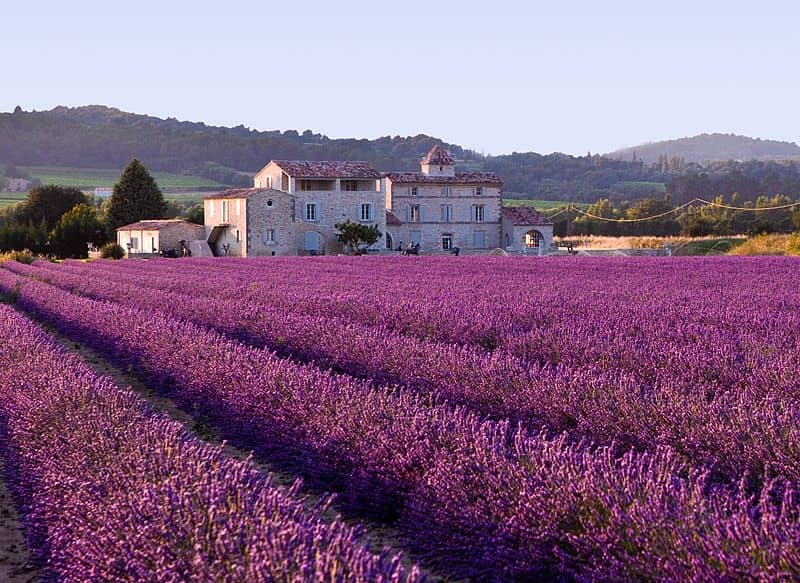
If you are looking for things to do in Provence, visiting the lavender fields should be at the top of your itinerary.
Provence is famous for its vast lavender fields , making France second only to Bulgaria in lavender oil production. The fields in the Luberon district around Gordes are the most popular in Provence.
Also, don’t miss the Lavender Museum to learn everything there is to know about lavender.
Read: Best Lavender Fields In France
Formed some 12,000 years ago when warming after the ice ages made the sea rise and flood the valleys, the Massif des Calanques is a true wonder of nature. Its series of inlets stretches from Marseille to Cassis .
The Calanques’ pebble and fine sand beaches, small creeks, and turquoise water make it an excellent place to enjoy water sports or just lounge around and take in the breathtaking seabed and landscape.
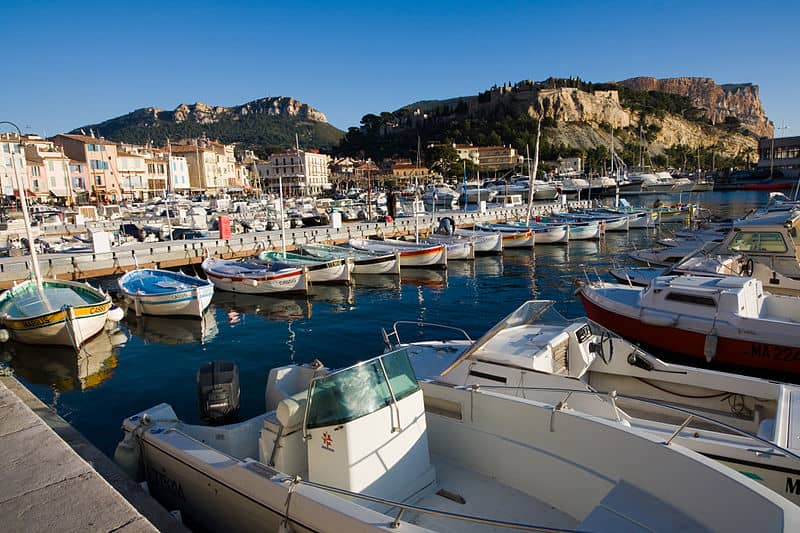
Situated right at the foot of the Cap Canaille cliff, Cassis is a good access point to the Calanques.
This seaside resort is a great place to spend some time swimming on the sandy beach just outside the port, dining at one of the port side restaurants, or just simply watching locals play a game of boules called pétanque .
Montagne Sainte-Victoire, a limestone mountain ridge in Vauvenargues, between Var and Bouches-du-Rhône, is famed for its many appearances in Paul Cézanne’s paintings .
Saint-Victoire is a popular destination for hiking, climbing, paragliding, and caving.
Flanked by the towns of Castellane and Moustiers-Sainte-Marie in central Provence, the Gorges du Verdon is a dramatically stunning river canyon made even more beautiful by the combination of Alpine’s best and the Mediterranean terrain.
Its white-water rapids and cliffs are perfect for mountain biking, paragliding, rock climbing, slacklining, kayaking, and rafting.
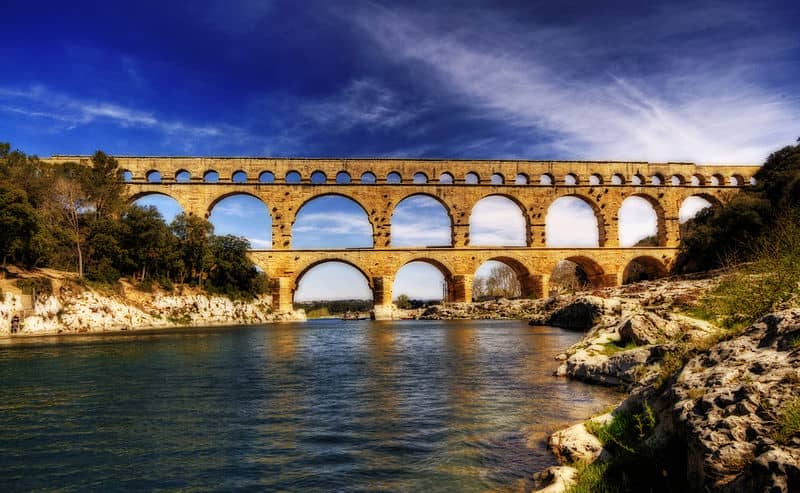
The Pont du Gard, a Roman aqueduct bridge built in the 1st century AD to carry water, crosses the river Gardon near Vers-Pont-du-Gard. It’s one of the popular historic monuments in France and one of the must-visit places in Provence.
A UNESCO World Heritage site, it is not only the highest of all Roman aqueduct bridges but also among the best preserved. If you are visiting the region, this is one of the must-see attractions in Provence.
Gordes and Les Baux-de-Provence are Provençal medieval towns deemed among the most beautiful in France , with millions of people visiting each year.
Gordes is tiny but fun to stroll around, complete with local spas and an ice-cream parlor.
Les Baux-de-Provence, on the other hand, offers stunning panoramic views as it’s perched smugly on a hillside.
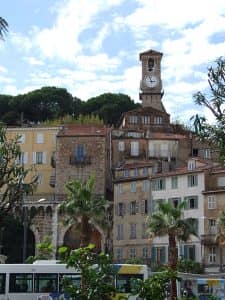
The old fishing village of Le Suquet in the district of Cannes boasts of candy-colored fishermen’s cottages and yacht-filled marina, with Marché Forville’s food stalls and steep cobbled alleys.
The place is teeming with so much charm that since the influx of British aristocrats, Le Suquet has kept attracting even more people.
St. Tropez is a charming old town in the French Riviera . Famous for its exclusive private beach clubs, back in the day it was a quiet fishing village.
Public beaches are aplenty and one of the best ones for walking along and taking in the view is the Plage de Bouillabaisse which is just outside the village harbor.

A visit to Marseille is not complete without Le Panier, the city’s oldest district, and major attraction. Le Panier, literally meaning “the basket,” sits on a hill in central Marseille.
Walk around the narrow streets, shop at traditional Arab souks, and grab a bite at an Algerian restaurant or sample the Marseille seafood stew – bouillabaisse – at a waterfront restaurant in the Vieux Port (Old Port).
Cimiez was founded by the Romans on a hill above the city of Nice and the remains of the grandiosity of the place can still be seen today.
For a high dose of art and history, take a peek into the ancient Roman amphitheater, explore the Cimiez Gardens, and visit Musée Matisse.
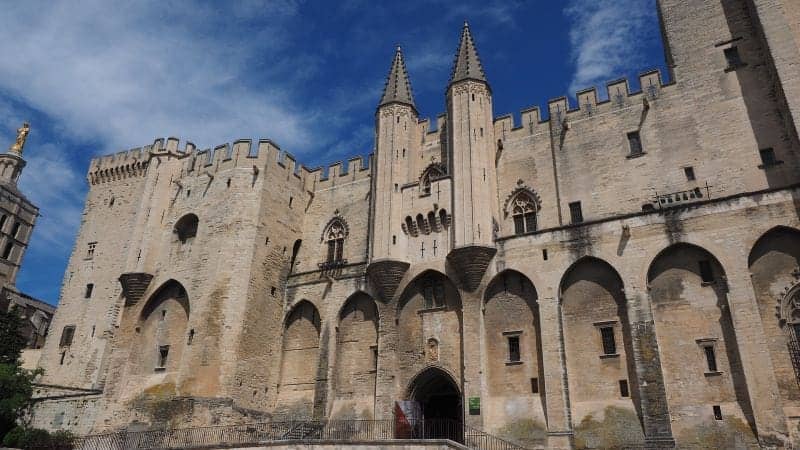
The Palais des Papes (Palace of the Popes) in Avignon is one of the largest and most important medieval Gothic buildings in Europe. It is also one the best historic places to visit in Provence.
Once a fortress and palace, it became the residence of several popes after the civil and religious unrest in Rome in the 14th century.
The Palais Longchamp is a monument in Marseille , which houses the Musée des Beaux-arts and Muséum d’Histoire Naturelle de Marseille.
The surrounding Parc Longchamp (Longchamp Park), listed as one of the Notable Gardens of France , features a classic French garden called the Jardin du Plateau.

The Château d’If is a small island fortress offshore from Marseille – and it’s a popular day trip from the city . It is also a former prison famous for being one of the settings of The Count of Monte Cristo by Alexandre Dumas.
If you’re looking for interesting to see while in Provence, Château d’If is a must.
This Cistercian abbey near Gordes was founded in 1148. A small community of monks still live there today, welcoming visitors and harvesting lavender.
A visit to the Sénanque Abbey is a must when you’re in Provence.

Dubbed the “City of the Thousand Fountains,” Aix-en-Provence ‘s fountains are literally a thousand! Everywhere you look, a fountain will fill your eyes. Go and try to count them all!
Raw and well-preserved, the Côte Bleue (Blue Coast) lies on the stretch of Mediterranean shore between the Camargue and Marseille. It is ideal for walking, hiking, and swimming. It also offers diving and other water sports.

Provence is known for its sultry summers, lush countryside, and great food. Provence may not close to any major cities, but it is one of the best French wine regions to explore .
Provence has been producing several varieties of rosé wine such as the Chateauneuf-du-Pape and Beaumes de Venise for more than 2,600 years. Be sure to sample some while you are in Cassis and Bandol as it’s one of the fun things to do in Provence.
Renowned for its artisanal olive oil and fragrant soap products sold throughout France, Salon-de-Provence has a soap factory and museum dedicated to soap.
You can visit and buy soap at the Marius Fabre Soap Factory and learn about the history of soap production at the Savon de Marseille Museum.
20. Visit Grasse for gardens and perfumes

If you’re looking for something different to do in Provence, a visit to one of its perfumeries is a must.
Known as the perfume capital of the world, the old town of Grasse delights all the senses.
It boasts of hills and plains flourishing with jasmine, lavender, mimosa, orange blossoms, and other flowers that are essential in making delicate fragrances.
Learn about the history of perfumes , soaps, and cosmetics at the Musée International de la Parfumerie and tour the famous perfume factories such as Galimard, Fragonard, and Molinard.
Travel Insurance: I never leave home without travel insurance. My personal opinion is if you can afford to travel, you can afford to buy a travel insurance. All things can happen while on the road and you can never be too sure. And it's something that you'll be glad to have when you need it. For my preferred travel insurance, I use Safety Wing .
What To Wear: If you want some ideas on what to pack for France, check out this packing list guide for France .
Where To Stay: I personally use Booking.com for all my accommodations. Check out for their latest deals here .
Reading Resources: Check out our best reading resources here .
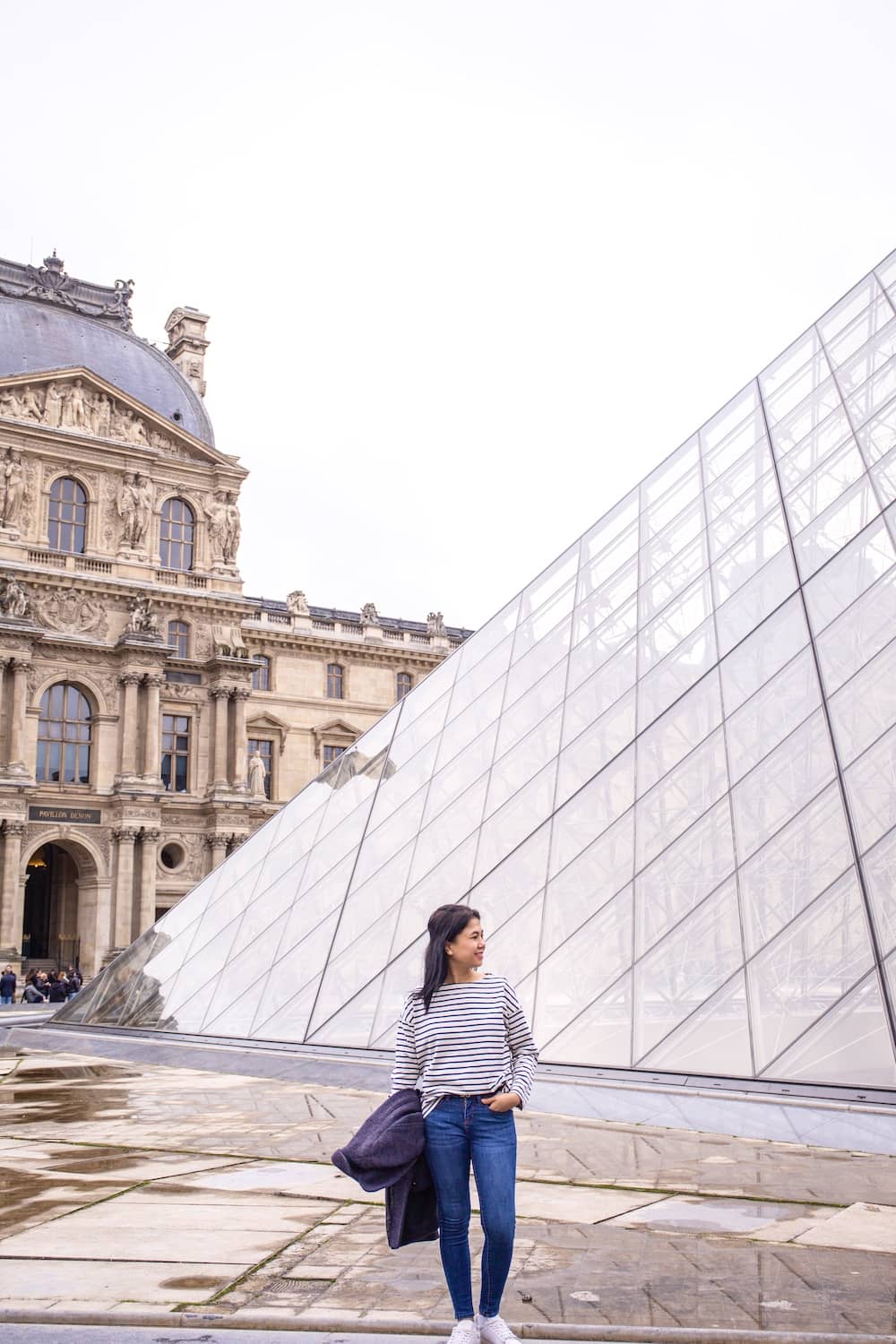
Hi, I’m Christine – a full-time traveler and career woman. Although I’m from the Philippines, my location independent career took me to over 40 countries and lived in 4 continents in the last 10 years, including France. A self-proclaimed Francophile, I love everything France.
Sharing is caring!
11 Fun Things To Do In Paris At Night - Journey To France
Sunday 2nd of January 2022
[…] France is the birthplace of many of the world’s most famous wines. When it comes to drinking, you’re spoiled for choice between the wines of Bordeaux, the reds of Burgundy, and the crisp rosés of Provence. […]
11 Best Things To Do In Grasse, France - Journey To France
Thursday 9th of December 2021
[…] find out where to go and visit the magnificent lavender fields, visit the Provence website for the road map. You can also visit the lavender museum, and certain distilleries and […]
France in April: Weather, Things to See and Travel Tips - Journey To France
Monday 6th of December 2021
[…] the best of France from the gastronomic delights in Lyon to the sultry Provence countryside down to the Mediterranean […]
11 Most Popular French Breads To Try In France - Journey To France
Monday 15th of November 2021
[…] is a flatbread typically associated with Provence but its origin goes way back to ancient Rome. No wonder it’s so similar to Italian […]
France in May: Weather, Things to See and Travel Tips - Journey To France
Sunday 25th of July 2021
[…] coast also encompasses the micro-state of Monaco and the region of Provence, which are fantastic places to explore before the weather gets too […]
- Skip to primary navigation
- Skip to main content
- Skip to primary sidebar
- Skip to footer
TravelAwaits
Our mission is to serve the 50+ traveler who's ready to cross a few items off their bucket list.
13 Incredible Things to Do in Provence, France

Fesus Robert / Shutterstock
- Destinations
Note: The Travel Awaits team regularly updates content to provide the latest, and most accurate information to our readers. The updated content in this article may not reflect the views or opinions of the original author.
Provence. I’m sure you have heard of it. Lavender fields, the Mediterranean Sea, hilltop ancient villages, and a landscape dotted with vineyards, orchards, and farmland. Provence is part of a large region in France named Provence-Alpes-Cote d’Azur.
Falling for Provence France and its charming, relaxed lifestyle is not hard. Long lazy lunches on shady terraces overlooking the sea, olive trees, cicadas chirping, a hot summer sun, and brilliant blue skies are just part of the reason you’ll be falling in love with Provence, France. Here are 11 reasons that I adore this region of France.
13 Amazing Things to Do in Provence, France
1. hill towns of the luberon.

Corentin / Shutterstock
The hills towns of the Luberon are the perfect place to fall for Provence, France . The Luberon consists of three mountain ranges, and located in the valleys, plateaus, and hilltops are marvelous, unspoiled medieval villages.
There are many villages to visit, but two of my favorites are Gordes and Roussillon. Gordes, perched on a cliff cascading down the hillside, and Roussillon with its ochre landscapes and pine trees are both unforgettable. Plan to hike the Ochre Trail (Sentier des Ocres) in Roussillon.
Pro Tip: Base yourself in Avignon if you want to spend time exploring the hill towns of the Luberon or, better still, stay in Gordes at La Bastide , with its sweeping views over the Luberon.
Explore hotels and Airbnbs near Hill Towns Of The Luberon
2. Lavender Fields Of Provence, France

Francois Roux / Shutterstock
The experience of standing amidst row upon row of purple lavender blooms, their delicate and familiar scent wafting across the breeze, is pure Provence magic. Purple fields endlessly stretch towards distant mountains, with the odd cypress tree posing, making for some magnificent photo opportunities. Valensole is the ultimate place to see lavender fields, but they dot the summer landscape in Provence and can be found in the Luberon and the Sault Plateau as well.
Pro Tip: Early July is the best time to plan your visit to the lavender fields of Provence, France. As can be expected, the climate plays a role each year in the optimal time to see the lavender blooming. Here is our list of the most beautiful lavender fields to visit in the area !
Explore hotels and Airbnbs near Lavender Fields Of Provence, France
3. The Seaside Town Of Cassis, France

Delpixel / Shutterstock
Cassis, also known by its nickname “Little Saint Tropez,” is seaside perfection. Sailboats bob in the harbor against a backdrop of colorful awnings, fishers unload their daily catch, and quayside cafes display their chalkboard menus. Tall shuttered houses painted in faded pastel colors line narrow cobblestone streets perfect for exploring. Peruse the fabulous Wednesday and Friday markets to stock up on local delicacies. Spend an afternoon at Bestouan Beach to relax, dip in the Mediterranean Sea and soak up the sun. Top off the day sitting at a cafe and partaking in fresh mussels and the local white Cassis wine.
Pro Tip: La Villa Madie , a double-starred Michelin restaurant, has magnificent food along with spectacular views over the Mediterranean.
Explore hotels and Airbnbs near The Seaside Town Of Cassis, France
4. The Calanques In Provence, France

Gaspar Janos / Shutterstock
Picture this. Soaring white limestone cliffs carved uniquely by the elements. The blue waters of the Mediterranean slipping down the narrow inlets between the cliffs.
The Massif des Calanques is an exceptional, rugged terrain positioned between Marseille and Cassis. One of the best ways to experience the Calanques is to take a boat tour from Marseille, Cassis, or la Ciotat. During peak season, the guided boat tours leave regularly, taking you across the sparkling salty water and past the towering cliffs and inlets. The vista is remarkable.
Another way to see the Calanques is by kayaking or hiking. It is highly recommended to take a guided kayaking tour. The hiking trails are rugged, so it is best to wear hiking boots or solid footwear. The views are spectacular from the top of the cliffs, and the opportunity to swim and picnic along the inlets is unforgettable. As you can see, Aix-en-Provence offers a lot of things that you can do .
Pro Tip: The hiking trails are usually closed to the public in the summer due to the risk of forest fires in the intense dry heat. I hiked from Cassis in the third week of June and the trails were still open.
Explore hotels and Airbnbs near The Calanques In Provence, France
5. The Markets At Aix-En-Provence

RossHelen / Shutterstock
There is a daily market in Aix-en-Provence in Place Richelme that is well worth a stop if you stay at an Airbnb and plan on cooking. The Saturday market down Cours Mirabeau is one that shouldn’t be missed. Le Cours Mirabeau is lined with stalls selling clothing, and textiles such as unique throw blankets, purses, jewelry, lavender honey, and unique Provencal goodies. Allow yourself plenty of browsing time, and be sure to leave some extra space in your suitcase for your treasures.
Pro Tip: Hotel Le Piggonet is the perfect place to stay with its views of Saint-Victoire, large gardens, and spa.
Explore hotels and Airbnbs near Aix-En-Provence
6. The Notre-Dame Of Senanque Abbey

ventdusud / Shutterstock
You could easily miss this Abbey if you didn’t know about it! Notre-Dame of Senanque Abbey is secluded in a valley nestled into the side of an enormous hill. This Cistercian monastery was founded in 1148, and still to this day, monks live here praying seven times a day. The monastery is framed with lavender fields, making it another picture-perfect destination in Provence, France.
The Abbey is open to guided tours (only in French) and self-guided tours in eight different languages. Tours include the abbey church, the old dormitory, the cloister, and the chapter room.
Pro Tip: Plan a visit to Notre-Dame of Senanque Abbey with your trip to Gordes. Follow the signs from Gordes and wind along the narrow road for 2.5 miles. Notre-Dame of Senanque Abbey is well worth the side trip.
Explore hotels and Airbnbs near The Notre-Dame Of Senanque Abbey
7. Moustiers-Sainte-Marie

Rolf E. Staerk / Shutterstock
Moustiers-Sainte-Marie , designated as one of the most beautiful villages in France, is situated between towering limestone mountains. Strung between those two mountains is a star on a chain. The legend of this hanging star dates all the way back to the Crusades. Explore the cobbled streets of Moustiers-Sainte-Marie, marvel at the waterfall flowing in the center of the village, and admire the locally made ceramics ( faiences ). Climb the 262 steps up to the Chapel Notre-Dame-de-Beauvoir perched on the top of a cliff watching over the town. The sweeping views over the countryside are magnificent.
Pro Tip: La Bastide de Moustiers is a Michelin-starred restaurant and hotel situated in Moustiers-Sainte-Marie.
Explore hotels and Airbnbs near Moustiers-Sainte-Marie
8. The Gorges Du Verdon

JFFotografie / Shutterstock
The water’s turquoise color is enough to add the Gorges du Verdon to any itinerary through Provence, France. The aquamarine water flowing at the bottom of the Gorge is a color unlike any other. Driving past, there are places to park and stand in awe at the natural landscape but preferably plan to spend a few hours exploring. Rent a kayak, canoe, or paddleboat and experience this stunning location up close and personal. Let the water trickle through your fingers, have a picnic on the rocky shore, and watch the local youngsters cliff jumping.
Pro Tip: This is an area for all outdoor enthusiasts. There are hiking trails, stand-up paddleboards, and also paragliding.
Explore hotels and Airbnbs near The Gorges Du Verdon
9. Enjoy Provencal Cuisine
The cuisine of Provence is very Mediterranean in style and flavor. Look for tapenade, a dip made with olives, capers, anchovies, and garlic. Fougasse, an Italian-style flatbread, usually comes stuffed with olives and herbs of Provence. Bouillabaisse, which originates in Marseille, is a delicious fish and seafood stew. Nougat filled with honey, sugar, almonds, and egg whites is a local specialty found in the stores and markets. Don’t forget to try lavender ice cream. Yes, it’s purple!
Pro Tip: Le Formal – Les Caves Henri IV is the place to go if you are looking for gastronomic delights in Aix-en-Provence.
Explore hotels and Airbnbs near Provence, France
10. Drink Rose Wine In Provence, France

barmalini / Shutterstock
With Provence being the main producer of rose wine in France, it seems just right to sit at a seaside cafe or a hilltop restaurant with the summer sun beating down and sip a glass of chilled local rose wine. Provencal rose comes in a variety of hues ranging from salmon pink to peach to cantaloupe. Crisp, fruity, floral, or savory, Provencal wine surprises with its flavor.
Pro Tip: Rose is quite affordable. If buying rose in Provence, look for gold, silver, or bronze “Vins de Provence le Concours” stickers on the bottles.
11. Follow Van Gogh’s and Cezanne’s Footsteps In Aix-En-Provence
Vincent Van Gogh ‘s years in Aix-en-Provence were prolific and tumultuous. Inspired by the region’s vibrant colors, he painted iconic works like “Starry Night Over the Rhône” and “Sunflowers.” Despite struggles with mental health, he found solace in Arles, creating masterpieces amidst inner turmoil. His time here remains a testament to artistic passion and perseverance.
Paul Cezanne was born in Aix-en-Provence, and the city is most proud of this father of modern painting. Atelier de Cezanne (Cezanne’s workshop) on Chemin des Lauves has been left much as it was when he died in 1906. Easels are still standing along with his studio coat and hat. Book in advance to visit this studio.
Walk up the hill from Cezanne’s workshop to the open-air gallery where nine reproductions of his painting are displayed. In this exact spot, Cezanne painted his beloved mountain Mont Sainte-Victoire in at least 28 paintings.
For more of Paul Cezanne, visit the Granet Museum in Aix-en-Provence.
Pro Tip: Keep an eye open for the studs on the sidewalks marked with a “C” and Cezanne’s name. They indicate locations in the city where he lived and went to school.
Explore hotels and Airbnbs near Aix-en-Provence
12. The Medieval Town of Avignon
Avignon is most famous for its old city clustered within impressive medieval walls. Moreover, the whole old center of Avignon is a UNESCO world heritage site. The most important monuments are the Palais des Papes , or the Pope’s Palace, one of the most important medieval Gothic buildings of Europe, and the Calvet Museum, the heart of the cultural offer in Avignon.
There is also the famous “ Pont d’Avignon “, the remnants of a medieval bridge across the Rhône, which has become a tourist attraction, and perhaps the most famous thing to see in this part of Provence.
Pro Tip: The ruins of the castle of Villeneuve d’Avignon across the river are worth a visit.
Explore hotels and Airbnbs near The Medieval Town of Avignon
13. Roman Provence
This region was the first Roman province outside of today’s Italy. The region’s economic and artistic life flourished under the Roman administration. The towns of Orange, Arles, Nimes, Orange, Vaison la Romaine, and Fréjus are the best places in Provence to see magnificent remains of Roman arenas, amphitheaters, spas, and villas. Pro Tip: Don’t miss a visit to the Roman Aqueduct of Gard and the visit to Glanum , the most complete ancient archeological complex in France located outside Saint-Rémy.
Explore hotels and Airbnbs near Roman Provence
Why Visit Provence?
Provence region in Southern France is known for its medieval hilltop villages and little towns in Les Baux de Provence, local cuisine, rosé wines, and olive groves, and is most beautiful in the lavender season. The French Riviera and Provence are some of France’s most glamorous and visited destinations.
How Many Days in Provence Is Enough?
A few days are enough to see Aix, Palais des Papes in Avignon, and Calanques National Park, while a full week will allow time to see more towns, Roman ruins, famous lavender fields, and perhaps Le Parc National des Calanques.
What Are the Borders of Provence?
Provence begins in the Mediterranean in the South of France and stretches from the Italian border in the east to the bank of the Rhône River in the west, although the definition of Provence’s borders will change depending on who you’re talking to.
Where Is the Best to Stay When You Visit Provence?
Aix is the best city to stay when visiting Provence if you want to see everything the region has to offer. It’s only around an hour’s drive to the Camargue, Avignon, the Luberon region, the rural commune of Les Baux de Provence, and the dramatic limestone cliffs of Verdon Gorge.
Where Can I See the Van Gogh Sites in Provence?
You can follow in Vincent Van Gogh’s footsteps in Arles and Saint-Remy-de-Provence, where Vincent Van Gogh spent most of his 2.5 years in France. He was inspired by the region’s scenic fields of flowers that stand out against the blue sky.

Alison Browne, a modern-day nomad, landed in Paris after exploring the world as a solo traveler. She shares her travel stories and best tips at Dreamer at Heart . Six years ago, she wrapped up her career as an elementary school teacher and set out to explore new destinations and connect with people of different cultures. Her curious spirit has led her to travel throughout Europe, Asia, South East Asia, and Central and South America. France kept calling her back and she listened. Now based in Paris, Alison spends her time exploring the City of Light and writing about her adventures. La vie est belle! Find her on Instagram!
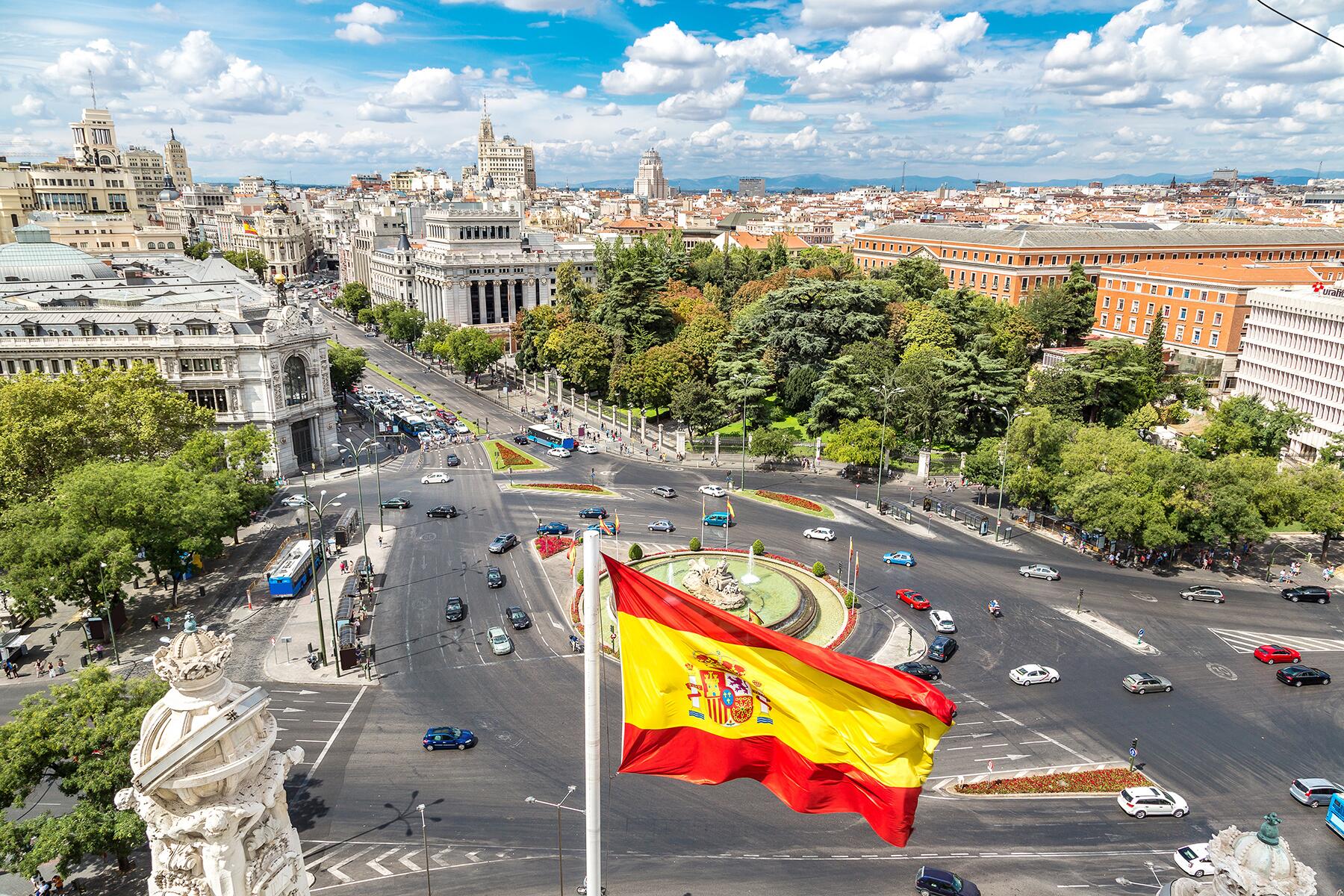
Log in with user name:
Log in with social media:
Get FREE email communications from Fodor's Travel, covering must-see travel destinations, expert trip planning advice, and travel inspiration to fuel your passion.
- Things To Do
- Restaurants
- Travel Tips
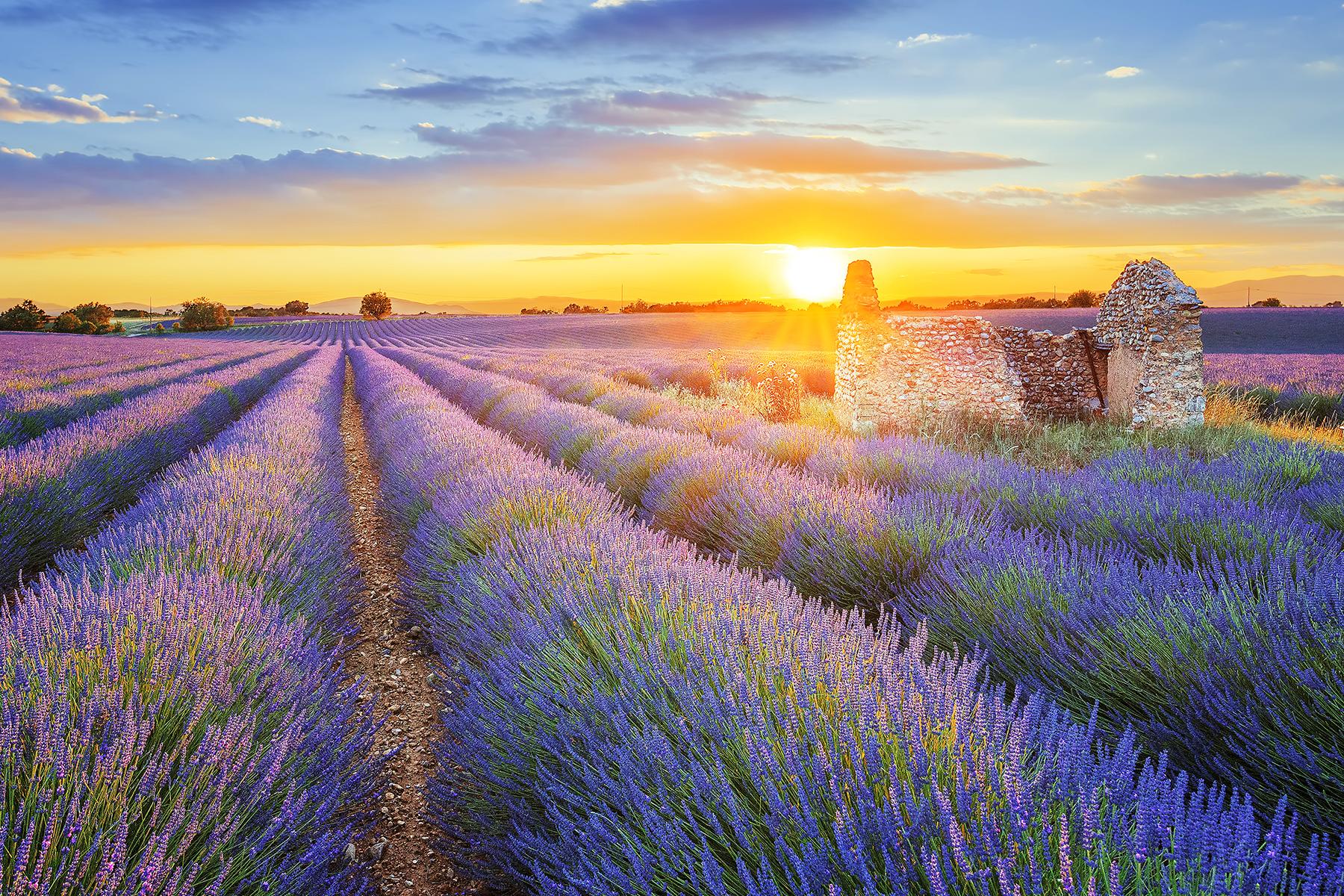
15 Picture-Perfect Towns in Provence, France
The secret is out on Provence, and the area has always been a well-known spot for celebrity vacationers, but there’s still plenty that’s slightly off the beaten track.
Provence is a region full of sensory romance, rewarding travelers with its breathtaking vistas, mouthwatering cuisine, and small-town tranquility. Blossoming lavender fields and ripe olive groves highlighting medieval hilltop villages set a picture-perfect scene in the French region. While the celebrated cities of Aix-en-Provence and Avignon captivate the senses with their Roman architecture and cultural venues, it’s the smaller lesser-known towns boasting winding lanes leading to local bistros with breathtaking vistas that best represent the soul of the south of France. Here are the best towns to visit in Provence.
WHEN IS THE BEST TIME TO GO TO PROVENCE? An idyllic climate with over 300 days of sunshine a year, the best time to visit this vibrant Provençal landscape is during the spring and summer months.
Need a place to stay while you’re visiting? We’ve got hotel recommendations for you .
Please note that the COVID pandemic is ongoing and restrictions may be in place in Rome. Visit the U.S. State Department website , to get the latest advice and information.
Top Picks for You

No longer a true hidden gem, Cassis still offers a pleasant respite from Provence’s more popular port cities with its dramatic seaside setting, framed by the imposing white cliffs and the series of calanques (narrow inlets) tucked among them. Winemaking is now the primary activity in the region, but Cassis has maintained its idyllic fishing village vibe, with pastel-colored buildings lining the harbor. Be sure to sample the local specialty, a very particularly prepared bouillabaisse, before you leave.
Related: 9 Exquisite Places to Luxuriate in Provence, France
Les Baux de Provence
Perched on top of a natural plateau in the heart of the Alpilles where it boasted a strategic historical position, Les Baux de Provence is often considered one of the most picturesque Provençal villages. With 22 listed monuments to discover by foot, most notably the Château des Baux, its narrow cobbled streets and terraced squares date back to medieval times. At the foot of the village, the limestone quarries of Carrières de Lumières put on an impressive light show featuring exhibits by world-renowned artists.
Recommended Fodor’s Video
Often listed as one of the most beautiful villages in France, Gordes is a charming mix of sleepy French hillside village and posh resort town. The area is a favorite among celebrities as a quiet summer retreat, but the atmosphere is still unpretentious. The idyllic setting is dominated by the fortress standing guard over the city—a Roman foundation that was significantly renovated during the Renaissance. Now, the fortress houses an art museum.
Be sure to look down every tiny alleyway as you stroll through Gordes, as some of the best views of the countryside can be glimpsed through the narrow corridors leading out from the city center. Make sure not to miss Abbaye de Sénanque just outside the city, where monks still live and produce local honey and liqueurs.
Saint-Rémy-de-Provence
If the gently rolling wheat fields and gnarled olive groves surrounding Saint-Rémy-de-Provence look familiar, don’t be surprised; Van Gogh spent a year here during one of his more productive periods, during which he composed Starry Night among other famous works. After perusing the town’s surprisingly cosmopolitan boutiques and eateries, venture further afield to explore the nearby ruins of Glanum , a Celtic-Roman city with an intact triumphal arch dating back to the first century B.C.
Porquerolles
White sandy beaches, ragged cliffs, and crystalline waters lend Îles d’Hyères , a chain of four islands off the coast of Var, a vaguely Caribbean vibe. Porquerolles is the largest and has some of the best beaches in all of Provence on the island’s less rugged north shore. Porquerolles’ small village is brand-new compared to most of Provence; constructed in the 19th century, it has an atmosphere more akin to an Italian port town than a hillside Roman village. Purchased from a private owner in the 1970s, Porquerolles is a protected development area, so its natural beauty has been left blissfully untamed.
At sunset, the village of Roussillon practically glows, its fiery red and orange buildings lighting up the surrounding landscape. Its unique color palette—most Provencal towns are a study in sandy beiges and creamy whites—is due to the large ocher clay deposits in the vicinity. While Provence is known for its fertile landscape, the area surrounding Roussillon is a pleasant change of pace with its stark red cliffs and dramatic canyons. Grab a seat at one of the tiny sidewalk cafes and admire the town’s vibrant architecture.
Few places in Provence feel further removed from the well-trod tourist path than Le Barroux . The tiny village is seemingly one giant looping street, with impossibly narrow alleyways punctuated by mint green and robin’s egg blue shutters and window flower boxes hanging from the rugged stone facades. The Château du Barroux , from the 12th century, sits precariously on the top of a hill with the town circling its base, before giving way to sweeping vineyards and olive groves on all sides. On a sunny day, you can see Mont Ventoux in the distance. After a stroll through the sun-kissed streets, where you’ll encounter gurgling fountains at every turn, head to Entre’ Potes for fantastically prepared Provençal food.
Vaison-la-Romaine
It wasn’t the Romans but the Celts who were the first people to settle this picturesque hill in the Vaucluse department. Today, Vaison-la-Romaine is a charming mix of the old and new, with the steep medieval-era streets leading up to the Colline de Chateau on the south side of Ouvèze River. Over the Pont Romain , dating back to the first century, you’ll find the older, original Roman settlements and the bulk of the town packed with al fresco cafes and shops selling the region’s lavender and olive-based products. Ruins of an original Roman villa and theater can be seen just outside the city center.
For a town of fewer than 2,000, Ménerbes has experienced its fair share of brushes with fame. A number of quasi-celebrities, from one of Picasso’s models to high-profile English businessmen, settled in the otherwise forgotten village in the middle of the 20th century, before Ménerbes was put back on the map by Peter Mayle’s writing (it was the setting in A Good Year and appeared in his other works). The charming village, whose sand-colored buildings seem to disappear into the leafy landscape, is dominated by the Protestant-built citadel, a remnant from Ménerbes’ time as an important Protestant stronghold during the French Wars of Religion.
Secreted away in the Gard department west of the Rhone River, Uzès is a hidden-in-plain-sight gem with as much authenticity as you’ll find anywhere in the dozens of small towns scattered over the Provence region. The village was at different points a Roman settlement, a Jewish enclave, a bishopric, and a dukedom, evidence of which can be found in the stately homes, chateaux, and 17th-century chapel still preserved in the city center. A mid-century investment from the French government turned the town into a secretly hip hamlet, where many expats now own homes, but the atmosphere is still entirely French. Don’t miss the Sunday market, one of the best in Provence.
Unlike the hilltop villages that draw in thousands of tourists each year in the Luberon, Lourmarin unassumingly resides on a plain, where olive groves, vineyards, and almond trees act as the natural barrier for this picturesque town. Don’t let the low stature fool you; Lourmarin is often regarded as one of the most beautiful villages in Provence. The village has attracted numerous illustrious figures over the years, including Winston Churchill and Albert Camus, but it was resident writer Henri Bosco that famously wrote of his home village, “This land has taken root in me…”
INSIDER TIP Book a table at La Bastide de Capelongue to experience the village’s celebrated two Michelin Star dining.
This medieval town has been inhabited since the Neolithic Age, protected by a series of ancient ramparts that still stand today beneath this hilltop village. Venasque has become famous for its exceptional cherry crop, and everywhere throughout France the designation “Monts de Venasque” indicates flawless fruit grown under ideal conditions. The Roman walls and the baptistery found within this village are must-see sights, but don’t pass up the chance to see Venasque’s beloved Crucifixion painting within the Notre Dame de Venasque church. The town won the painting back when the Louvre in Paris borrowed it and forgot to return it to the village.
L’Isle-sur-la-Sorgue
Situated serenely on the banks of the Sorgue River, this town is a shopper’s paradise, only instead of shopping malls and boutiques, visitors are met with fabulous antique stores and bustling weekend markets. Wake up early to stroll along the more than 300 stalls at the famous Sunday market at L’Isle-sur-la-Sorgue when it opens at 8 a.m., before taking an early lunch at Café Fleurs to enjoy a glass of rose beneath the café’s shaded terrace. Don’t miss the floating market if you’re in town during the first Sunday of August, when locals sell their wines and wares from traditional “nego-chin” boats.
There’s only one road in and one road out to this hidden gem within Provence’s Petit Luberon. Tiny roads meander through the village where outdoor tables mark the entrances of cafes and colorful window boxes filled with flowers greet guests into the shops owned by local families. A short walk up from the famous Café de la Poste puts you in Old Goult, where many buildings were carved out of the rocky hill itself, and finally up to the iconic Goult windmill and the perfect spot for taking in the gorgeous scenery.
Old stone houses made from ochre limestone are just the first pages of this storybook village. As you walk deeper through the streets, history unfolds to reveal medieval architecture and the town’s famous 11th-century chateau that soon became home to some infamous characters. The chateau in Lacoste provided refuge for “the father of eroticism” Marquis de Sade. Today its designer M. Pierre Cardin that calls the chateau home, after an extensive renovation that brought this ancient edifice into the modern age.
Provence Travel Guide
Book your individual trip, stress-free with local travel experts
- roughguides.com
Book your individual trip , stress-free with local travel experts
- Travel guide
- Itineraries
- Local Experts
- Travel Advice
- Accommodation
Plan your tailor-made trip with a local expert
Book securely with money-back guarantee
Travel stress-free with local assistance and 24/7 support
My niece and I attended this terrific workshop. We learned a lot and had tons of fun. The bread and pastries were amazing. It was great to get behind the s...
Arguably the most irresistible region in France, Provence ranges from the snow-capped mountains of the southern Alps to the delta plains of the Camargue, and boasts Europe’s greatest canyon, the Gorges du Verdon. Fortified towns guard its ancient borders; countless villages perch defensively on hilltops; and great cities like Arles, Aix and Avignon are full of cultural glories. The sensual inducements of Provence include sunshine, food and wine, and the heady perfumes of Mediterranean vegetation. Small wonder it has for so long attracted the rich and famous, the artistic and reclusive, and throngs of summer visitors.
Central Provence
Northeast provence, provençal food and drink.
The Mediterranean shoreline of Provence is covered separately in our Côte d’Azur guide. Away from the coastal resorts, inland Provence remains remarkably unscathed. Evidence of its many inhabitants – Greeks, Romans, raiding Saracens, schismatic popes, and an endless succession of competing counts and princes – remains everywhere apparent. Provence only became fully integrated into France in the nineteenth century and, though just a tiny minority speak the Provençal language, the accent is distinctive even to a foreign ear. In the east, the rhythms of speech become clearly Italian.
The main difficulty in visiting Provence is choosing where to go. In the west, along the Rhône valley, are the Roman cities of Orange , Vaison-la-Romaine and Arles , and the papal city of Avignon , with its fantastic summer festival. Aix-en-Provence , the mini-Paris of the region, was home to Cézanne, for whom the Mont Ste-Victoire was an enduring subject, while Van Gogh is forever linked with St-Rémy and Arles. The Gorges du Verdon , the Parc National du Mercantour along the Italian border, Mont Ventoux northeast of Carpentras, and the flamingo-filled lagoons of the Camargue offer stunning and widely disparate landscapes. And if you are wondering where to see the famous lavender fields, check out our guide for the best lavender field locations .
Tailor-made travel itineraries for France, created by local experts

14 days / from 3860 USD
An active walking tour out of the way in France
Your trip starts with an in-depth introduction to France in Paris: several unique day excursions connect you with local Parisians to show you their city and way of life. Afterwards continue south to start a few days walking journey through Southern France before ending around Avignon.

10 days / from 2411 USD
Southern France – Walks in the Alpilles and Lavender fields
Start your tour in the coastal city of Marseille, exploring Cassis on the way. Around the Alpilles in Provence, you will be provided with detailed walking materials to explore the area on foot, from both Les Baux and St Remy. End your tour in famous Avignon.

12 days / from 2948 USD
Tasting Eastern France
A delicious yet active journey through Eastern France. Start your trip in Lyon with some unique food tours before setting off on a 4-day walk across the Beaujolais region. Almost every day ends with a wine tasting in your guesthouse, soothing for body and soul.
In central Provence , it’s the landscapes rather than the towns that dominate. The gentle hills and tranquil villages of the Haut-Var make for happy exploration by car or bike, before the foothills of the Alps close in around the citadelle town of Sisteron and Dignes-les-Bains further east.
The most exceptional geographical feature is the Gorges du Verdon – Europe’s answer to the Grand Canyon. So long as you have your own transport, good bases for exploring the majestic peaks, cliffs and lakes of this spectacular area include the small market town of Aups , south of the Gorges, and to the northeast, Castellane , a centre for sports and activities.
The Gorges du Verdon
The breathtaking beauty and majesty of the Gorges du Verdon , also known as the Grand Canyon du Verdon, almost match its American counterpart, albeit on a much smaller scale. Peppered with spectacular viewpoints, plunging crevices up to 700m deep, and glorious azure-blue lakes, the area is absolutely irresistible; try not to leave Provence without spending at least a day here. The river falls from Rougon at the top of the gorge, disappearing into tunnels, decelerating for shallow, languid moments and finally exiting in full, steady flow at the Pont du Galetas ,at the western end of the canyon. Alongside is the huge artificial Lac de Sainte-Croix , which is great for swimming when the water levels are high; otherwise the beach becomes a bit sludgy.
With so many hairpin bends and twisting, narrow roads, it takes a full, rather exhausting day to drive right round the Gorges. Many visitors choose instead to trace either its north or south rim. The entire circuit being 130km long, this is cycling country only for the preternaturally fit.
Local outfitters and guides offer activities including climbing, rafting, canoeing, canyoning, cycling and horseriding.
Depending on the season, the northeastern corner of Provence can be two different worlds. In winter, the sheep and shepherds find warmer pastures, leaving the snowy heights to horned mouflons, chamois and the perfectly camouflaged ermine. The villages where shepherds came to summer markets are battened down for the long, cold haul, while modern conglomerations of Swiss-style chalet houses, sports shops and nightclubs come to life around the ski lifts. The seasonal dichotomy is especially evident in towns like Colmars-les-Alpes and Barcelonnette .
The Alpes-Maritimes make up much of northeastern Provence, encompassing much of the magnificent Parc National du Mercantour , which runs south of Barcelonnette to the Italian border villages of Tende, Breil-sur-Roya and Sospel.
Exploring the Vallée des Merveilles
The first recorded visitor to stumble on the Vallée des Merveilles , a fifteenth-century traveller who had lost his way, described it as “an infernal place with figures of the devil and thousands of demons scratched on the rocks”. That’s a pretty accurate description, except that some of the carvings are of animals, tools, people working and mysterious symbols, dated to some time in the second millennium BC.
The valley is best approached from ST-DALMAS-DE-TENDE , 4km south of Tende. The easiest route is the 10km hike (6–8hr there and back) that starts at Les Mesches Refuge , 8km west on the D91. The engravings are beyond the Refuge des Merveilles . Note that certain areas are out of bounds unless accompanied by an official guide – and remember that blue skies and sun can quickly turn into violent hailstorms and lightning, so go prepared, properly shod and clothed, and take your own food and water. For details of guided walks , contact Tende’s tourist office.
The Parc National du Mercantour
The Parc National du Mercantour is a long, narrow band of mountains, near the Italian border, that runs for 75km from south of Barcelonnette to Sospel, 16km north of the Mediterreanean. A haven for wildlife, it holds colonies of chamois, mouflon, ibex and marmots, breeding pairs of golden eagles and other rare birds of prey, great spotted woodpeckers and hoopoes, blackcocks and ptarmigan. Grey wolves, which disappeared in the 1930s, have also started to venture in again from neighbouring Italy. The flora too is special, with unique species of lilies, orchids and Alpine plants, including the rare multi-flowering saxifrage.
Numerous paths cross the park, including the GR5 and GR52, with refuge huts providing basic food and bedding for hikers. The Maisons du Parc in Barcelonnette, St-Étienne-de-Tinée and St-Martin-Vésubie can provide maps and accommodation details as well as advice on footpaths and weather conditions; see also mercantour.eu . Camping, lighting fires, picking flowers, playing radios or disturbing the delicate environment is strictly outlawed.
The Roya valley
The thickly forested Roya valley runs from Col de Tende on the French–Italian border down to Breil-sur-Roya. The roads that follow the river are narrow and steep, so driving is usually slow. In the upper valley, the highlight is the Vallée des Merveilles , a jumble of lakes and tumbled rocks on the western flank of Mont Bego. Down in the lower valley, don’t miss the sleepy Italianate town of Sospel .
The appetizing cuisine of Provence bursts with Mediterranean influences. Olives are a defining ingredient, whether in sauces and salads, tarts and pizzas; mixed with capers in tapenade; or simply accompanying the traditional Provençal aperitif of pastis . Another Provençal classic, garlic , is used in pistou, a paste of olive oil, garlic and basil, and aïoli , the name for both a garlic mayonnaise and the dish in which it’s served with salt cod.
Vegetables – tomatoes, capsicum, aubergines, courgettes and onions – are often made into ratatouille , while courgette flowers , stuffed with pistou or tomato sauce ( fleurs de courgettes farcies ), are an exquisite delicacy.
Sheep, taken up to the mountains in summer, provide the staple meat ; you’ll find the finest, agneau de Sisteron , roasted with Provençal herbs as gigot d’agneau aux herbes . Fish is prominent on traditional menus, with freshwater trout, salt cod, anchovies, sea bream, monkfish, sea bass and whiting all common, along with wonderful seafood such as clams, periwinkles, sea urchins and oysters.
Sweets include almond calissons from Aix and candied fruit from Apt, while the fruit – melons, white peaches, apricots, figs, cherries and Muscat grapes – is unbeatable. Cheeses , such as Banon, wrapped in chestnut leaves and marinated in brandy, and the aromatic Picadon, from the foothills of the Alps, are invariably made from goat’s or ewe’s milk.
The best wines come from around the Dentelles, notably Gigondas, and from Châteauneuf-du-Pape. To the east are the light, drinkable, but not particularly special wines of the Côtes du Ventoux and the Côtes du Luberon appellations . With the exception of the Côteaux des Baux around Les Baux, and the Côtes de Provence in the Var, the best wines of southern Provence come from along the coast.
Discover more places in France
- West Provence
The Rough Guides to France and related travel guides
In-depth, easy-to-use travel guides filled with expert advice.
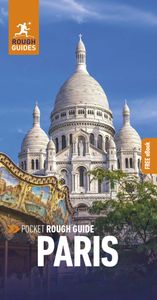
Find even more inspiration here

Planning your own trip? Prepare for your trip
Use Rough Guides' trusted partners for great rates
written by Rough Guides Editors
updated 26.04.2021
Ready to travel and discover France?
Get support from our local experts for stress-free planning & worry-free travels.
- Travel advice
- Where to stay
Home Explore France Official Tourism Board Website
- Explore the map
Provence: what to do, what to see
Inspiration

Reading time: 0 min Published on 4 January 2024, updated on 21 April 2024
Provence can be tranquil or social, wise or wild, unpredictable or calm, stormy or sensible. Seek out secret creeks along the coast, get drunk on the fragrance of lavender or take in a concert in the Roman amphitheatre in Nîmes. The one thing we can promise is that you’ll never be bored.
Not to miss sights in Provence
• notre-dame-de-la-garde and the mucem in marseille.
Marseille knows how to seduce a vistor. From the top of Notre-Dame de la Garde, she offers her most beautiful profile, a cinematographic panorama of the Frioul islands, the creeks, the Old Port, its many ochre walls that run down to the sea—the crown jewel is the Mucem, draped with a black concrete lace, integrated harmoniously between the Fort Saint-Jean and the Cathedral of the Major.
• The city of Aix-en-Provence
In the 18th century, it was dubbed "the little Versailles" for its elegant architecture. Between the classic mansions, mossy fountains, and Renaissance houses, it's hard not to fall in love. Go up the Cours Mirabeau, make a cultural stop at the Hôtel de Caumont or the Granet Museum, and linger at the ancient Roman baths to taste living history in Aix.
• The palace of the Popes in Avignon
The capital of Christianity in the 14th century, Avignon was distinguished by its palace of the Popes, mainly built by Benedict XII and Clement VI. This huge Gothic building, with its powerful towers, courtrooms, chapels and ceremonial halls, imbued with delicate frescoes and vibrant colors. In July, the court of honor turns into a theater scene during the Avignon Festival.
• The Baux-de-Provence and its Quarry of Lights
Ranked among the most beautiful villages in France, this fortress perched on the Plateau des Baux has protected its inhabitants since the Middle Ages. Some main attractions are its old castle, its keep, its Romanesque church, and its Yves Brayer museum. Not to miss: the Quarries, which immerse the visitor in a bath of digital images, projected on the floor and the 14 meters (46 feet) high walls.
• Gorges du Verdon
This Provençal canyon, carves a spectacularly beautiful path between the Var and the Hautes-Alpes. The water sparkles emerald, surmounted by steep cliffs that soften when the Verdon flows into Lake St. Croix. Drink in the landscape by hiking on marked trails, climbing the walls, playing aquatic sports and taking the road ridges electric bike.
• Mont Ventoux
"Mount Bald" culminates at 1911 meters (6270 ft) of altitude emerging from the storybook fields of Provençal lavender—its steep slopes welcome the Tour de France cyclists. From its limestone summit, on a clear day, the view encompasses a panorama that goes from the Alps to the Central Massif, through the Camargue, the Cevennes and the Mediterranean.
• Gordes, Saint-Rémy-de-Provence, Roussillon ...
Villages are like the people that make them up—beautiful, and no two are exactly alike! In the Luberon Regional Park, Gordes stacks its stone houses on a hill overlooking the valley. Also in the Luberon, Roussillon lives in the heart of an ocher deposit, the clay coloring the houses and the land with a thousand glowing hues of orange-red. Saint-Rémy-de-Provence, the small capital of the Alpilles, lazily embodies the Provençal art of living with its squares shaded by plane trees and artists' studios.
• Saint-Sauveur Cathedral in Aix-en-Provence
Built on the old Aurelian Way, between the 5th and the 17th century, this cathedral blends three different styles: Romanesque, Gothic and Baroque. An unmissable sight is the triptych of the Burning Bush, painted by Nicolas Froment in 1476, as well as the church's organs, piping music through this classified historical monument.
• Sainte-Victoire Mountain
From its height of 1011 meters (3317 ft), the mountain dominates the country of Aix, offering views to see the sea and the Alps in clear weather. Sainte-Victoire attracted the painter Cézanne, and nowadays sportsmen, walkers and lovers of religious heritage. The steps on the climb are called Prieuré Sainte-Victoire, Ermitage Saint-Ser, the Croix de Provence.
• The Camargue
The regional park of Camargue extends into the Rhone delta, and offering many routes of discovery, whether walking, cycling or horse riding. As far as the eye can see, lie vast wetlands, marked by salt marshes, flooded meadows, lagoons, home to horses, bulls and flamingos.
• The Camargue • The Verdon Gorges • The city of Aix-en-Provence • The Papal Palace in Avignon • The Carrières de Lumières • Mont Ventoux • The Mucem - the Museum of European and Mediterranean Civilisations - in Marseille • Mont Sainte-Victoire
Things to do in Provence
• trek the lavender road from sault to valensole in early summer.
The Romans perfumed their linen with lavender grown here thousands of years ago—the spiky purple flowers flourish on this territory from the Drôme to the Alpes-Maritimes, via the Hautes-Alpes, Vaucluse and the Alpes de Haute-Provence. Several routes run through the fields, following the blooms, between mid-June and the end of August. There's no splendor in France quite like the plateau of Valensole covered with purple in early July!
• An oenological initiation from Bandol to Châteauneuf-du-Pape
Provence has a wide variety of vineyards, and its AOCs are internationally renowned, be it the Côtes de Provence, Côtes du Rhône, Coteaux d'Aix, Bandol, Cassis, or Chateauneuf-du-Pape. On the wine roads, visitors can sip aromatic rosés, delicately fruity whites and reds of strong French character.

• Stroll through the villages of Luberon and Alpilles
The Luberon is full of medieval villages perched on its heights: Bonnieux, Lourmarin, Lacoste and Ménerbes to name a few. There's nothing like strolling their sleepy lanes at siesta hour or stopping at a terrace overlooking the orchards of olive trees . In the Alpilles, the villages crisscross through the scrubland: the Baux de Provence, Eyguières, Maussanne, Mouriès...
• Soak in the spectacle of the Calanques
About 20 carve out into creeks between Marseille and Cassis, in the national park. Accessible by hiking and boating, the calanques offer beautiful natural indentations between the clear waters of the Mediterranean and the steep cliffs of the mountains. Marseilleveyre, Sormiou, Morgiou, Sugiton, En-Vau, Port-Pin, each have their own beauty and character. They're a sight to be enjoyed and protected.
• Play the movie star in Saint-Tropez
This charming village always seems ready to party! Have a seat at Sénéquier, play pétanque Place des Lices, walk along the quays of the harbor along sumptuous yachts, swim at the beach of Canoubiers or dance at the Caves du Roy. The famous stories of Saint-Tropez are true!
• Tour the Provencal markets
In Provence, each city has its own market, a must for gourmets who love local products full of incredible taste. Some specialties: truffles in Carpentras, flowers in Aix-en-Provence, fish on the Vieux Port in Marseille, fruits and vegetables in Cassis or Saint-Rémy-de-Provence, muscat grapes in Vaison-la-Romaine, sausages in Arles. Grab your bag and haggle your way to some Provençal goodies!
• Take full view at ferias de Nîmes
Every year, at Pentecost and in September, Nîmes comes to life—la feria is an excuse to party in the city: bullfights, bull runs, fanfares, concerts, jousts on the canal or Sevillian dances. The feria promises a festive atmosphere that will please everyone!
• Fishing on the island of Porquerolles
The waters of Porquerolles teem with fish, and the pros accompany visitors on memorable fishing trips (subject to regulation), along the coast of the Hyères islands. Sabers, mackerel, amberjacks are just some of the beautiful catches.
• Fill with emotion during an opera at the ancient theater of Orange
For 150 years, the Chorégies d'Orange have been held largely in the ancient theater, one of the most beautiful sites of the Roman era. Listed as a UNESCO World Heritage Site, it boasts perfect acoustics. Opera voices are magnified naturally to the terraces. Standing ovations guarenteed.
• Admire the work of Van Gogh in Arles
The famous painter stayed in Arles between 1888 and 1889, a period during which he made his most memorable works. His namesake foundation honors him and explores his impact in contemporary art, bridging artists from the past and present.
• The Lavender Trail in Provence • The Calanques in Marseille • The Alpilles • Saint-Tropez • The Férias festivals in Nîmes • The islands of Porquerolles • The Roman theatre in Orange • Van Gogh in Arles
- Plan your trip
- My Provence

By Redaction France.fr
The magazine of the destination unravels an unexpected France that revisits tradition and cultivates creativity. A France far beyond what you can imagine…
Ice Skating Rinks

The Calanques of Marseille, Between Mountains and the Mediterranean

Visit Avignon, the Heart of Provence

Antiques and Provençal crafts

Arles, a city of Art and History in Provence

Barge and river cruise with CroisiEurope in France
Alsace and Lorraine

Cannes, land of contrasts.
Côte d'Azur

Matador Original Series
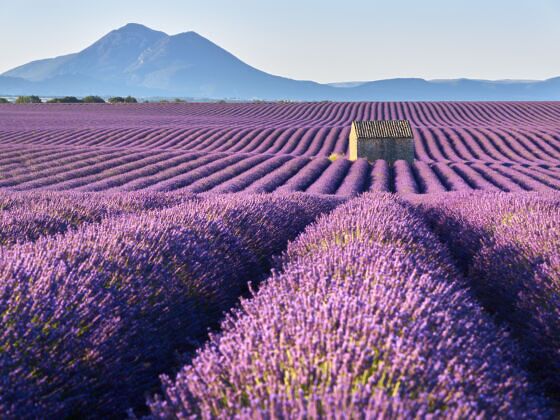
How to Visit Provence, France, Home of the World’s Most Beautiful Lavender Fields
F or most French people, Provence conjures up the sound of the cicadas, the lovely accent of the inhabitants of the region, sunny weather, and olives. To most outsiders, Provence is all about lavender fields. No matter where you’re from and what you think Provence is like, you won’t be disappointed because it’s all the above. The historical region of Provence is an area of simple beauty and unhurried, uncomplicated pleasures, all of which are best enjoyed in the late spring and summer.
What is Provence?
Where is provence, is nice in provence, what is provence, france, known for, how far is paris from provence can you take the train, how to get from provence to marseille, how to get from provence to avignon.
- How to pronounce “Aix-en-Provence”? How to pronounce “provencal”?
When does the lavender bloom in Provence?
What does provence mean, what are herbs de provence exactly and are they from the provence region of france.
- Was the series “Murder in Provence” filmed in Provence? Where exactly?
Provence is a historical and cultural region of southeastern France. It is not, however, an official administrative region. Provence was a sovereign state from the 10th century to 1481 when it became part of France.
The geographical boundaries of Provence have changed over the centuries and remain inexact. It is generally accepted that the boundaries of the region are: the Mediterranean Sea to the south, the Alps to the east, the Rhône river to the west, and the town of Embrun and Saint-Paul-Trois-Châteaux to the north.
The Provence region is now encompassed in the administrative region Provence-Alpes-Côte d’Azur, aslo known as PACA. PACA consists of six French departments:
- Alpes-de-Haute-Provence
- Hautes-Alpes
- Alpes-Maritimes
- Bouches-du-Rhône
Provence’s loose boundaries throughout the centuries means that Nice was once part of Provence, but today is not considered as such (even by the inhabitants of the city.) Nice is, however, part of the administrative region Provence-Alpes-Côte d’Azur, also known as PACA.
The Provence region is mostly famous for its sunny weather, varied and beautiful landscapes, fields of lavender, small villages, and markets selling fresh produce, including the star fruit and vegetables of the area: olives, garlic, and tomatoes. The Provence region is also well-known for having inspired many artists who settled in the area, such as Vincent van Gogh, Paul Cezanne, Henri Matisse, and more.
Because Provence is a large, historical region and not a city, it is hard to determine the exact distance between Paris and Provence. Instead, we can determine the distance between Paris and Aix-en-Provence, the historical capital of the region.
Aix-en-Provence is located around 450 miles south of Paris, i.e. a 7.5-hour drive. For a quicker trip, you can opt to take the three-hour direct train from Paris Gare de Lyon to the high-speed train station of Aix-en-Provence. The high-speed train station is 11 miles out of the city center of Aix-en-Provence. If you’d rather arrive right in the city center of Aix-en-Provence, you’ll have one connection on the way and the trip will be a little longer. Visit the French railways’ website (SNCF) to learn about departure times and prices.
Marseille , the second-largest city in France, is located in the Provence region. If you want to travel between Aix-en-Provence and Marseille, there are hourly direct trains that will take you between the two cities. The train ride takes around 40 minutes and costs less $11 (10 €) in second class. If you’d rather drive, the trip takes 35 minutes.
Avignon is located in the Provence region. If you want to travel between Aix-en-Provence and Avignon, you can take the high-speed train from the high-speed train station of Aix-en-Provence (11 miles out of the city) and the high-speed train station of Avignon (3.7 miles out of the city). The trip takes just 20 minutes and the trains run twice every hour. If you’d rather go to city center to city center, that’s possible by train too, but it takes over two hours and involves at least one connection in Marseille. If you’d rather drive, the trip takes just over one hour.
How to pronounce “Aix en Provence”? How to pronounce “provençal”?
“Aix-en-Provence” is pronounced [x-on-provons]
“Provençal”, which means “from the Provence region, or typical of the Provence region” is pronounced [pro-von-sal]. “Provençal” is also the name of the endangered dialect spoken in Provence.
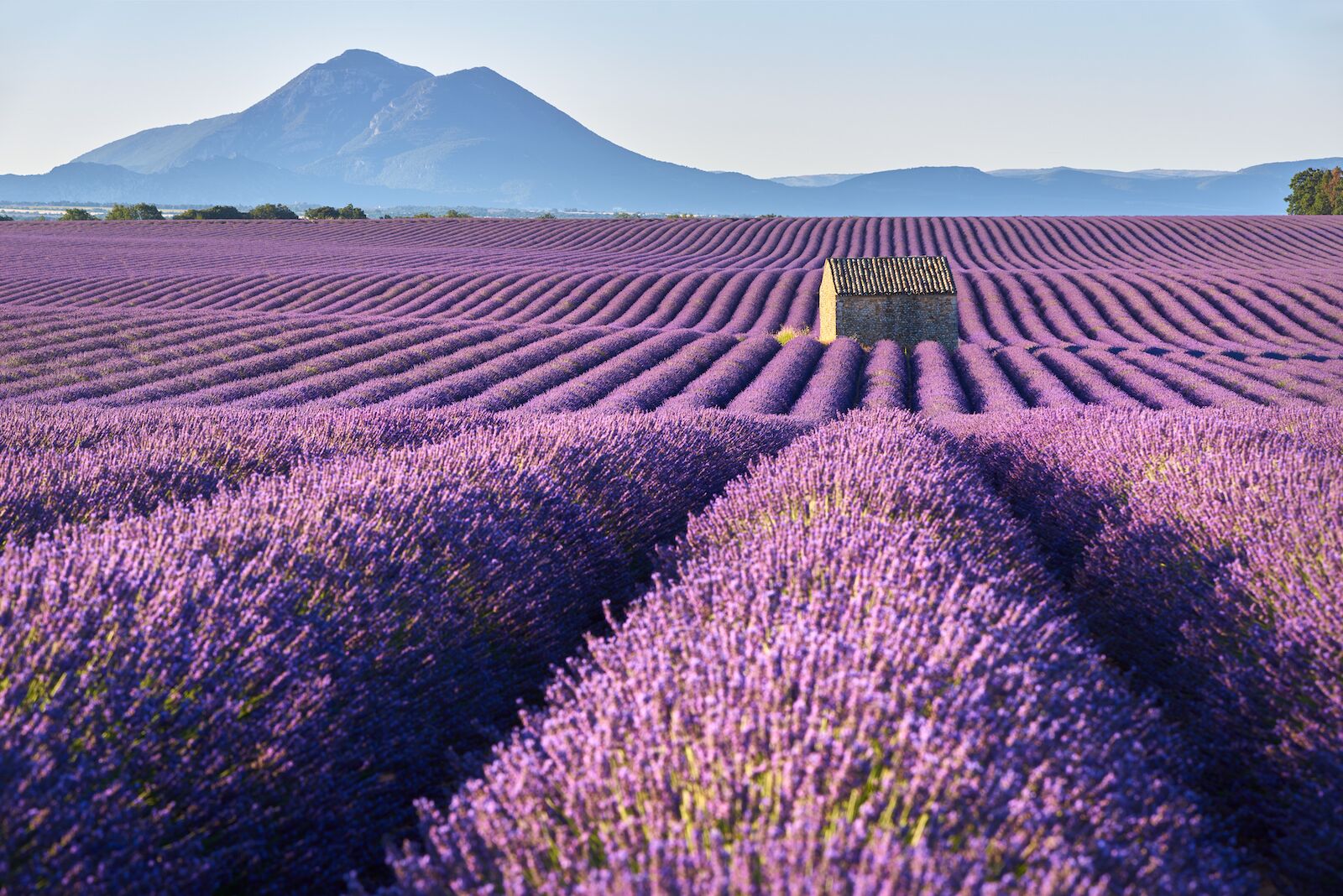
Photo: username /Shutterstock
In Provence, lavender blooms in the summer months: June, July, and August; however, not all the fields of lavender bloom or are cut at the same time. Blooming starts first in the areas around the Rhône river, such as in the Vaucluse department, where the blooms open mid-June and are cut before the start of August. In the Vaucluse, the blooms are best observed in the Plateau de Claparédes and in the area around Sault. In the Alpes de Haute-Provence department, where the most famous lavender fields are in the Plateau de Valensole, the blooms start in late June and are cut in August. The third Sunday in July is the Fête de la Lavande de Valensole , an event celebrating the fragrant purple flowers in all its shapes.
No matter where you go to see the lavender fields of Provence, make sure to either go very early in the morning or at sunset, they’ll be very few people around, it won’t be too hot, and the light will be soft and beautiful.
The term “Provence” comes from the Latin Provincia Romana , which means “Roman Province”. The romans occupied this area between the years 125 and 121.
Herbs de Provence (or as they are known in French herbes de Provence ) is a specific mix of dried herbs commonly found growing in the Provence region of France, including thyme, rosemary, oregano, and savory.
Was the series Murder in Provence filmed in Provence? Where exactly?
More like this
Trending now, the 10 best nudist resorts around the world, the 10 most popular countries for road trips, and how much gas costs in each, 9 french island airbnbs for those who want nothing to do with the olympics, go here, not there: 10 luxurious alternatives to lake como found across europe, lily of the valley hotel offers posh amenities on the french riviera, discover matador, adventure travel, train travel, national parks, beaches and islands, ski and snow.
Gordes, France: The Icon of Provence
Gordes is one of those places that people dream about visiting on their trip to France . It’s named as one of France’s most beautiful villages and it’s been used as the setting for a famous movie. It’s easy to see why as soon as you lay eyes on the hilltop stone town, with the golden rays of sun hitting the shutters, and the beautiful valley below. Gordes might be small but there’s plenty of amazing things to do in this Provencal gem. Find out everything you need to know in this complete guide.
Things to do in Gordes
Gordes has something for every kind of traveler. It’s situated in the breathtaking nature of the Luberon Regional Park, looking down on the greenery of the French countryside. In July and August, you can also see the iconic purple fields of lavender !
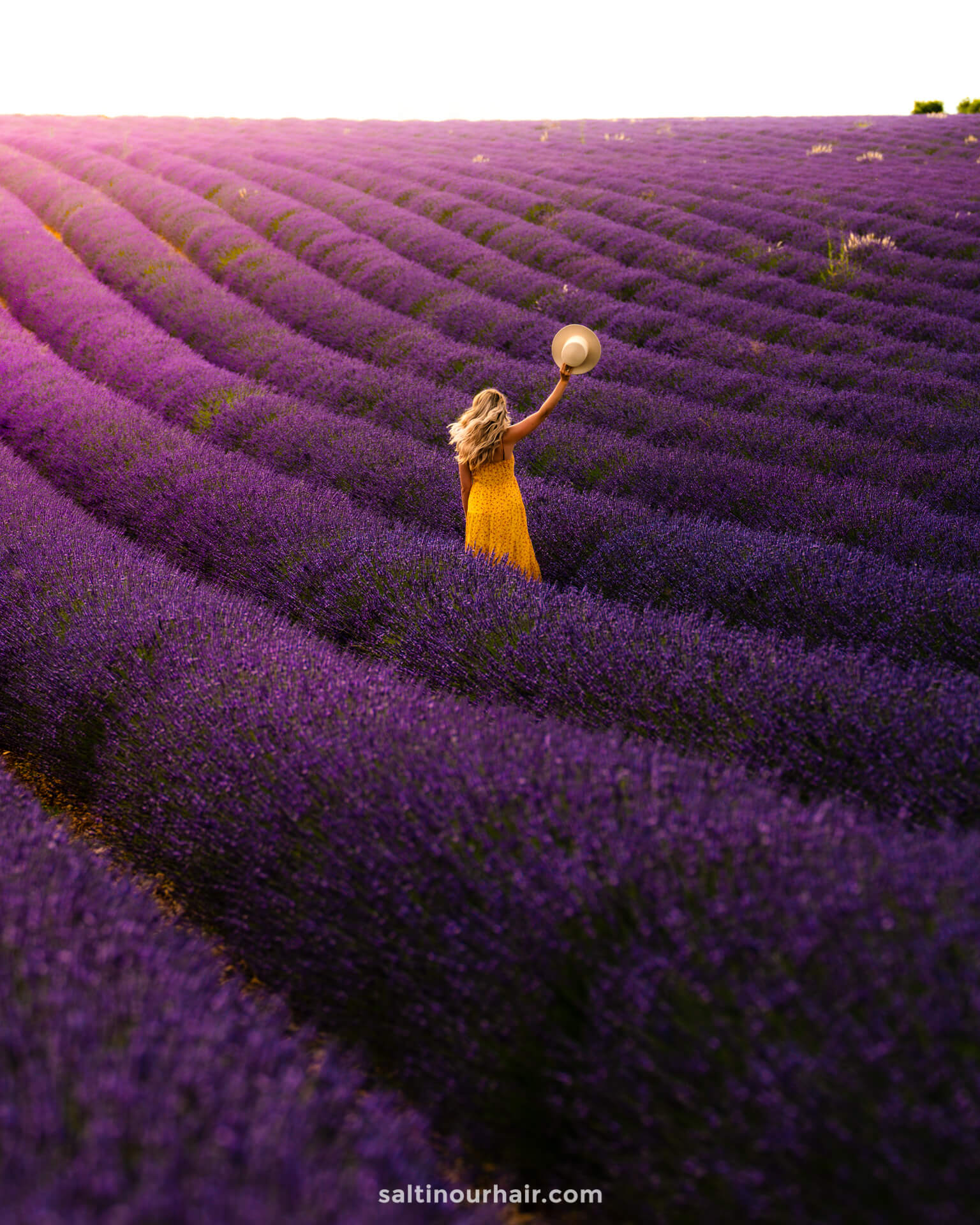
As you drive on the looping hillside roads, you’ll see Gordes perched on the hill as you turn the corner. Each house is built into the hillside at different levels with storybook charm.
In fact, its situation on the hill means that for hundreds of years, it’s been a place of refuge for those needing to escape wars and rebellions. It has a fascinating history, having suffered from numerous earthquakes and bombings over the years. However, it’s managed to preserve its ancient beauty.
Here are all your hotel options in Gordes.
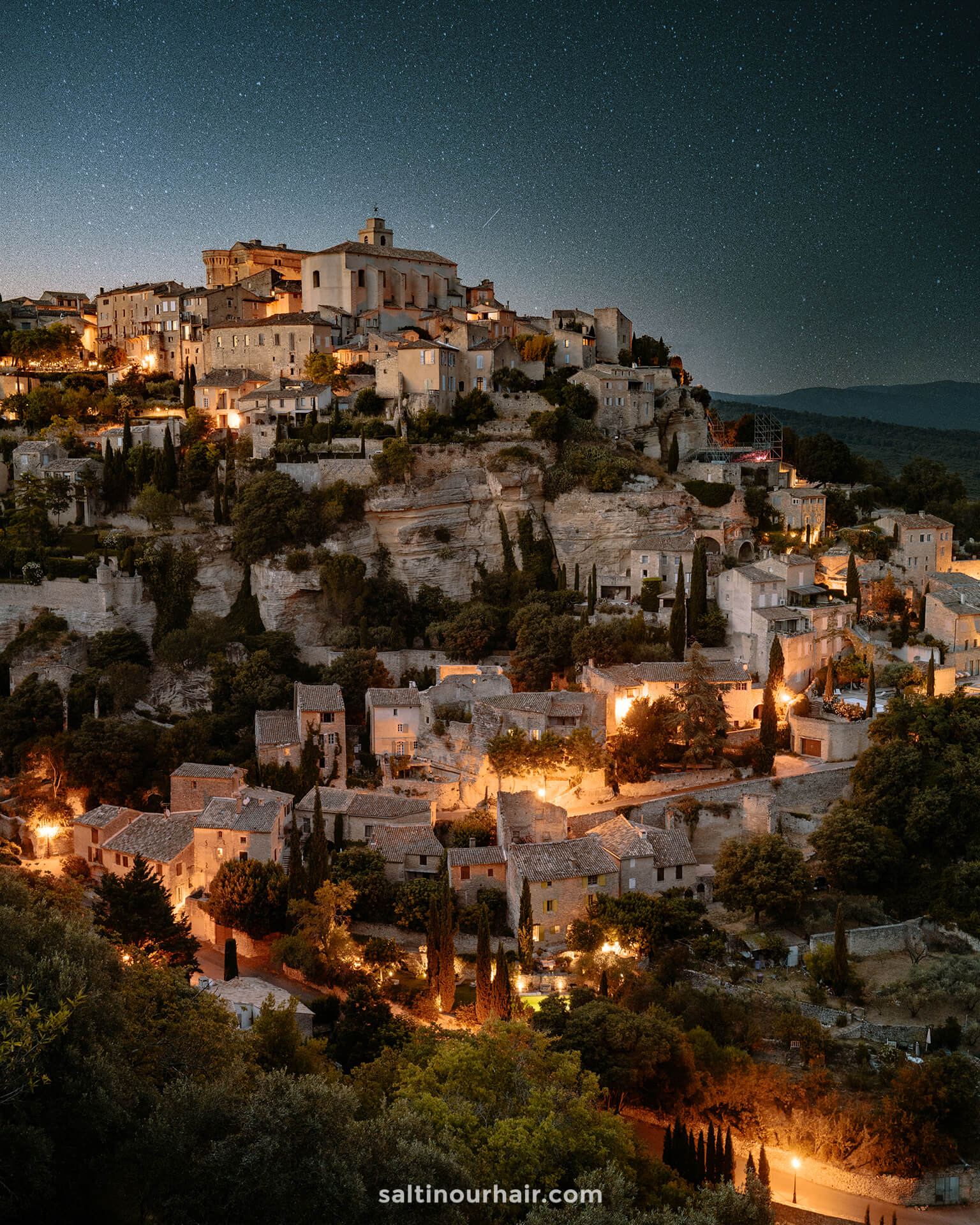
1. Art Scene
The unique scenery of Gordes has attracted many artists throughout the years. Understandably, they were inspired by the romantic landscapes and lighting of the village and its surroundings. It’s still known for the arts now, with many art galleries and exhibits taking place in the village. Spend some time visiting the beautiful galleries or watching painters do their work in the streets of Gordes.
Also visit the The Canyon of Roussillon !
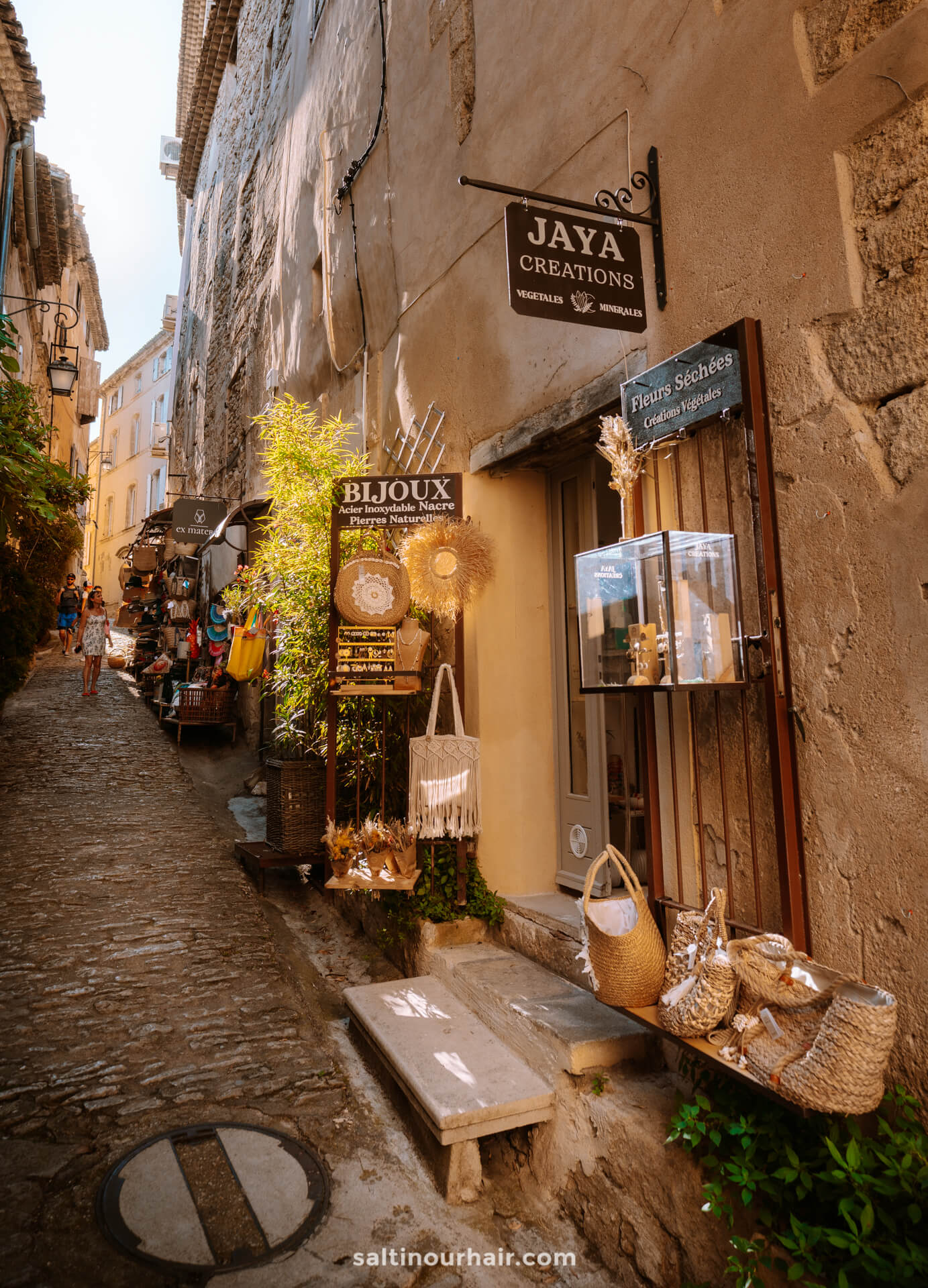
2. Caves of Palais Saint Firmin
Visiting the Caves of Palais Saint Firmin is a unique opportunity to go back in time and learn about the history of Gordes. In the middle ages, the local villagers carved out the rock below the village to make food and store it. They created everything from olive oil mills and bread ovens to workshops and tanneries. During times of war, the underground caves were even used as a hiding place and an escape route.
Opening Times and Entry Fee: The caves are open from the end of March until the beginning of November from 10 AM – 6 PM (break for lunch 1.30 – 2.30). The cost of entry is 6 EUR.

3. L’Eglise Saint Firmin
L’Eglise Saint Firmin is a beautiful church and a must-see on your trip to Gordes, France. Not only is it beautiful on the outside, but it has a spectacular interior. In fact, some have likened it to Italian churches because of its beautiful paintings and carvings. Inside, you’ll find eight different chapels, each dedicated to a patron saint of another profession.
The church is an icon of the town and sits at one of the highest points in the village, making it a great place to go for views of the town.
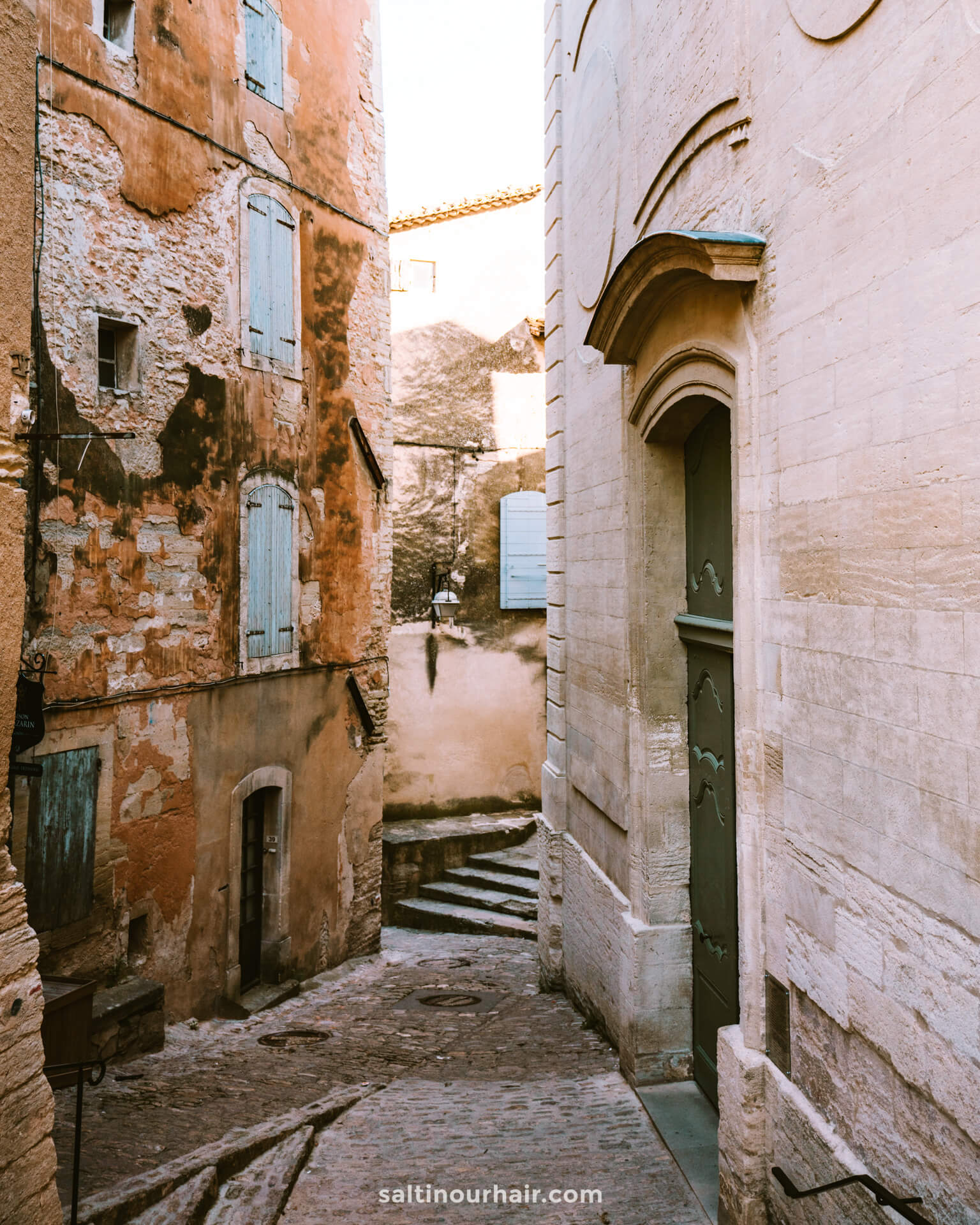
4. Enjoy the Streets of Gordes, France
Simply wandering the streets of Gordes is an activity in itself. Get lost in the narrow cobbled streets, finding stone houses of all different shapes and sizes and stopping around every corner for a new perspective. On your way, enjoy all the cute shops in Gordes. You’ll find art galleries run by local artists, boutiques selling handmade items made from lavender, ice cream shops, and creperies.
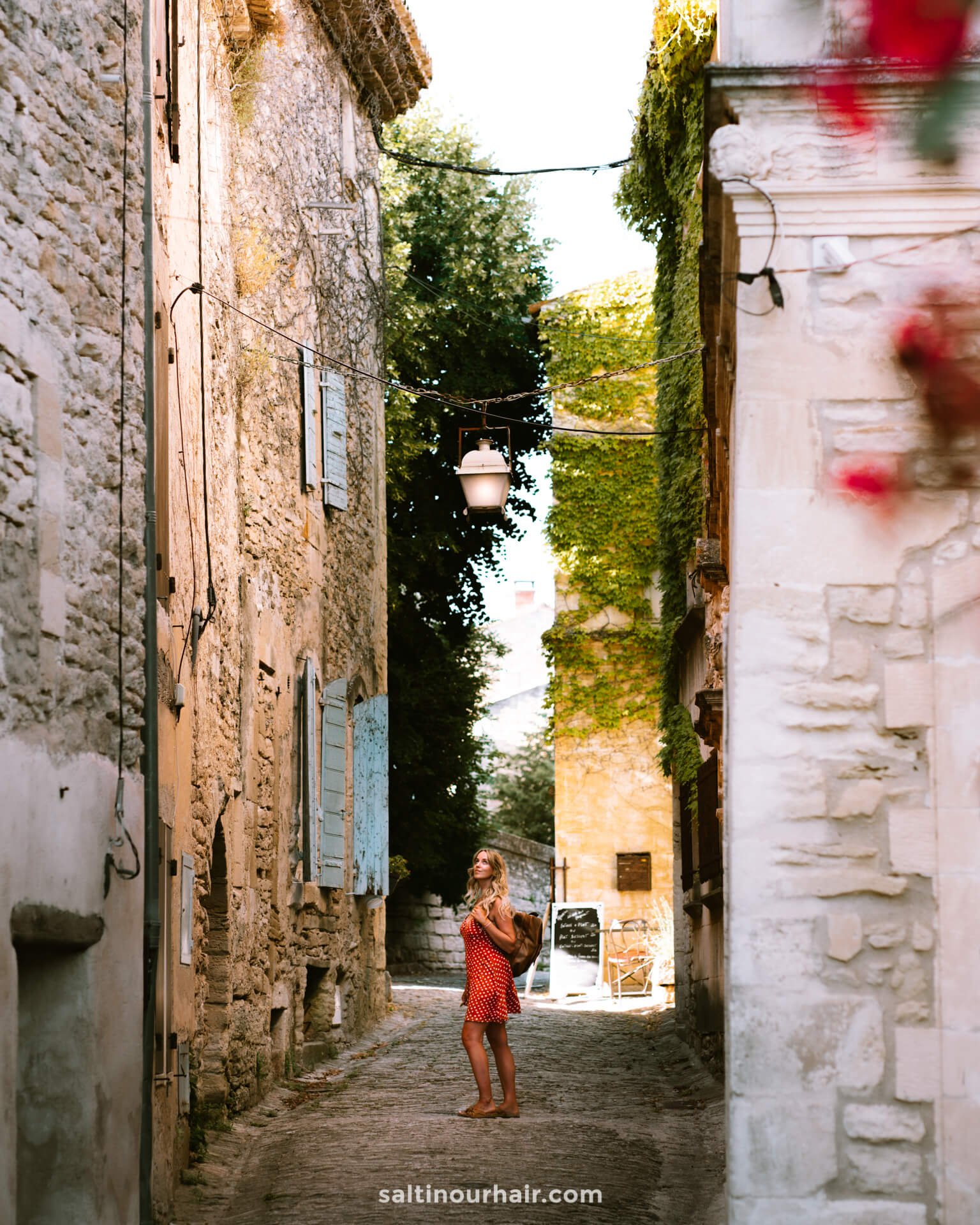
5. Gordes Viewpoint
Gordes Viewpoint is one of the highlights of the village. The spectacular viewpoint sits high above the town, looking onto the houses and the Luberon Regional Park below. Enjoy watching the sun go down and the light changing the color of the stone across the houses. As the evening comes, the street lights come on in the town, making for a magical experience from the viewpoint.
At sunset, the viewpoint can be busy, especially in the summer months. If you want to see the view with fewer people, wake up early for sunrise. The location of the viewpoint can be found here .
Also visit: Gorges du Verdon – Most Beautiful Canyon in France
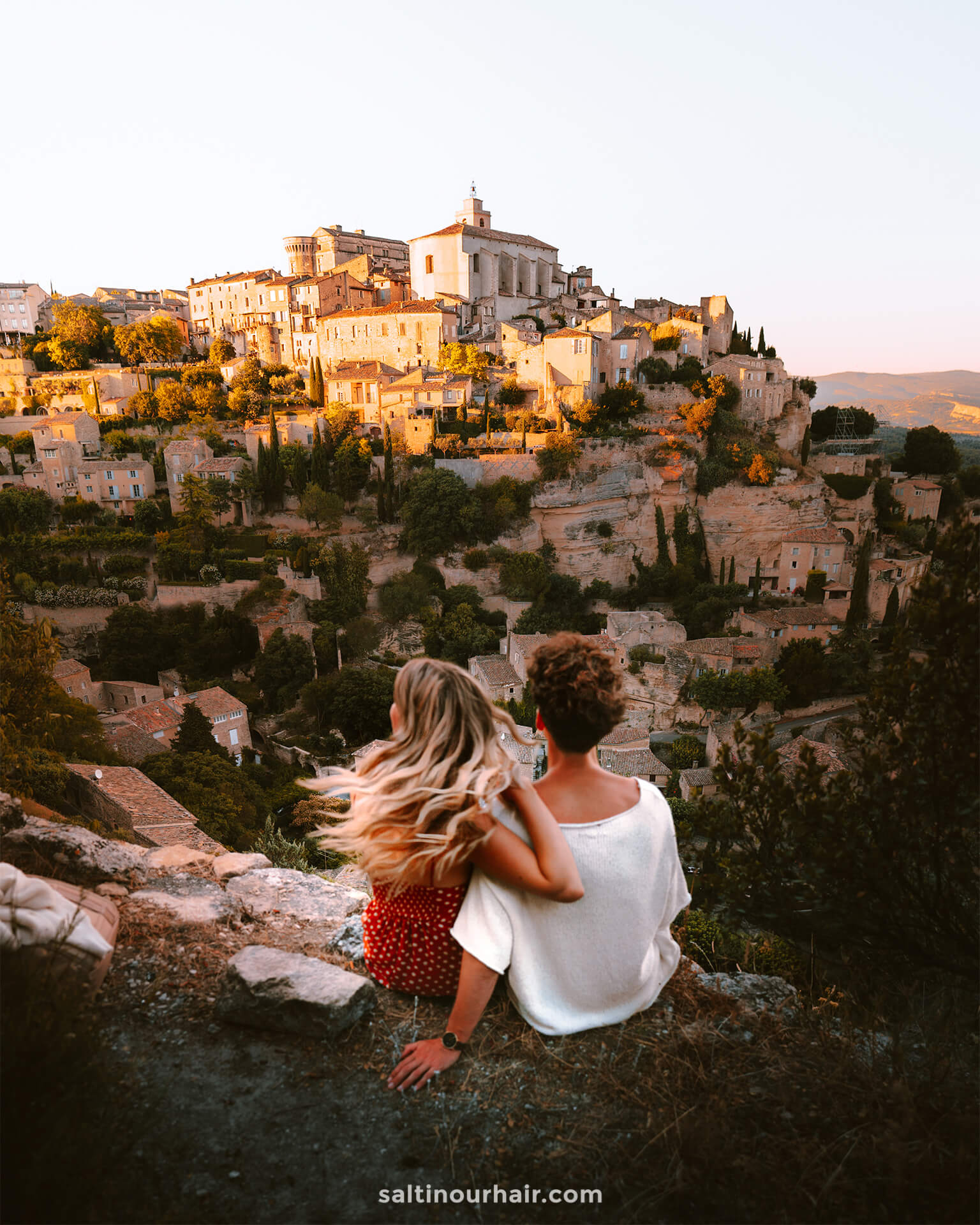
6. Le Chateau du Gordes, France
Gordes Castle (Le Château du Gordes) is one of the most impressive buildings in Gordes. It’s approximately 1000 years old and is one of the oldest castles in France! Now, the castle is home to exhibitions by local artists. Seeing art surrounded by the Renaissance and Middle Ages influences of the building is spectacular.
After you’ve finished exploring the castle, walk a little bit further up the hill to another brilliant viewing area.
Entrance fee and opening times: 7 EUR. The castle is open every day from 10 AM – 6 PM
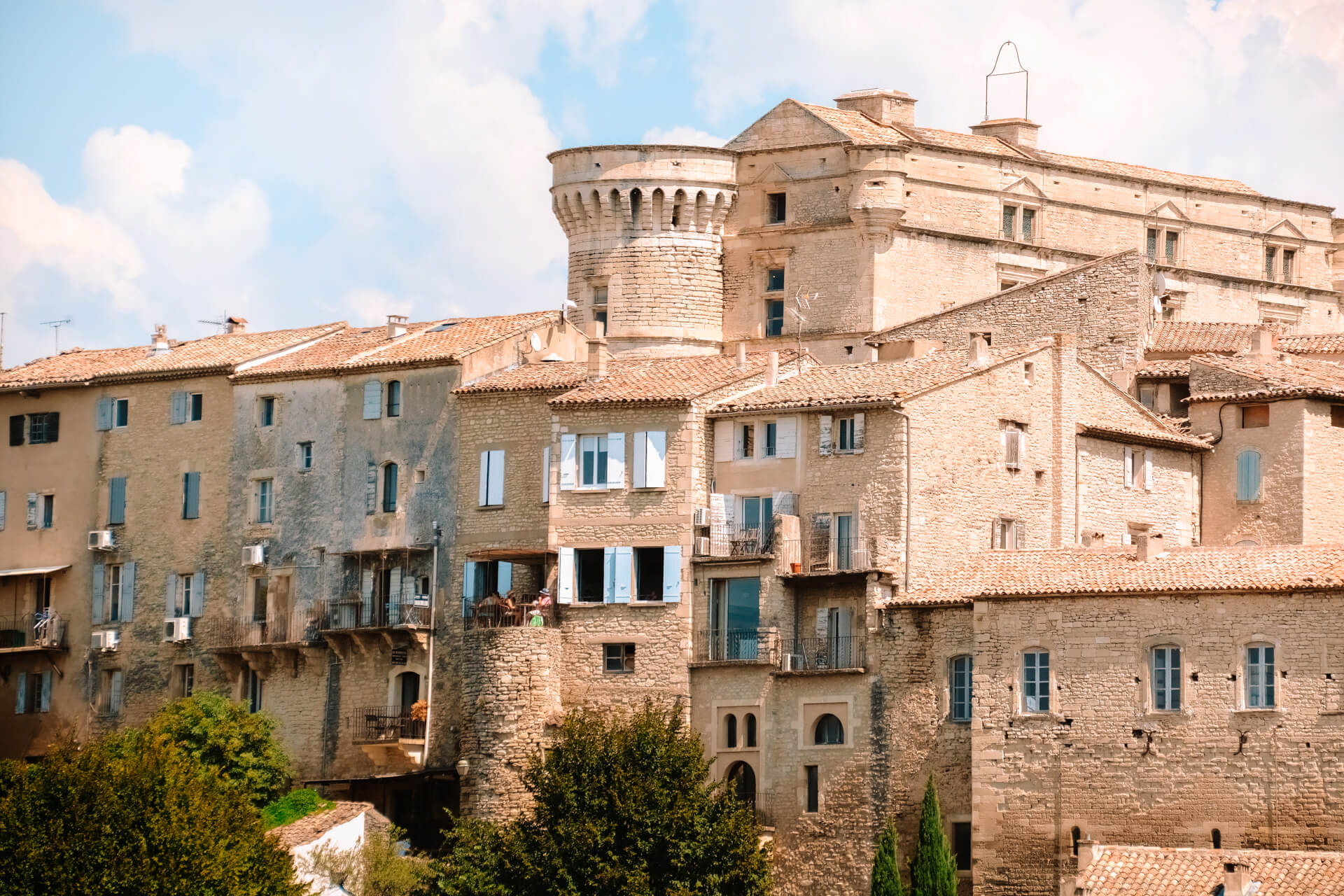
7. Our Lady of Senanque Abbey
Our Lady of Senanque Abbey is a stunning abbey at the foot of the hill below Gordes. The abbey was built in the 13th century and has been used by monks for hundreds of years. Now, the monks still live in it, making a living from producing olive oil, honey and allowing guided tours to the abbey. During the summer months, the fields around the abbey bloom with lavender making it an even more magical setting.
Tip: During visiting hours, the monks move into one of the rooms to pray. Because of this, you must respect the peace of the abbey.
Entry Fee and Opening Times: 8.50 EUR for a guided tour. Open from Monday – Saturday 10.30, 14.00, 15.00, 16.00. Sunday – 14.00, 15.00, 16.00
Book your visit to the abbey online
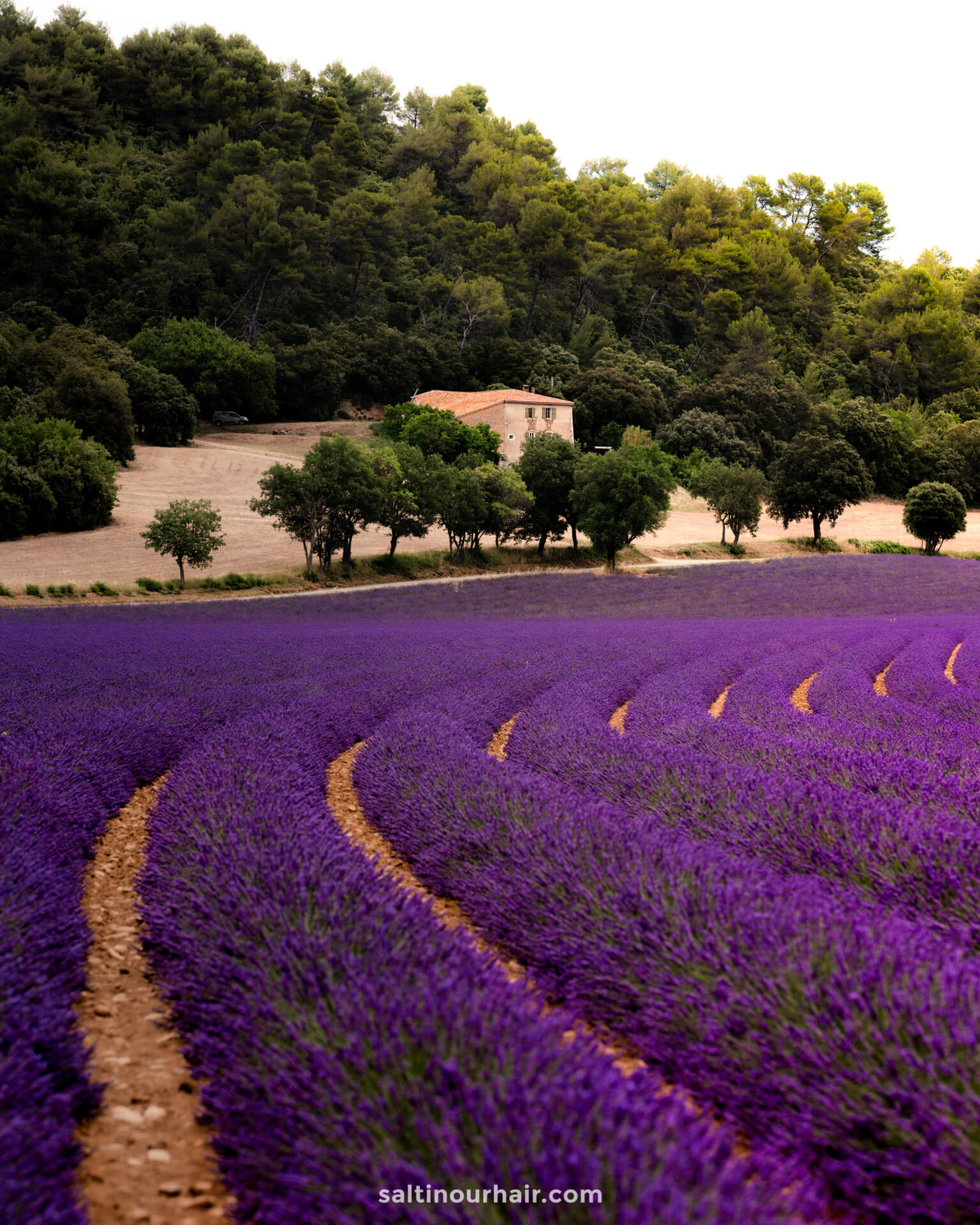
8. Gordes Market
If you’re visiting on a Tuesday, make sure to enjoy the local delights of Gordes Market! Wander between the vendors, buying food and other products, such as woodwork, soaps, and flowers. There are lots of lavender-infused products, too – sourced from the iconic lavender fields of Provence .
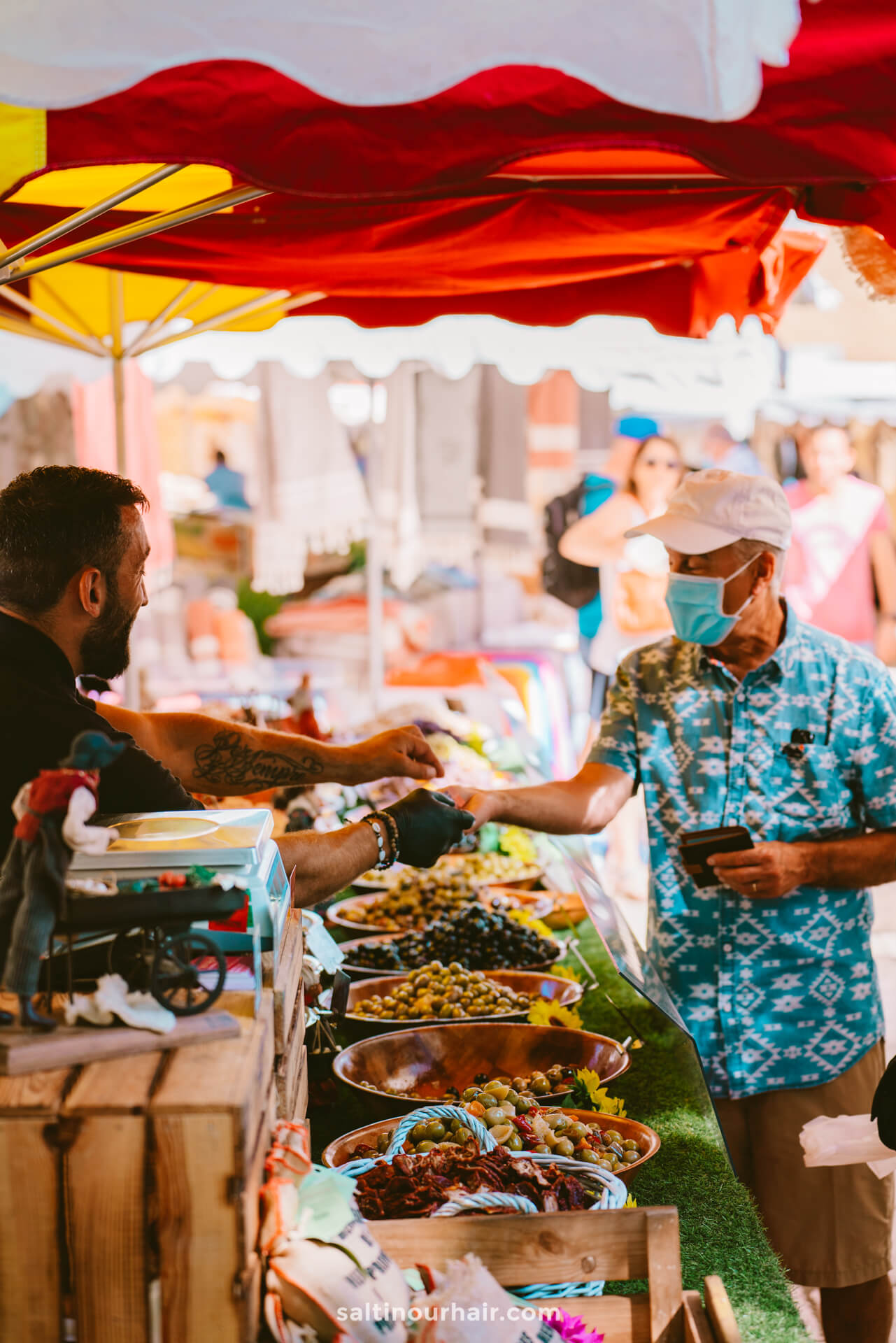
Olive groves surround Gordes, and the locals still use traditional methods to harvest them. Olive oil is an essential part of life here, and you can buy it at the market. If you want to learn more about olive oil production in Gordes, it’s possible to visit one of the local olive oil mills.
Tip: Gordes Market is legendary in the area so on Tuesday’s Gordes becomes very busy. This means it’s especially hard to park on this day.

How to Get to Gordes, France
Drive: Gordes is very remote, so it’s easiest to drive here. This way, you can also explore the surrounding national park and enjoy the beautiful nature here. It’s around a one-hour drive from bigger cities like Aix-en-Provence and Marseille .
It’s a lovely drive to Gordes, but be aware it can be hard to park once you get to the village. Bring some change to park the car, as the car parks all cost a small fee.
We recommend to rent a car in France through Sunny Cars with free cancellation and insurance included. Book your rental car here .
Train: If you’re arriving by train, head for the nearby station of Cavaillon. From here, it’s possible to take a public bus to Gordes.
Day Tour: Alternatively, you can join a day tour to Gordes from bigger cities in Provence . These include a tour guide and return transport.
Book a half-day tour to the villages .
Best Time to Visit
Gordes is an icon of Provence and, as a result, gets busy in the summer months. However, it’s the only time you’ll be able to see the lavender fields burst into color, which is definitely a once-in-a-lifetime experience.
If you don’t mind not seeing the lavender, it’s a good idea to visit in the shoulder seasons. For example, spring and autumn are perfect for warm days and quieter streets.
Here are the best lavender fields in Provence
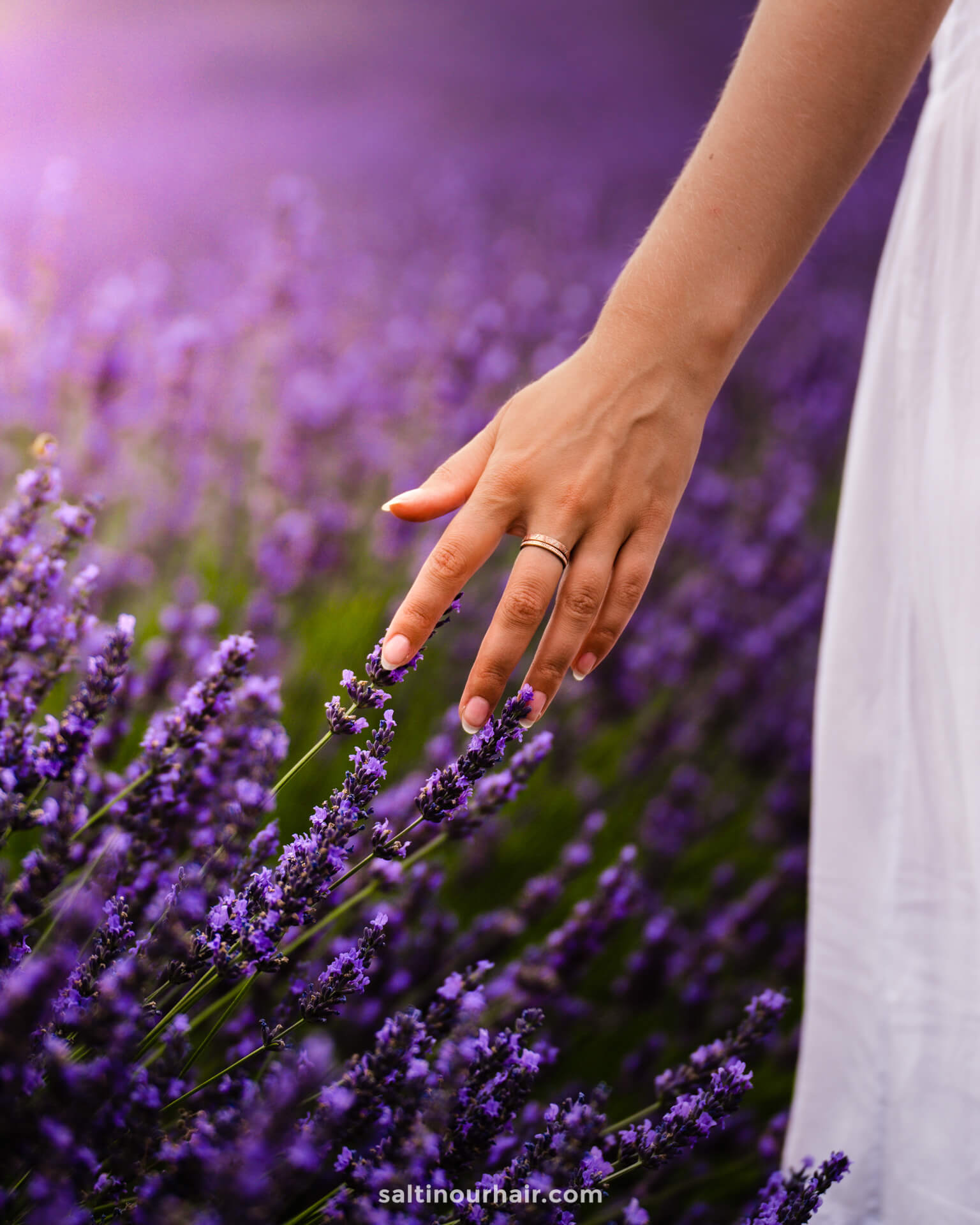
Best Places to Stay Gordes
Most people visit Gordes, France, on a day trip. However, the captivating nature of the village means you might want to stay longer. Most of the hotels within the village are luxury or boutique and a bit more expensive. If you’re looking for something a little cheaper, opt for a guesthouse or apartment outside of the village.
Hotels in Gordes 😴
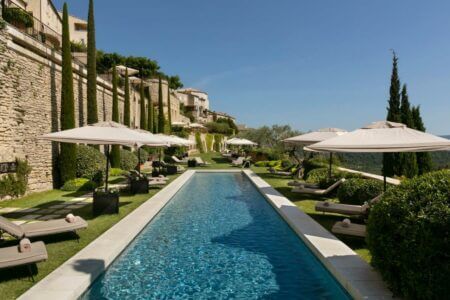
Best Restaurants
Gordes is a small village, but it’s packed with amazing restaurants to enjoy locally sourced food and wine. Many of these restaurants have beautiful terraces with breathtaking views over the valley. All of them are small, charming, and have that cozy, romantic feel. Some of our favorites were:
- La Bastide de Pierres
- L’Outsider
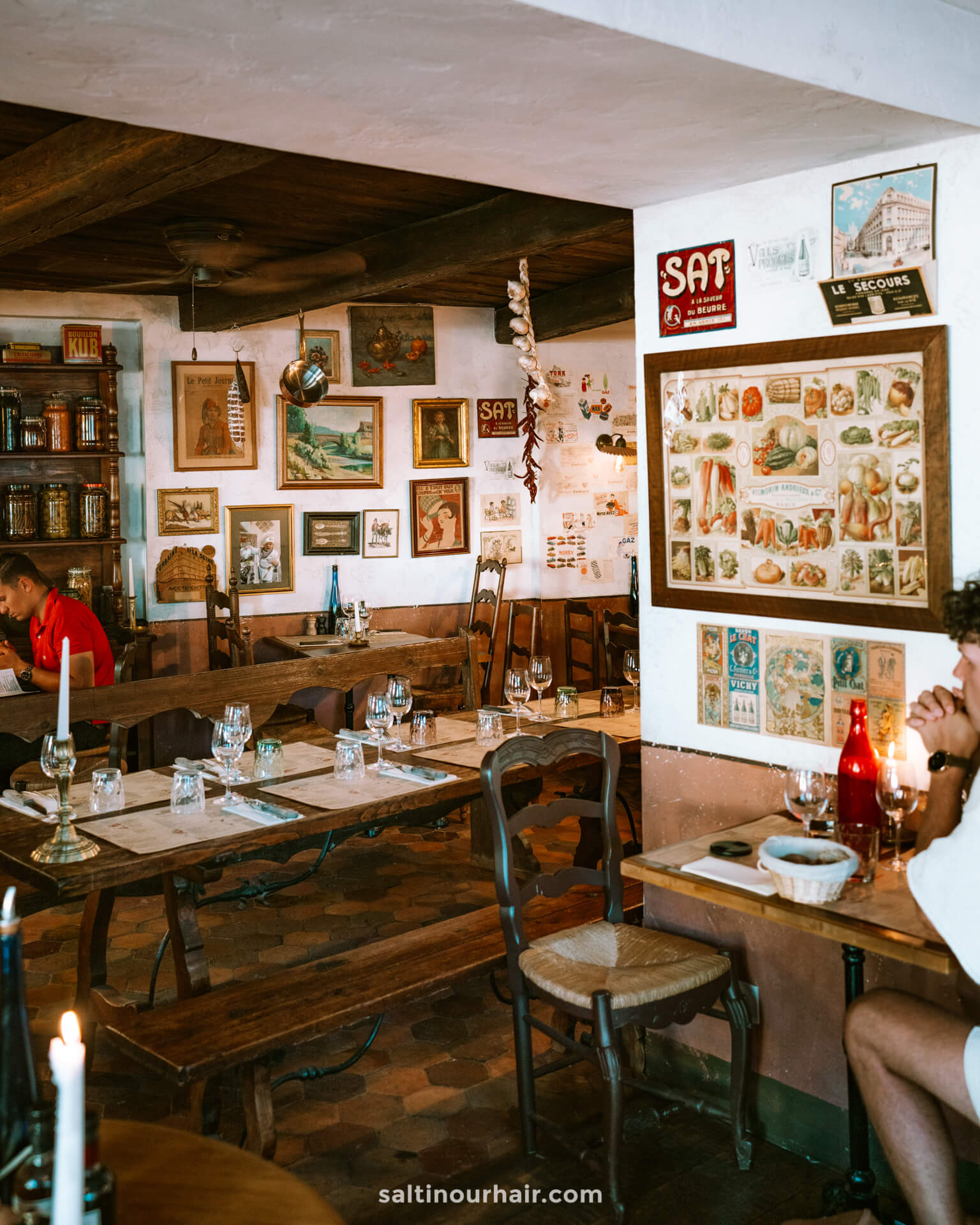
By purchasing through our links, you support us at no additional cost. Thank you for your support. ♥️
- Find Hotels via Booking.com
- Find a Rental Car via Sunny Cars
- Find Flights to France via Skyscanner
- Get a Travel Insurance via Heymondo
- Book Tours & Attractions via GetYourGuide
- Book a Bus/Train/Transfer via 12Go
Cotignac: The Cliffside Village of Provence, France
Gorges du verdon: most beautiful canyon in france, best things to do in ile de ré, atlantic coast, france.
Looking for more travel information? Plan a chat with us for personalised travel advice or get an answer from the Salt in our Hair Travel Community on Facebook.
The Church in Gordes is Firmin not Fermin :-)
Your email address will not be published. Required fields are marked *
Notify me when new comments are added.
Best Places to Visit in Provence, France
Article written by Elisa - Travel Writer & Local in France This article may contain compensated links. Please read disclaimer for more info.
Visit Provence, France
Provence is part of the French region Provence-Alpes-Côte d’Azur in the southeast of the country. It’s a beautiful area with amazing scenery, a history that goes back to Roman times, and adorable little villages. Whether you enjoy great food, sipping wine in sumptuous surroundings, or relaxing on the beach, you need to visit Provence!
Where to go in Provence? To help you get the most from your trip to this part of France, here are the best places to visit in Provence, France, for every kind of traveler. Some of these best places in Provence are high on our list of the best things to do in France !
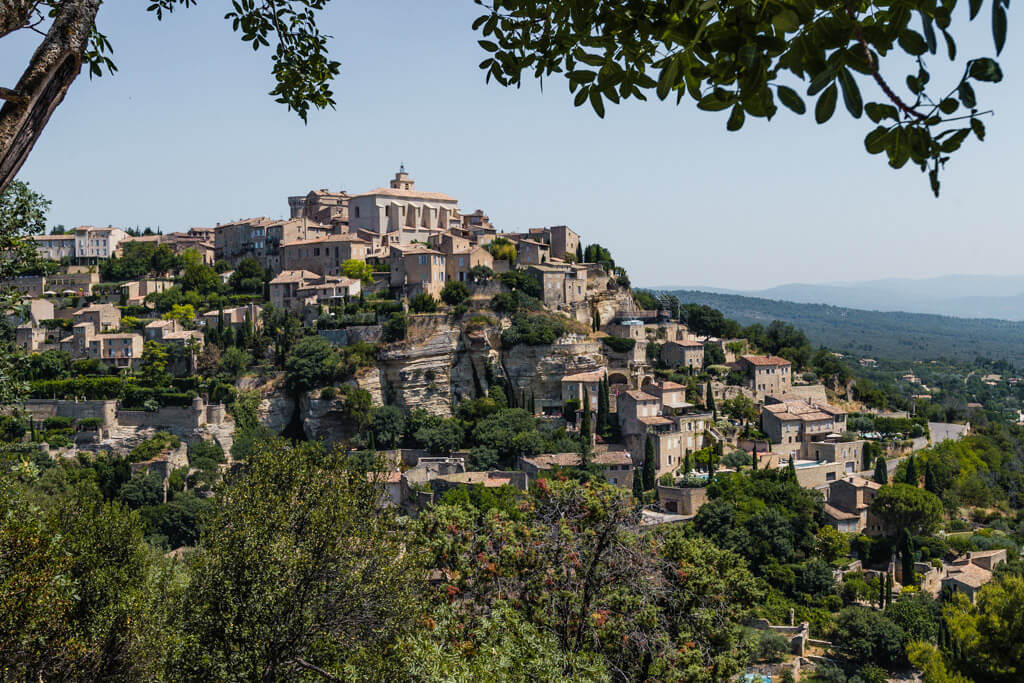
ROAD TRIP ITINERARIES THAT COVER PROVENCE
- Road Trip Route du Mimosa
- The Ultimate South of France Road Trip Itinerary (2 weeks)
- The Ultimate Provence Lavender Route
- Road Trip Gorges du Verdon
- Luberon Road Trip
Most Beautiful Places in Provence, France
Where to visit in Provence for a weekend getaway or a longer trip? Here’s the best of Provence, with something for everyone.
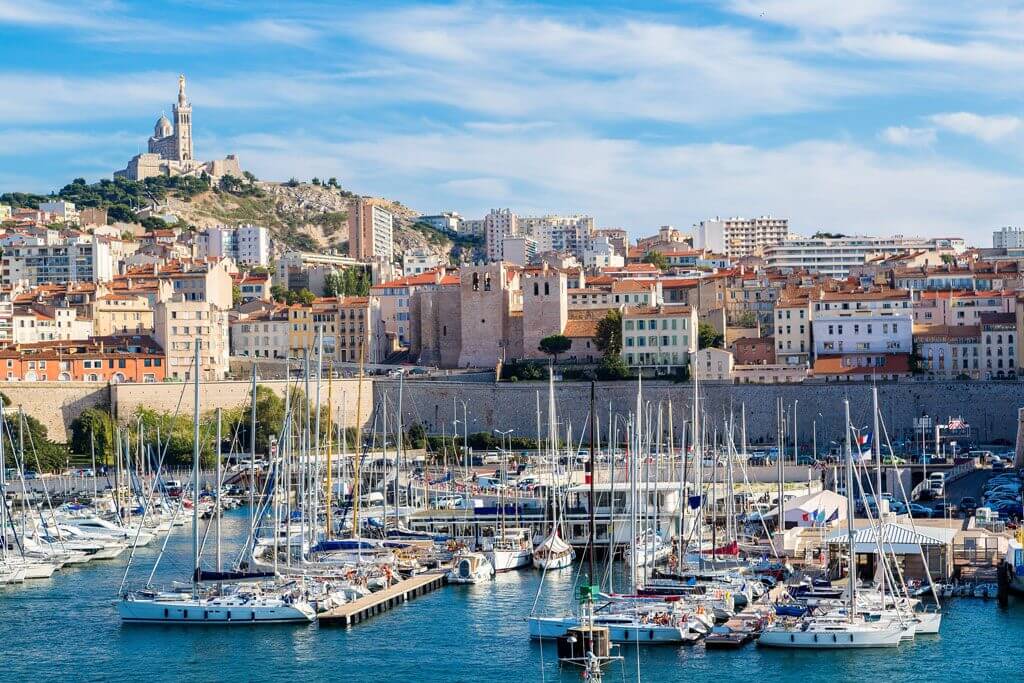
Marseille is the capital of Provence and the second largest after Paris. It’s a Mediterranean city with a busy harbor and the ideal place to experience authentic France. Well connected to Paris with fast trains, a weekend in Marseille is super easy to organize from the French capital.
Marseille’s historic district of Le Panier is a must-see in Provence with its narrow streets, café terraces, and street-art-colored facades. You should also make sure to see the Basilique Notre-Dame de la Garde , with its views of the bay from the terrace, and the Musée des Civilisations de l’Europe et de la Méditerranée (MuCEM) to learn more about the history of Mediterranean peoples.
TIP: The Marseille City Pass saves you time and money with free entry to Marseille’s top attractions and unlimited travel on public transport.
The Hilltop Villages of the Luberon
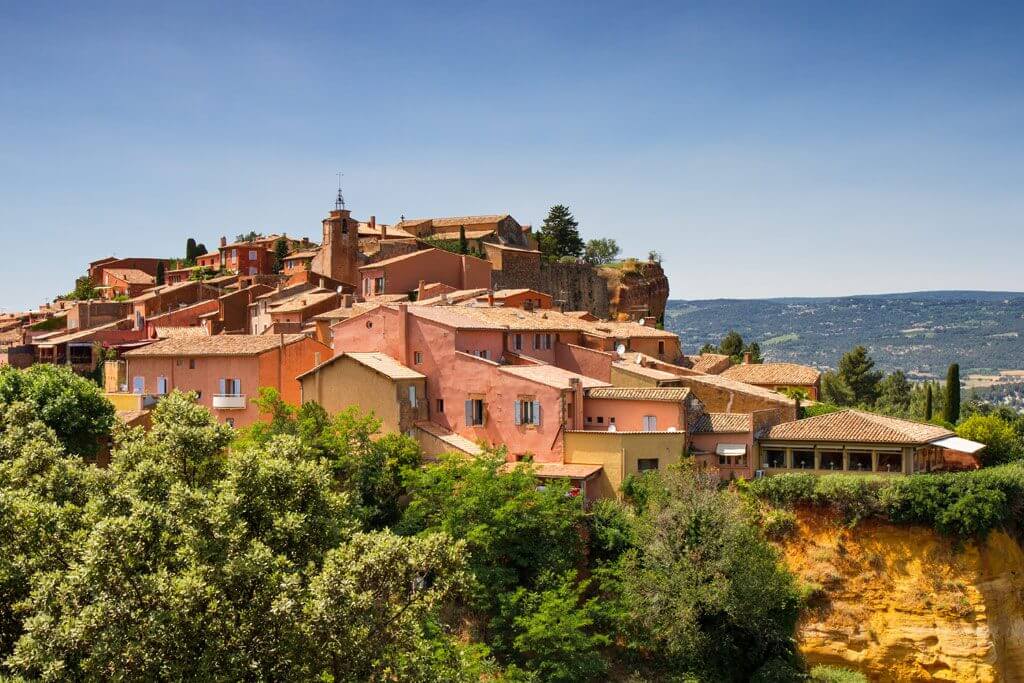
The Luberon region is another of Provence’s best places to visit. Located 70 km north of Marseille, it includes parts of the Vaucluse and the Alpes-de-Haute-Provence departments. This is an area of extreme landscapes, as well as small hill towns that guard sleepy valleys and vineyards.
The hilltop villages in Luberon are popular tourist attractions, and most of them are listed as Most Beautiful Villages in France. From Bonnieux to Gordes and Roussillon, each of them has its own distinct character and features, and they are easy to visit on a day trip from Avignon (though we recommend exploring the area by car on a Luberon road trip ).
Aix-en-Provence
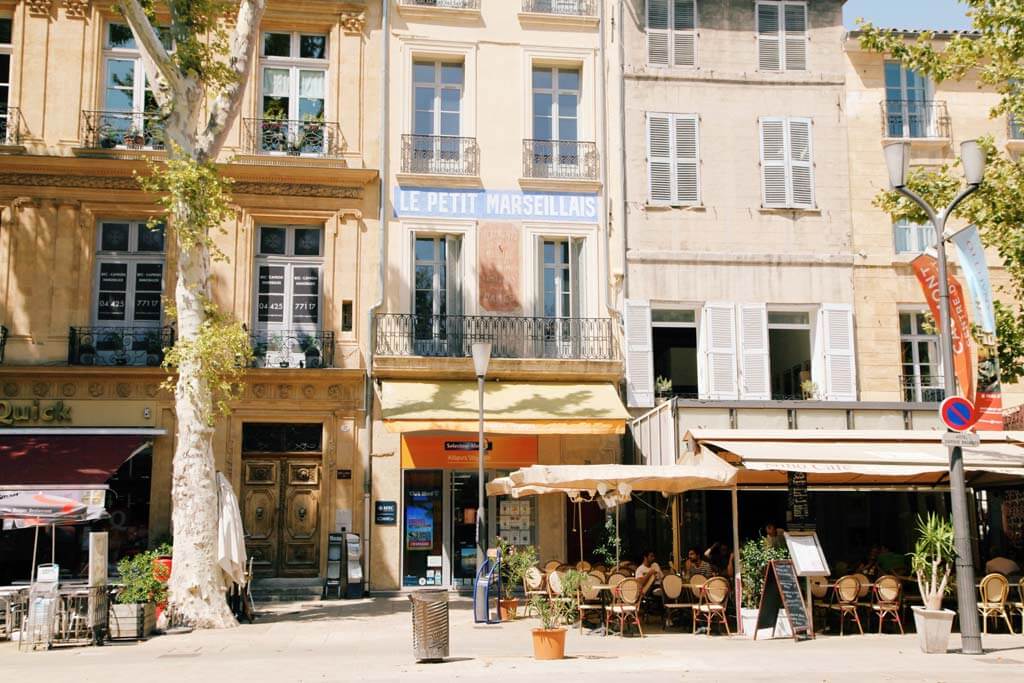
Aix-en-Provence is one of the top Provence cities to visit. Aix is the quintessential Provencal city, with a unique blend of history, balmy weather, and elegance. The tree-lined boulevards, Roman monuments, and ornate fountains of this city are a Provence must-see, and the city has a wonderful warmth that’s characteristic of Southern France.
There are numerous tourist attractions in Aix-en-Provence, and also welcoming cafés and a lively atmosphere. While you’re there, make sure you check out Les Deux Garçons , once a favorite hangout of Picasso and Edith Piaf, the architectural marvel that is Cathédrale Saint-Sauveur , Cézanne’s workshop , and Musée Granet , where you can see fine arts created by the greatest masters in history.
TIP: Explore the famous markets of Aix-en-Provence with this Aix-en-Provence Market Tour
Calanques of Marseille-Cassis
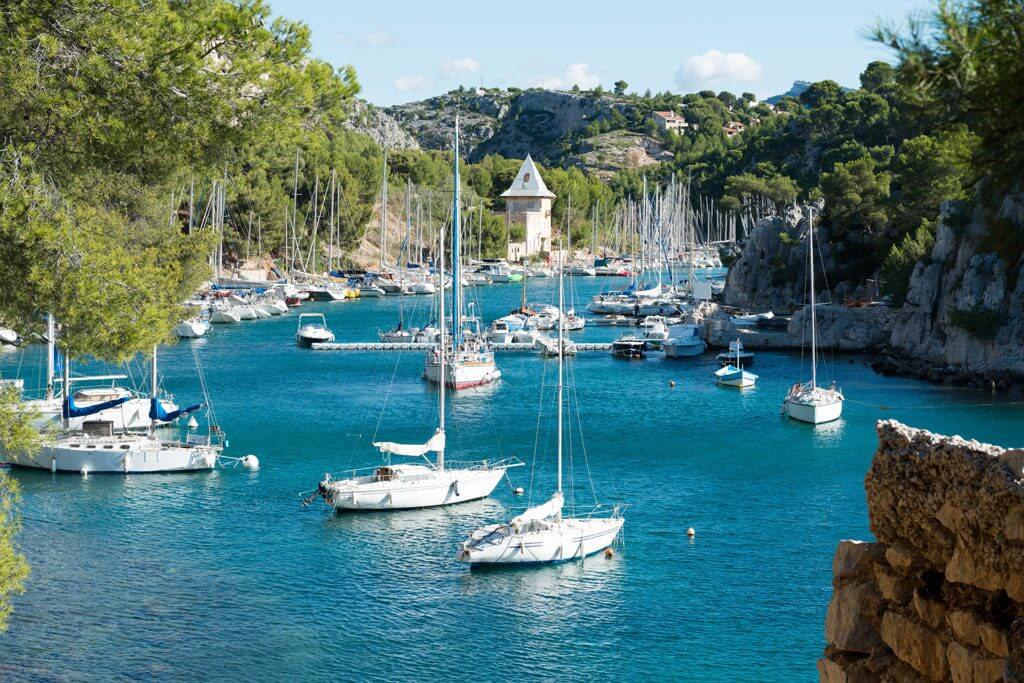
The Calanques of Marseille-Cassis is of the best places to go in Provence, France, for nature lovers. It’s a series of limestone cliffs and bays located between the fishing town of Cassis and the city of Marseille. Not all Calanques are easily accessible on foot, but there are plenty of inlets and bays that you explore with a catamaran tour or on a guided tour by kayak .
This is the perfect place for some outdoor adventures in the south of France. The scenery is simply spectacular, and you can do everything from kayaking to swimming, hiking, or sunbathing.
Lavender Fields of Provence
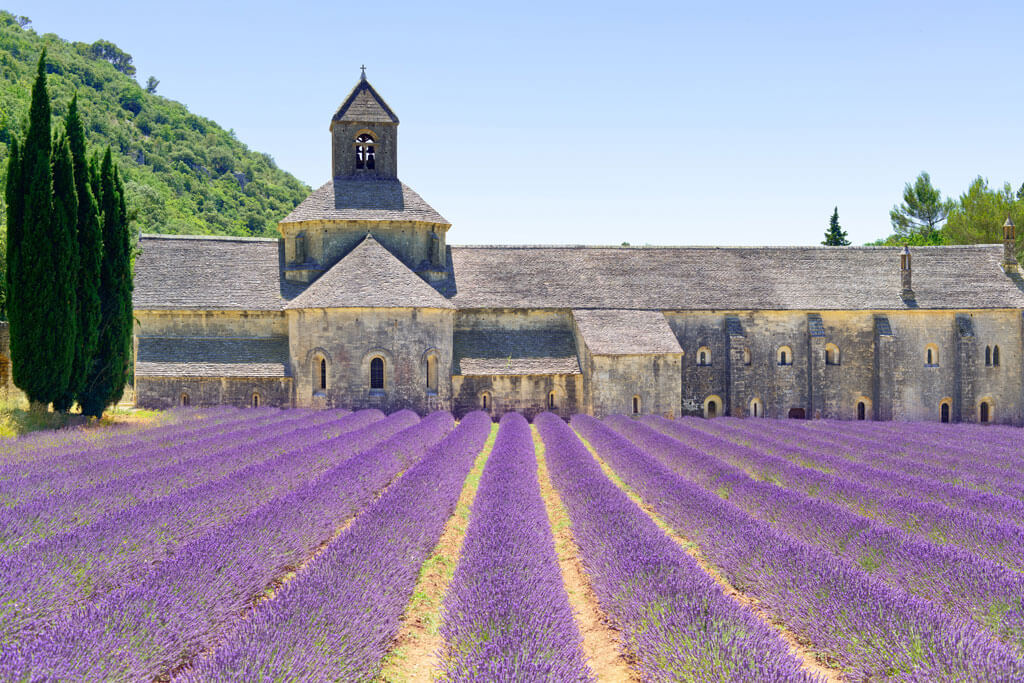
The lavender fields of Provence are one of the best places to visit in Provence, France. Located in the Luberon and near the towns of Valensole and Sault , the fields are seemingly endless seas of deep purple, complete with that heavenly smell under the balmy sun of the south of France.
The lavender season in Provence is different depending on where you go, so make sure you arrive before harvest time for the best views.
The Camargue
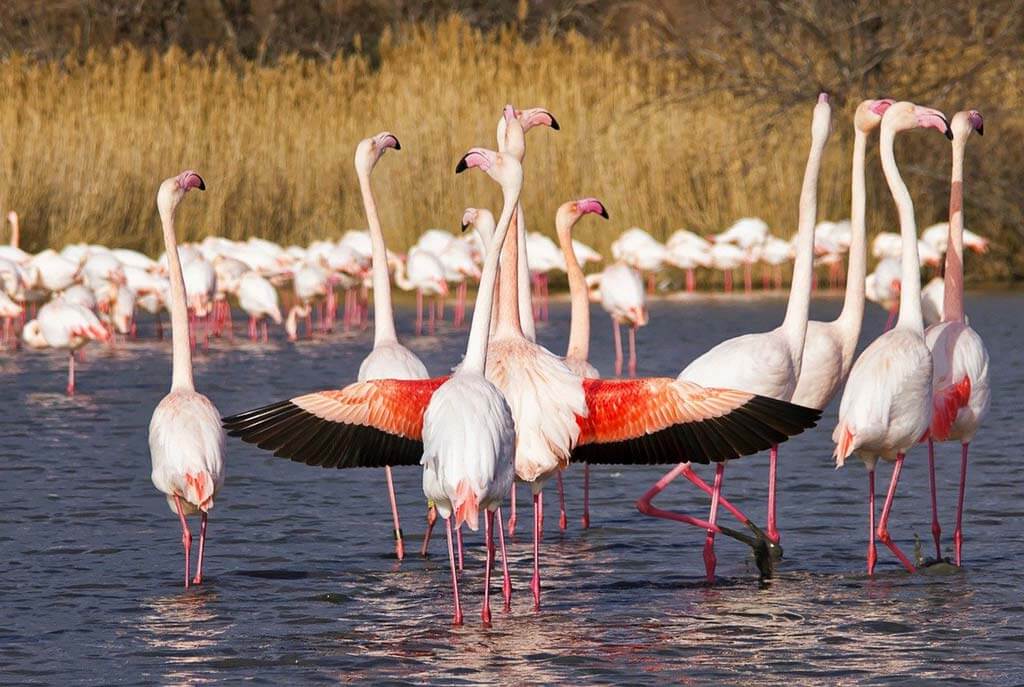
The Camargue Regional Natural Park is another of the most beautiful places in Provence. This natural area is located south of the city of Arles is the largest wetland in France, covering a surface of 100,000 hectares. The Camargue is famous worldwide for its stunning landscapes, lakes, and exceptional fauna.
The Camargue is designated as a Wetland of International Importance and Western Europe’s largest river delta. It’s a haven for wildlife and is home to more than 400 species of birds, countless insects, and larger wildlife, from Camargue horses to cattle. It is also an excellent place for a relaxing getaway in Southern France – Click here for the top-rated hotels in the Camargue .
The Colorado Provencal
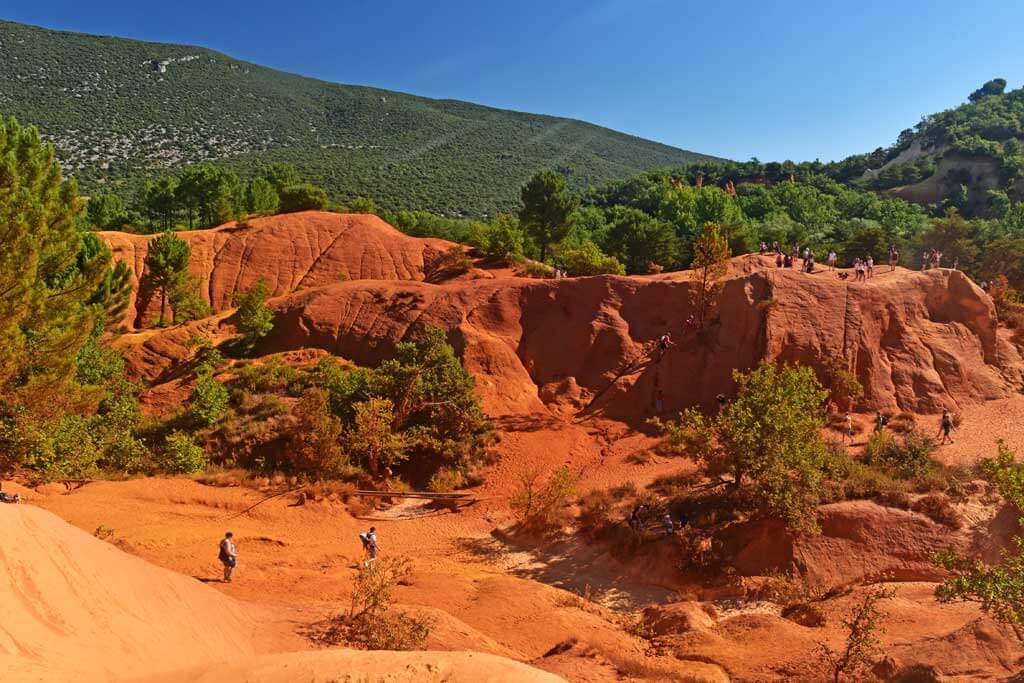
If you are looking for unique places to see in Provence, then visit Rustrel for a total change of scenery. Rustrel is part of the region around Roussillon, famed for its dramatic, richly colored ochre landscapes.
Here, you can walk in the Colorado Provençal , a beautiful hike through cliffs and multicolored ocher rocks shaped for centuries by erosion and the work of men. There are two walking trails available (1-2 hours), and they both combine the pleasure of hiking and discovering an industrial heritage.
Hyères Islands
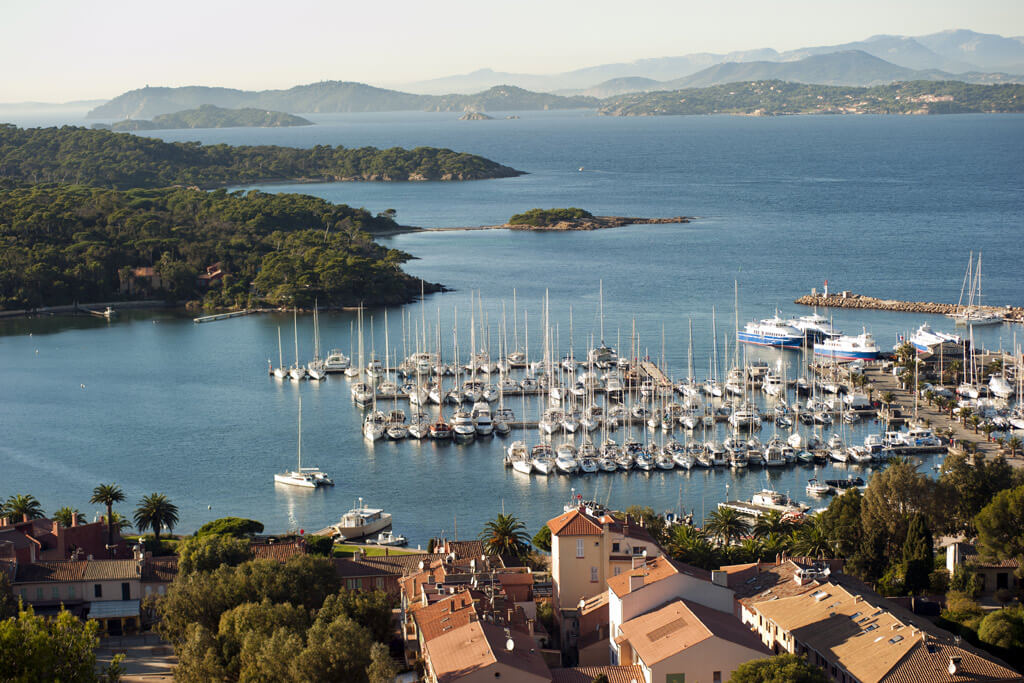
The Hyères Islands are one of the most beautiful places in Provence, France, for a relaxing vacation. They are a group of French islands off the town of Hyères in the Var department of Southeastern France. The Hyères Islands are often called the Iles d’Or or the Golden Islands and consist of three main islands and one smaller one. The smallest island, Île du Bagaud , doesn’t allow visitors.
The island of Porquerolles is the most popular of the four, with beautiful turquoise water, sandy beaches, a sleepy little village, and several wineries. Port-Cros , one of the other islands, is mountainous and home to a bird refuge and rare flora. And if you have the time, then you can explore Île du Levant , with its naturist community and privately owned village.
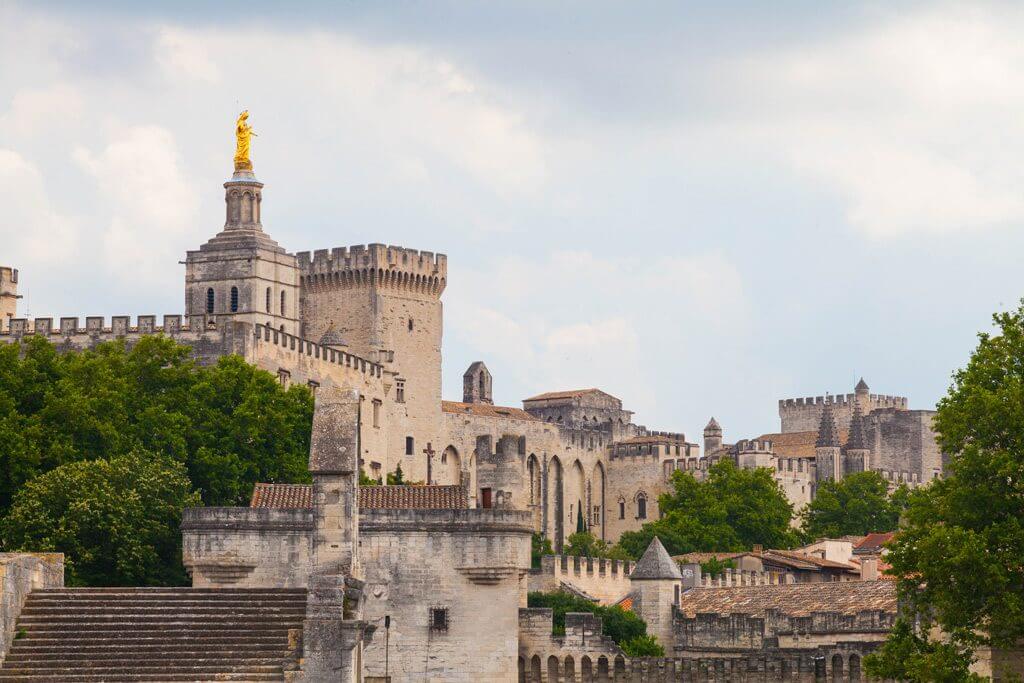
Avignon is on the left bank of the Rhône River. One of the most beautiful walled cities in France , Avignon was the seat of the Catholic Popes from 1309 to 1377.
Avignon is most famous for its medieval town and the Palais des Papes , Europe’s largest Gothic Palace and one of the most interesting places to visit in Provence. The Palais des Papes is a UNESCO-listed palace that was built in the 14th century when the papal court moved from Rome to Avignon.
The town of Avignon is filled with museums like the Musée du Petit Palais , with displays of artwork by Sandro Botticelli and Vittore Carpaccio. It also has beautiful churches and the famous Saint-Bénézet Bridge (Pont d’Avignon) , which partially spans the river.
TIP: This top-rated Avignon Walking Tour is an excellent introduction to the city.
Gorges du Verdon
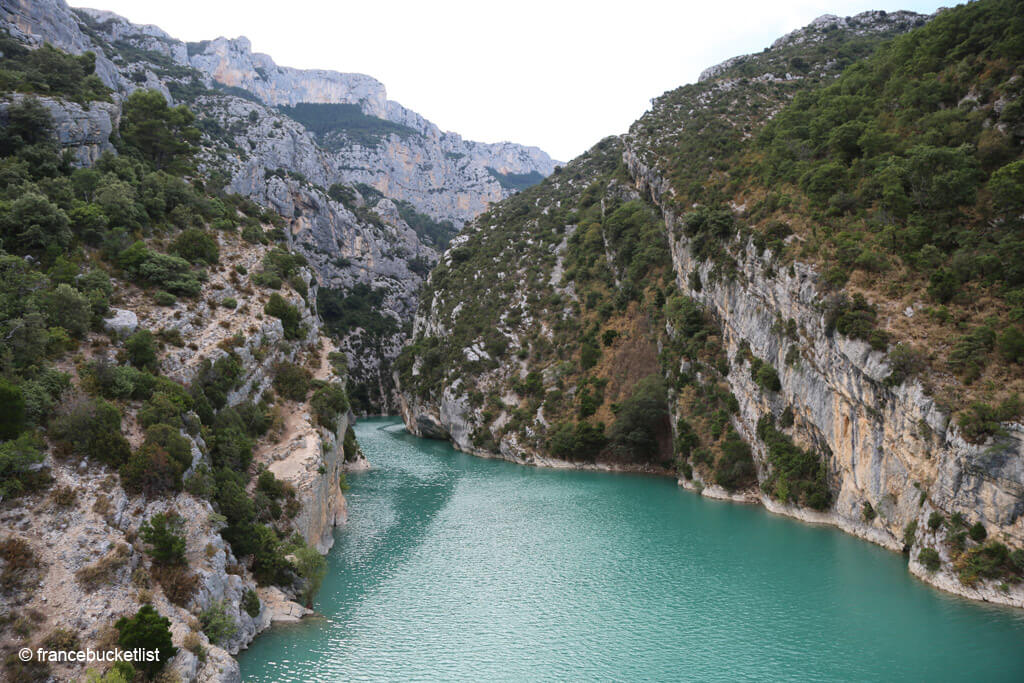
Gorges du Verdon is the best place to visit in Provence for a relaxing day trip out of Aix-en-Provence or Nice. Located in the beautiful Verdon Regional Park , Gorges du Verdon is one of the largest canyons in Europe and reaches a depth of more than 700 meters.
The water in the gorge is a stunning bright turquoise color, and you can see the gorge from your car or take a boat /kayak and stop for dips in the water as you go. This natural landscape is also famous for its hiking and climbing routes, so it’s ideal for an active vacation.
The best way to explore this area is by car (check out this Gorges du Verdon road trip itinerary ). If you don’t have a car, you can join a Gorges du Verdon guided tour from Nice , and there are also guided tours from Aix-en-Provence .
Roman Provence
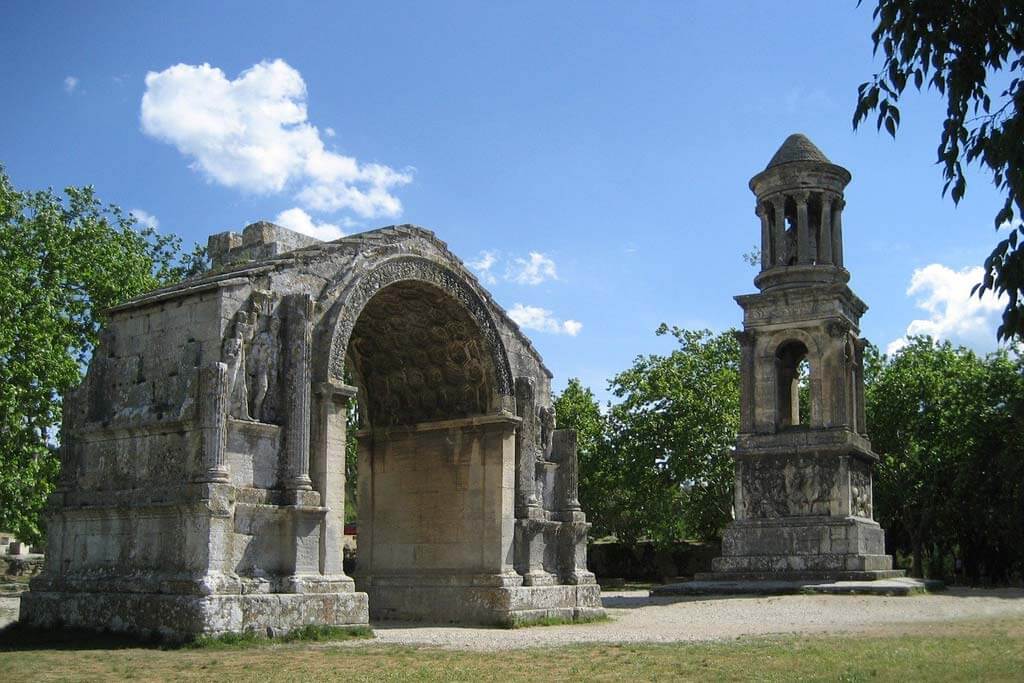
Provence is a region whose culture and charm has been influenced by thousands of years of history. Provence sounds like “province”. That’s because it was the first Roman province outside of what is now Italy, and the Romans called it “Provencia Romana.”
Under the Roman administration, the region’s economic and artistic life flourished. The towns of Orange, Arles, Nimes, Orange, Vaison la Romaine , and Fréjus are the best places in Provence, France, to see Roman vestiges in the region, like magnificent remains of arenas, amphitheaters, spas, and villas.
Also, don’t miss a visit (or a kayak tour!) to the Roman Aqueduct of Gard and the visit to Glanum , the most complete ancient archeological complex in France located outside Saint-Rémy.
TIP: This Roman Provence history tour from Avignon is ideal for history lovers.
Back to Homepage
Disclaimer: This article may contain compensated links, meaning we get a small commission if you make a purchase through our links. It costs you nothing more (in fact, if anything, you’ll get a nice discount) but helps us to go on creating incredible French content for you. We trust all products and brands promoted here and would never recommend anything that isn’t of value. Please read disclaimer for more info.
(C) Copyright 2019 - 2024 France Bucket List. All Rights Reserved. Designed & Developed by France Bucket List || Disclaimer || Privacy Policy || Contact |
Change location
- UK / International
- Call toll-free from 10am EDT 617-223-4521 617-223-4762 or
- REQUEST A QUOTE
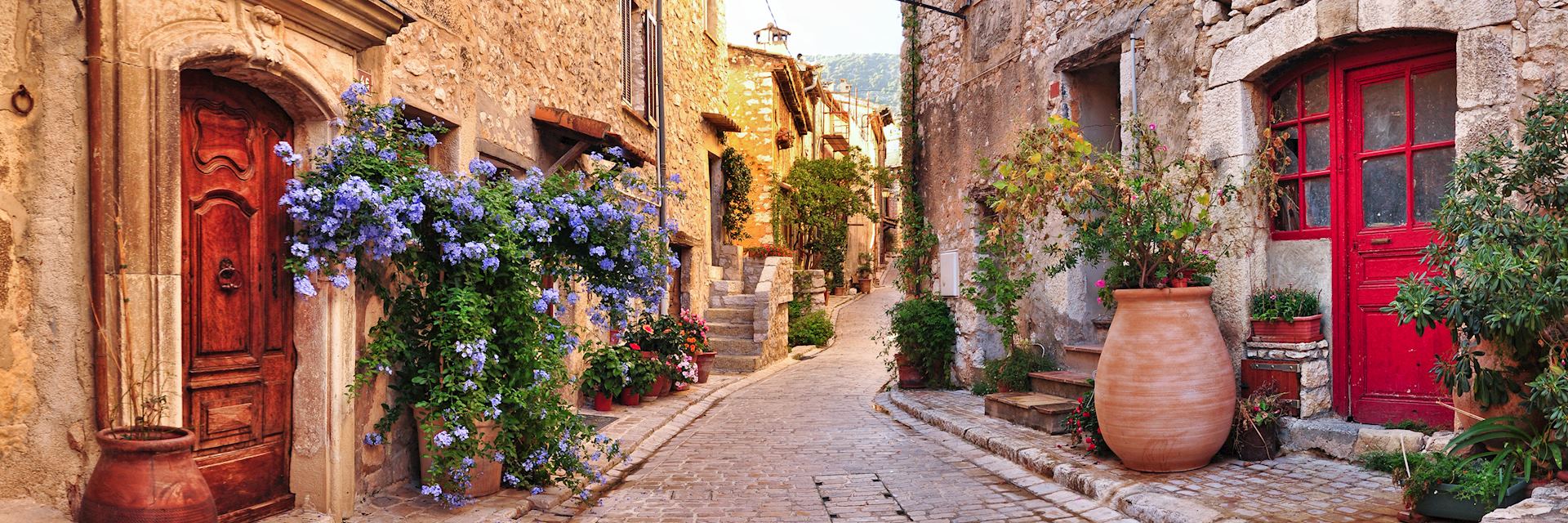
Luxury Provence & the French Riviera
13 days from $20,295pp
- Day-to-day Itinerary
- France trip ideas
Tour highlights
Hunt for truffles with a local expert and trained dog before enjoying a four-course gourmet meal in Ménerbes.
Sample some of France’s best-known wine appellations at Châteauneuf-du-Pape.
Explore the Roman and medieval heritage of Pont-du-Gard, Uzès and Arles with a guide.
Walk the streets of Monaco, Monte Carlo and Èze.
Relax and enjoy coastal views over a glass of champagne on a private sunset cruise.
Price includes:
- In-destination transfers
- Activities and excursions as detailed
- All accommodations
- 24-hour support while you travel
Itinerary idea in detail
Ask us if you would also like us to arrange your international flights at our preferred rates.
Upon arrival at Marseille Provence Airport, you're met by your private driver and driven to your hotel in Gordes. One of Provence's best-known villages, it faces the Lubéron Valley. Enjoy this afternoon at leisure to acquaint yourself with your hotel and the winding cobbled streets of this medieval town, often referred to as the 'jewel of Provence'.
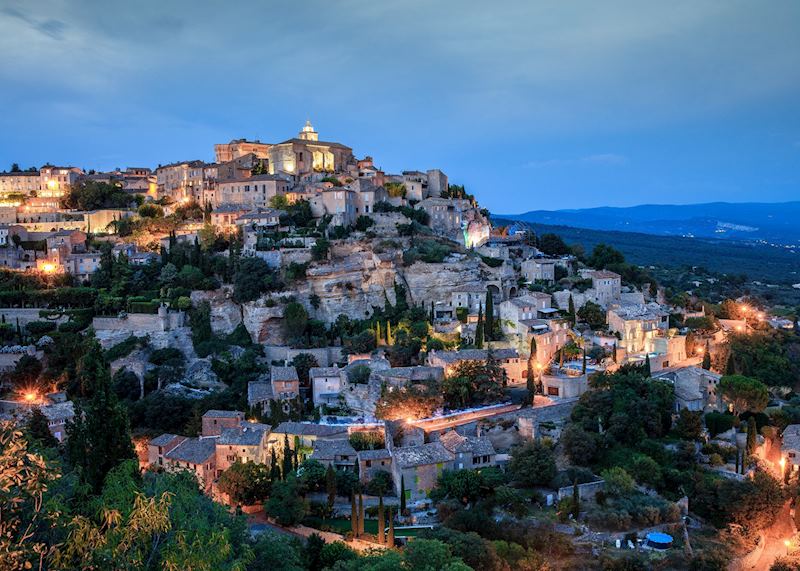
Your private driver will pick you up this morning for a tour and tasting at a local olive oil mill in the heart of the Lubéron Valley. From here, you're driven to meet a local truffle-hunting expert, Robert, and his trained dog, Kita, joining them on a traditional truffle hunt through the valleys and woods of Provence. Afterwards, you will journey to the village of Ménerbes to enjoy a truffle lunch before returning to your hotel, where you will have the rest of the afternoon at leisure. We recommend taking a swim, relaxing in the spa, or just enjoying the commanding views from the hotel's gardens.
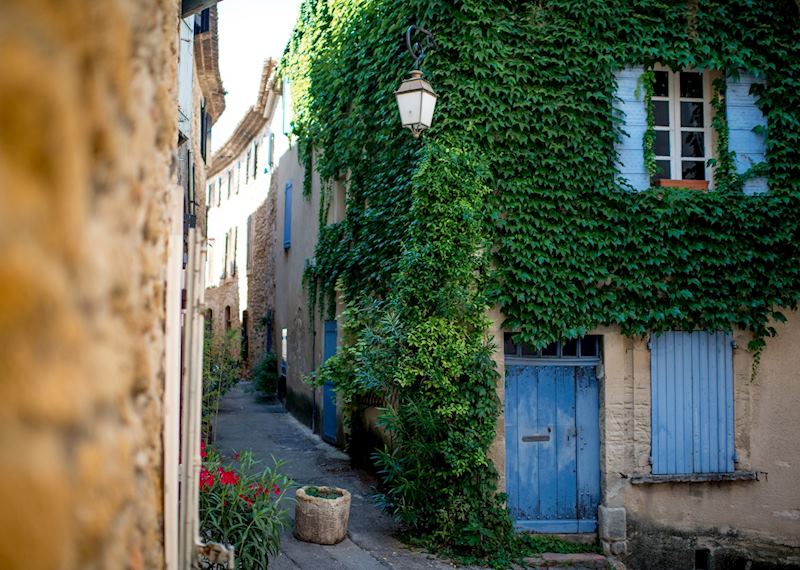
This morning, your private driver takes you out to explore the beautiful Lubéron National Park and its many medieval villages, fields of lavender, and vivid sunflower meadows. Immerse yourself in a culture where locals have mastered the slow pace of life while visiting the canal village of Isle-sur-la-Sorgue, the medieval Abbaye de Sénanque, and the ocher quarries of Roussillon, among other sites.
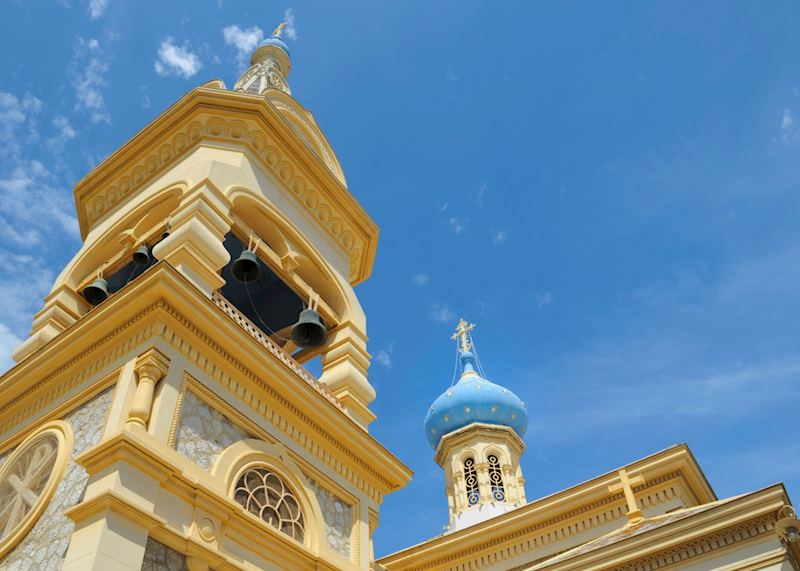
After checking out of your hotel in Gordes, you're driven to the Châteauneuf-du-Pape wine region. Named after the Pope's summer residence during the 14th century, this region is internationally renowned as one of the highest-quality wine-producing areas of France. With a small group and guide, you journey to the heart of the vineyards to gain an in-depth understanding of the land and agriculture. While here, enjoy a few tastings with some of the local producers. Your driver-guide will then bring you to your hotel in Avignon's old town with views of the colossal Palais des Papes (Papal Palace).
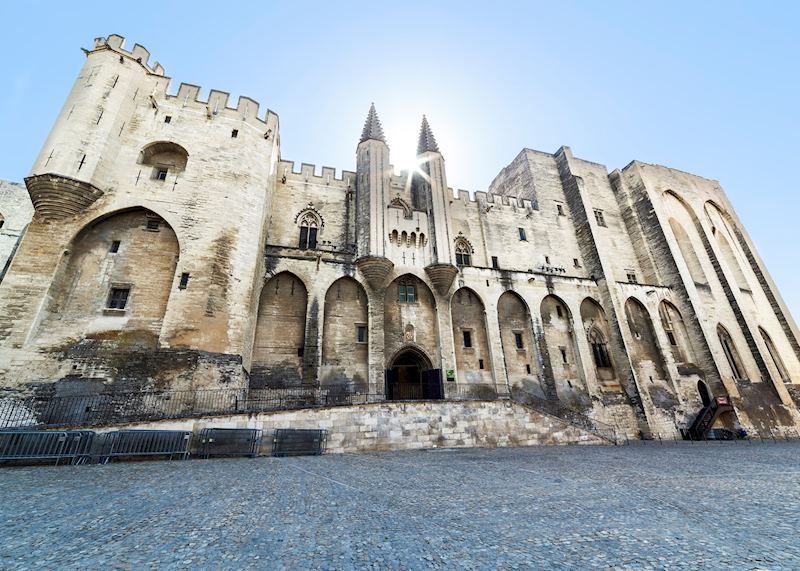
You'll be met by your driver this morning and head into Provence for a Roman and medieval heritage tour. Starting with a visit to Arles, you visit a remarkable Roman amphitheater, still in use today, before exploring the city and a café that inspired artist Vincent van Gogh. Following a drive through the narrow, winding countryside, you arrive in the authentic hilltop village of Uzès. Have lunch here before exploring the village's historic square, browsing its boutiques and taking in panoramic views of the Provençal landscape. Finally, you visit the largely intact Pont du Gard, a Roman aqueduct used to connect Arles to the town of Nîmes, before returning to your hotel.
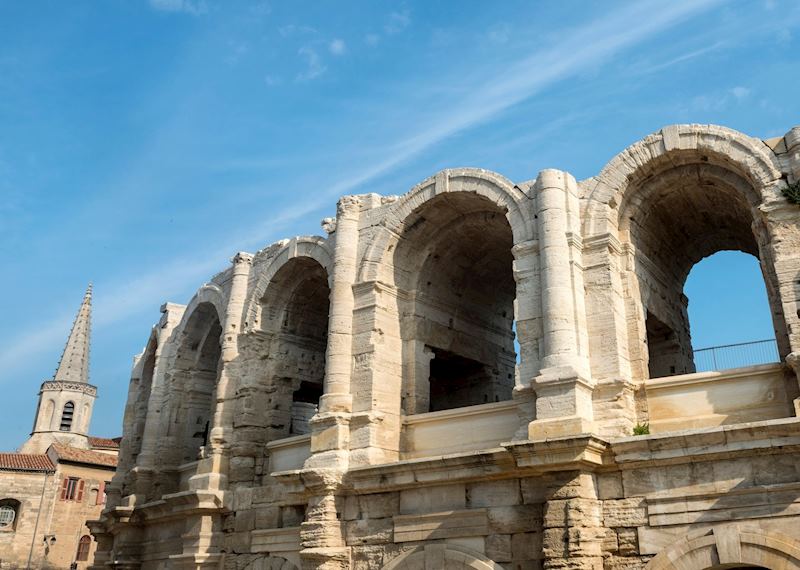
Today's private outing brings you south of Avignon to the picturesque mountain villages of Les Alpilles. You stop in towns such as Les Baux-de-Provence and Saint-Rémy-de-Provence to take in views of the sprawling landscape and stroll the medieval streets, pausing to enjoy lunch and do a bit of boutique shopping. You'll also visit the Carrières de Lumières (Quarry of Light), the Roman ruins of Glanum and the nearby monastery, Saint-Paul de Mausole, where Vincent van Gogh lived for a year in 1889.
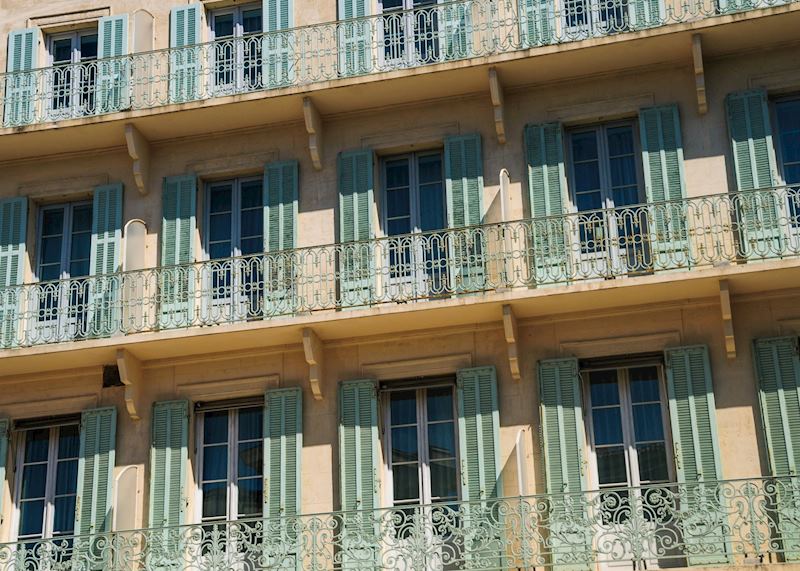
Today, your private driver escorts you to Avignon's train station, where you board your train to Nice. Another private driver will meet you at Nice's train station and drive you to your hotel in Saint-Tropez. Situated on the French Riviera, the coastal town boasts views over the turquoise waters of the Mediterranean Sea.

Spend the day at leisure, perhaps taking time to enjoy your hotel's facilities or venturing out to take in Saint-Tropez's sights. You may want to take a stroll downtown to visit streets lined with designer boutiques or relax on the white sands of Pampelonne Beach.
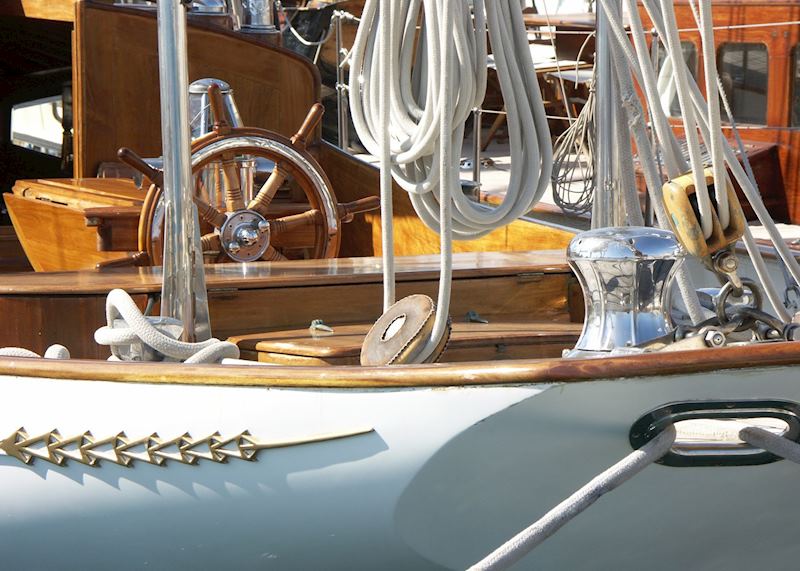
After checking out of your hotel, you're picked up by your driver and driven to meet your private boat for your journey to Nice. Arriving in Nice, you're met by another driver for a private tour of Monaco, Monte Carlo and Èze. Your guide will introduce you to the second-smallest country in the world, Monaco, and walk you through its lavish Monte Carlo Casino. The tour concludes at the hilltop town of Èze, where you check in to your hotel.
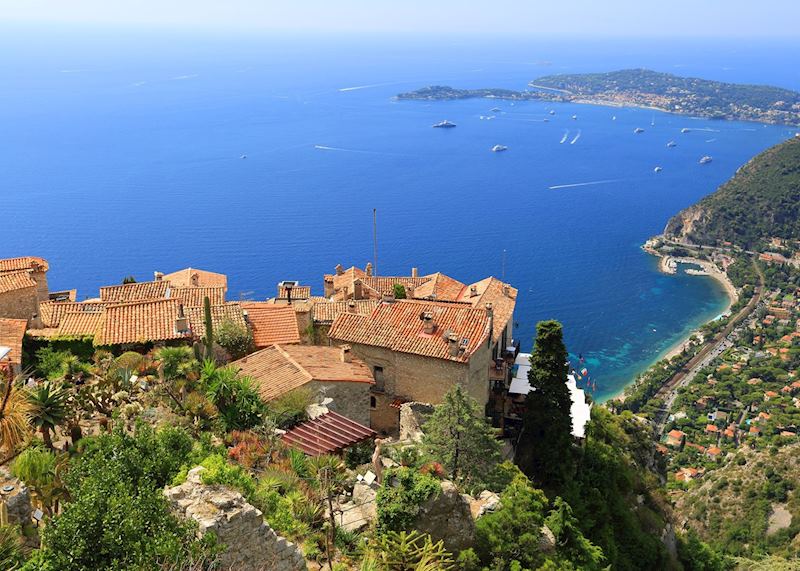
Enjoy the day at your own leisure, acquainting yourself with your hotel and the town of Èze with its Mediterranean seascape and tranquil gardens.
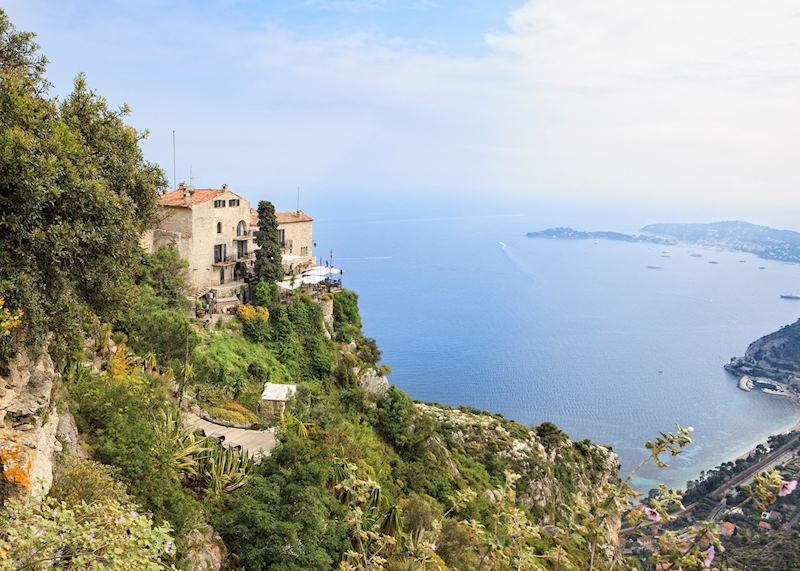
Departing from your hotel this morning, you'll travel with your driver to the small seaside town of Villefranche-sur-Mer. Take some free time to explore this fortified town, wandering its streets and soaking up the sea views. Re-join your driver and venture toward the peninsula of Saint-Jean-Cap-Ferrat, home to the Villa Ephrussi de Rothschild. Here, you can wander through the historic home and gardens to discover tapestries, frescoes, exotic plants and magnificent fountains. Before heading back to your hotel, stop at the beautiful Paloma Beach for a dip in the Mediterranean Sea.
Saying goodbye to the coastline for the day, you head west with your private driver for a visit to Grasse, where you can take a tour of the world-renowned Fragonard Perfumery. The short tour ends in a gift shop, where you can smell and test out perfumes covering a wide range of scents. Next, visit Tourrettes-sur-Loup and stroll through its narrow, cobbled streets before heading farther west to explore the medieval streets and art galleries of Saint-Paul-de-Vence. Later in the evening, you meet your yacht captain at the Port of Nice and board a private yacht for a sunset cruise.
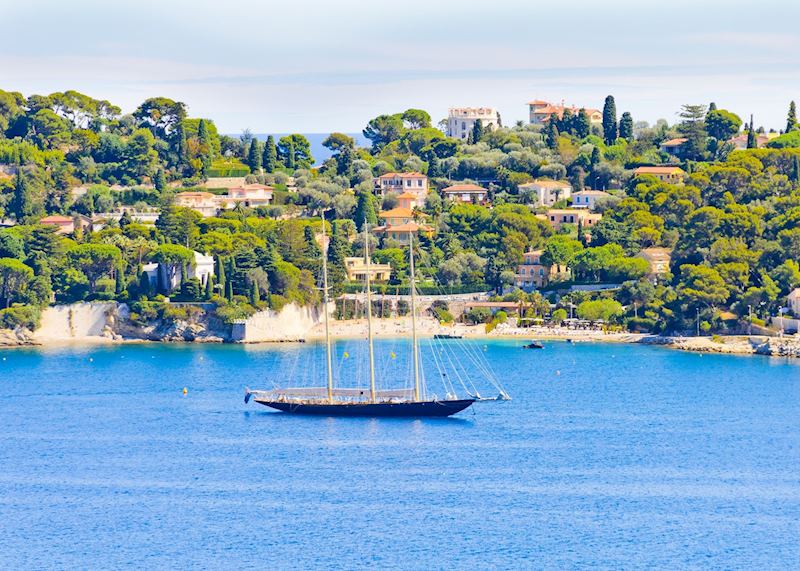
Today your private driver escorts you to Nice Airport for your onward flight.

Accommodation options
While the itinerary price reflects the suggested accommodations, Audley trips are 100% tailor-made, and a specialist can help you select the option best suited to your tastes and budget.
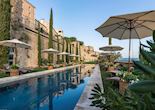
La Bastide de Gordes

Mas de la Clairière
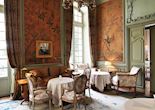
Hôtel de l’Atelier

La Réserve Ramatuelle
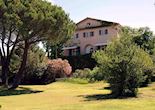
Mas de Chastelas
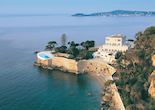
Château de la Chèvre d'Or
- Provence Luberon
- Provence North
- Provence Alpilles
- Saint-Tropez
- Riviera East
- Riviera Central

The specialist who designs your trip to France will have explored the country many times and, in some cases, lived there. Their first-hand knowledge gives us the belief that no other travel company can match our expertise in helping you plan your trip.

Watch our tailor-made process
Other tours you may be interested in.
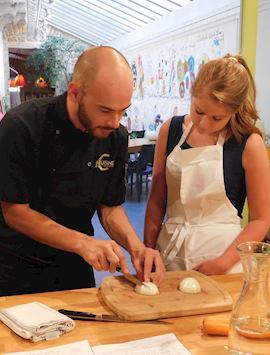
Best of culinary Italy & France
9 days from $12,795pp
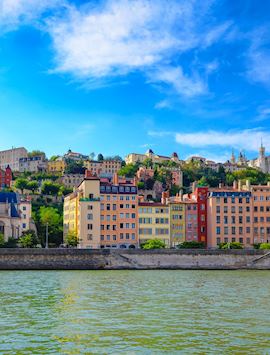
Rhône river cruise: Roman ruins & truffles
13 days from $17,595pp
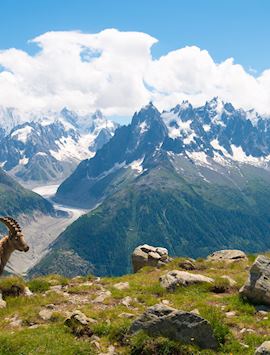
The Rhône-Alpes in depth
11 days from $8,195pp
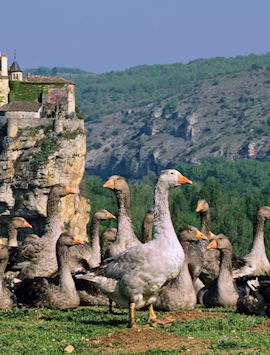
Highlights of Bordeaux & the Dordogne
10 days from $5,695pp
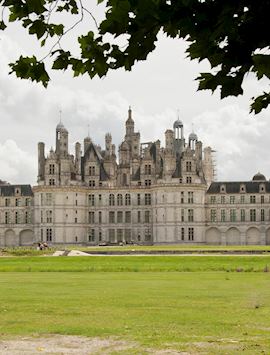
An introduction to French wine
10 days from $9,595pp
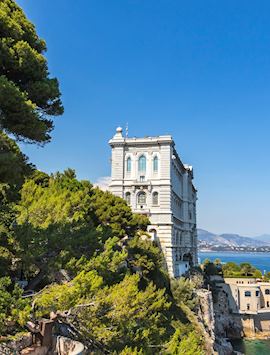
French & Italian Riviera
7 days from $8,795pp

A family journey through Paris & the French Alps
9 days from $4,930pp
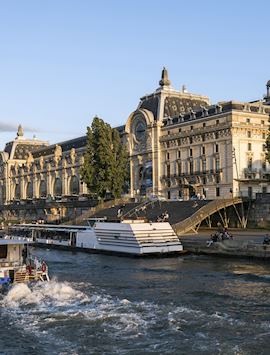
Introduction to French art & architecture
11 days from $7,995pp

Classic Paris & the Normandy D-Day beaches
9 days from $6,995pp
Oshkosh native living in Paris shares charms of Southern France in new cookbook, culinary tour

While studying at the University of Wisconsin-Oshkosh, Rebekah Peppler got just the right push to follow her dreams. It took just one professor's confidence in her.
Today the Oshkosh native lives in Paris and leads culinary tours in France. She’s carved out a career path traveling the globe writing about food, wine and cocktails. Yet no matter where she goes, her favorite cheese will always be Wisconsin cheddar.
Peppler, whose newest cookbook is her third written in France, is part of a small group of American expats who have built followings sharing their love of French cooking and culture, including Dorie Greenspan, David Lebovitz and Milwaukee native Patricia Wells .
Delving into the food, drinks and places that inspire her love of the south of France, Peppler’s new cookbook, in stores April 23, is “Le Sud: Recipes from Provence-Alpes-Cote d’Azur” (Chronicle Books), with photos by Joann Pai. A travelogue of taste, “Le Sud” offers a slice of time and place with recipes.
Her previous books include “Aperitif: Cocktail Hour the Frency Way” (Clarkson Potter), which was a 2019 James Beard Foundation Book Award nominee, and “A Table: Recipes for Cooking and Eating the French Way” (Chronicle Books).
Peppler tries to get back to her hometown once a year to see her mother, a librarian. Between stops in New York, Toronto, San Francisco, Chicago and Seattle, she will bring her book tour to Elsewhere Market & Coffee House , 531 N. Main St., Oshkosh at 6 p.m. May 22.
Working with Modern Adventure, she will also be leading a trip to Provence, France, Sept. 11-17. See rebekahpeppler.com or modernadventure.com for additional details.
Peppler recently talked with the Journal Sentinel about her journey to living in France and her newest cookbook.
Making her way from Oshkosh to Paris
I grew up in Oshkosh. I was born there, studied at UW-Oshkosh, got my bachelor's in journalism news editorial with minors in art history and English. One of the reasons I wanted to stay close to home was so I could study abroad. I actually studied in England and Italy. That sparked my idea that I could live further afield later in life.
When I graduated I decided to go to New York and culinary school. It is ICC, the International Culinary Center , now. When I was there it was based in Soho, The French Culinary Institute. I got my degree in classic pastry arts. When I was thinking about what I wanted to do it was between that program and a similar one in Paris. I decided to move to New York first, started working as a food stylist, and spent nearing 10 years in New York doing that, but itching to do more writing. I had my feet firmly planted in the styling world, but always wanted to write and write cookbooks.
I never had a fantasy of living in France before I moved here, but I always wanted to live abroad and immerse myself in another culture and language. I started splitting my time between New York and Paris. Then it slowly became just Paris. I spend a lot of time in the U.S. for work, but my full-time life — and all my shoes and books — are in Paris.
This expat’s first international trip didn’t happen until after high school
I went to Italy for the first time as my high school graduation present. I think I surprised my parents by choosing an international spot.
The power of positive people
Dorie Greenspan specifically has long been a figure in my personal life. She is a dear human. She was one of the first people that planted the seed in my mind that I could move to France. I just asked her to coffee, and then asked, “What is it like to live (in France) as an American, and how do you split your time?” She was unequivocally, “Do it, just try it and see." Her confidence in my ability to take that leap was formative.
What makes 'Le Sud' her most personal book
My interest in writing cookbooks stems from my interest in writing about food, but I’m not interested in banging out recipes and putting them in a book and putting pretty pictures in it. I’m more interested in telling stories and a narrative-driven book. That is what I strive for, and across the three books it started that way and leaned harder and harder. I think “Le Sud” is my most personal book.
I weave in a lot of my life, as well as telling the story of the region and expanding the story outside the beautiful Mediterranean seasons, produce and lavender fields, which Provence has in spades. It also has all these other parts: rivers marshes, rice, beaches, hillsides, wines that aren’t just rosés that are really phenomenal but can be overlooked because we think of Provence and we think rosé. You have the Italian border and its influence. I wanted to learn about that more and transcribe that on the page, but also in a way that felt personal to me, and fun, hopefully funny at points.
How Julia Child’s former home became part of her book
I spent a month there, writing and living in the house. I lived in the house and cooked in the house and wrote in the house. I brought my photographer. ... I also brought my partner, Laila (Said). It felt special to wake up and make my coffee in Julia’s kitchen with the pegboard and watch the sunrise and have these surreal moments alongside real life.
I had to eat dinner and work, connect with my spouse. There are all these things alongside the fantasy you walk into. That’s one of the things that is a bigger theme in my work in France, to separate the fantasy and the fantastic, what is real, and what can be fantastic about this fantasy, but doesn’t have to lean on the fantasy trope. I feel very privileged to live there for a month and use all the tools and develop and shoot recipes.
These are her travel essentials
I’m always bringing back kitchen supplies! I bring a lot of salt and coffee. We were just in Japan. I brought back a copper omelet maker and some really gorgeous graters and salts.
When I do a book tour or work travel, moving between different spaces and trying to create a sense of home, I try to be in a place that has a bathtub. Water really grounds me, and I travel with bath salts.
Who she looks to for inspiration
Melissa Clark has long been both inspiration and mentor for me. She has been such a champion of my work, which has felt like a big honor to me. Dorie Greenspan, the same. Sometimes there is this idea there is not enough to go around. I have found I have been welcomed and offered a lot of support. That is something I have never taken for granted.
There are other writers who don’t write about food who I reach for, like Alexander Chee. He makes it look easy, but it is powerful.
What she’s doing next
I have a tour with Modern Adventure (to Provence) in the fall. There are still seats. So if anyone from Wisconsin wants to join us, I would love it. The trip is inspired by the book.
What this Wisconsin native misses most from home
I still crave Wisconsin cheddar. It is one of my favorites in the world. The kind of cheddar we get in Europe is mostly English. There is nothing wrong with it. It is very good. I eat it when I can’t get my hands on Wisconsin cheddar. But there is such a flavor profile I haven’t been able to replicate in Europe. I used to bring blocks of cheddar back to New York. Also, heads up: If you travel with cheddar, take it out of your carry-on, because it gets flagged.
We’ll be stopping in Oshkosh right after Chicago (on this tour). I’m very excited. My first meal will include cheddar, and probably a brat on the grill and a seven layer salad. That is still one of my favorite things, and outside of Wisconsin no one knows what seven layer salad is! My mom makes it in a very specific way I love.
How Wisconsin plays a role in her success
It goes back to when I studied at UW-Oshkosh. I studied under an incredible teacher, Grace Lim. She still teaches. I’ll be in contact with her at the (May) event at Elsewhere (Marketplace & Coffee House). She’ll be moderating. She was very formative in starting my confidence in my writing, and also my confidence in being able to do it wherever I want. Educators can play such a huge role in pulling out the dreams of young people, laying them out in front of them and giving them the options.

IMAGES
VIDEO
COMMENTS
Provençal pleasures: Exploring the gastronomy, cultural spaces and sun-soaked beauty of Arles and Avignon.Grab the embed code for this video at Times Video: ...
Welcome to our ultimate travel guide to Provence, France! In this video, we will explore the top attractions and activities that this beautiful region has to...
Discover the best villages to visit in Provence, France. Take a journey through 7 of the most charming villages of Provence in France and explore the picture...
Video: Watch Provence: Legendary Light, Wind, and Wine - an episode of the Rick Steves' Europe TV show. Travel with Rick on this video guide to Provence, France and find out what to do on your next trip. In this program, we climb Roman ruins in Nîmes, explore a papal palace in Avignon, and savor vivid views immortalized by Van Gogh in Arles ...
Provence. This magnificent region is shaped like a giant wedge of quiche. From its sunburned crust, fanning out along the Mediterranean coast from the Camargue to Marseille, it stretches north along the Rhône Valley to Orange. The Romans were here in force and left lots of ruins — some of the best anywhere. Seven popes, artists such as ...
While you can explore some of Provence's towns and cities, such as Aix-en-Provence, in just 1-3 days, the best way to see this varied region is by taking 5-7 days to discover more of the natural beauty and hidden villages. With 5 days in Provence, you can explore some of the region's main attractions, tour the famous lavender fields and ...
In this travel class, Rick Steves guidebook co-author Steve Smith describes Provence, with its romantic hill towns, dynamic cities, and Roman ruins; and the French Riviera, with bustling Nice, world-class modern art, fine beaches, scenic drives, and glitzy Monaco. Start planning your trip to France! Watch more chapters about France:
More about: The lavender village Valensole in Provence. 2. Oppede. Oppede is straight from the pages of a storybook with its tiny cottages, painted shutters, and narrow lanes. The hilltop village is home to 15th-century stone houses, beautiful vineyards, and amazing views of the lavender fields.
Provence, France, known for its diverse landscapes, miles of vineyards, lavender fields, and crystal blue waters, is indeed a traveler's dream.I recently got to visit, and it was everything that I hoped for and more. If you have the opportunity to spend 3-5 days exploring Provence I highly recommend doing so.
Weather and Climate. Provence typically has dry summers and cool, wet winters. May, June, and September are good months to travel to Provence. France's second largest city is hot in June and July but cools rapidly to a comfortable high temperature in September. Spring has less rain than fall.
4. Relax at the foot or climb the top of Montagne Sainte-Victoire. Montagne Sainte-Victoire, a limestone mountain ridge in Vauvenargues, between Var and Bouches-du-Rhône, is famed for its many appearances in Paul Cézanne's paintings. Saint-Victoire is a popular destination for hiking, climbing, paragliding, and caving.
10 Beautiful Towns to Visit in France 4k. Its time for you all to check out some really interesting medieval villages in France. Some of the best towns to vi...
13 Amazing Things to Do in Provence, France. 1. Hill Towns Of The Luberon. Corentin / Shutterstock. The hills towns of the Luberon are the perfect place to fall for Provence, France. The Luberon consists of three mountain ranges, and located in the valleys, plateaus, and hilltops are marvelous, unspoiled medieval villages.
Tags. Provence, the region in France, is famous for blossoming lavender fields and ripe olive groves highlighting medieval hilltop villages set a picture-perfect scene. Towns like Cassis, Les Baux ...
The entire circuit being 130km long, this is cyclingcountry only for the preternaturally fit. Local outfitters and guides offer activitiesincluding climbing, rafting, canoeing, canyoning, cycling and horseriding. Northeast Provence. Depending on the season, the northeastern corner of Provencecan be two different worlds.
The Romans perfumed their linen with lavender grown here thousands of years ago—the spiky purple flowers flourish on this territory from the Drôme to the Alpes-Maritimes, via the Hautes-Alpes, Vaucluse and the Alpes de Haute-Provence. Several routes run through the fields, following the blooms, between mid-June and the end of August.
Living Well and Looking Good in Aix-en-Provence. Experience the French good life in Aix-en-Provence: Stroll the Cours Mirabeau, spend the afternoon people-watching from an outdoor café, join a friendly game of boules, and taste the local goat cheese at the farmers market. Watch the full episode: Provence: Legendary Light, Wind, and Wine.
Aix-en-Provence is located around 450 miles south of Paris, i.e. a 7.5-hour drive. For a quicker trip, you can opt to take the three-hour direct train from Paris Gare de Lyon to the high-speed train station of Aix-en-Provence. The high-speed train station is 11 miles out of the city center of Aix-en-Provence. If you'd rather arrive right in ...
Travel video about destination Provence in France.PLANET TERRA takes you to each corner of the planet and helps you to discover the world with fascinating de...
Gordes Castle (Le Château du Gordes) is one of the most impressive buildings in Gordes. It's approximately 1000 years old and is one of the oldest castles in France! Now, the castle is home to exhibitions by local artists. Seeing art surrounded by the Renaissance and Middle Ages influences of the building is spectacular.
Under the Roman administration, the region's economic and artistic life flourished. The towns of Orange, Arles, Nimes, Orange, Vaison la Romaine, and Fréjus are the best places in Provence, France, to see Roman vestiges in the region, like magnificent remains of arenas, amphitheaters, spas, and villas. Also, don't miss a visit (or a kayak ...
Travel video about destination Provence.Marseille is the oldest city in France, the country's largest commercial harbour and the capital of Provence, an ench...
Hunt for truffles with a local expert and trained dog before enjoying a four-course gourmet meal in Ménerbes. Sample some of France's best-known wine appellations at Châteauneuf-du-Pape. Explore the Roman and medieval heritage of Pont-du-Gard, Uzès and Arles with a guide. Walk the streets of Monaco, Monte Carlo and Èze.
Delving into the food, drinks and places that inspire her love of the south of France, Peppler's new cookbook, in stores April 23, is "Le Sud: Recipes from Provence-Alpes-Cote d'Azur ...
Travel video about destination Provence in France.Marseille is the most important city in Provence.and is situated on the south coast of France.From a distan...